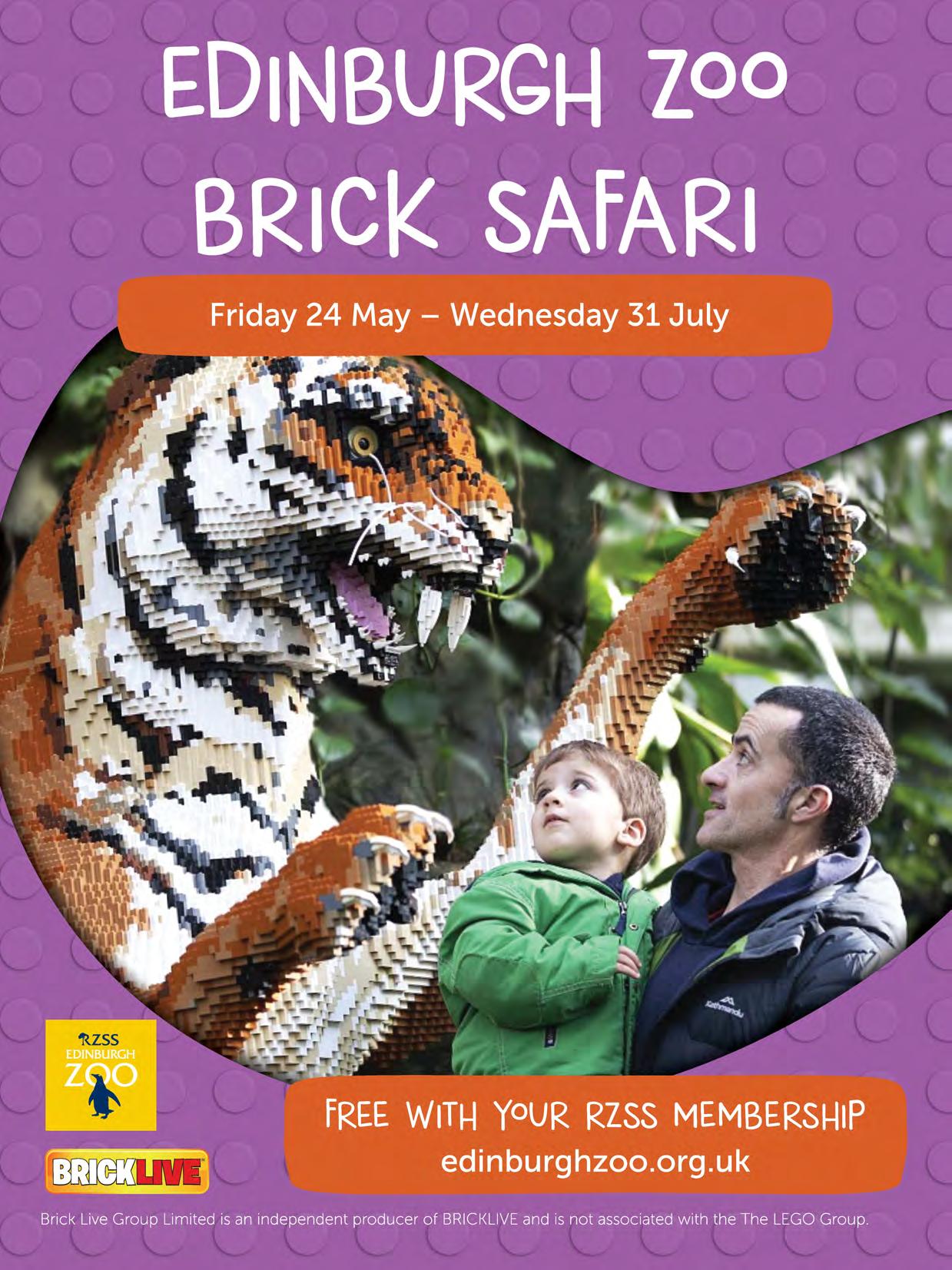BISON_.
ASIATICLIONS
RING-TAILEDLEMURS--.
PALLAS'SCATS
CAMELS_.


0

BISON_.
ASIATICLIONS
RING-TAILEDLEMURS--.
PALLAS'SCATS
CAMELS_.


0
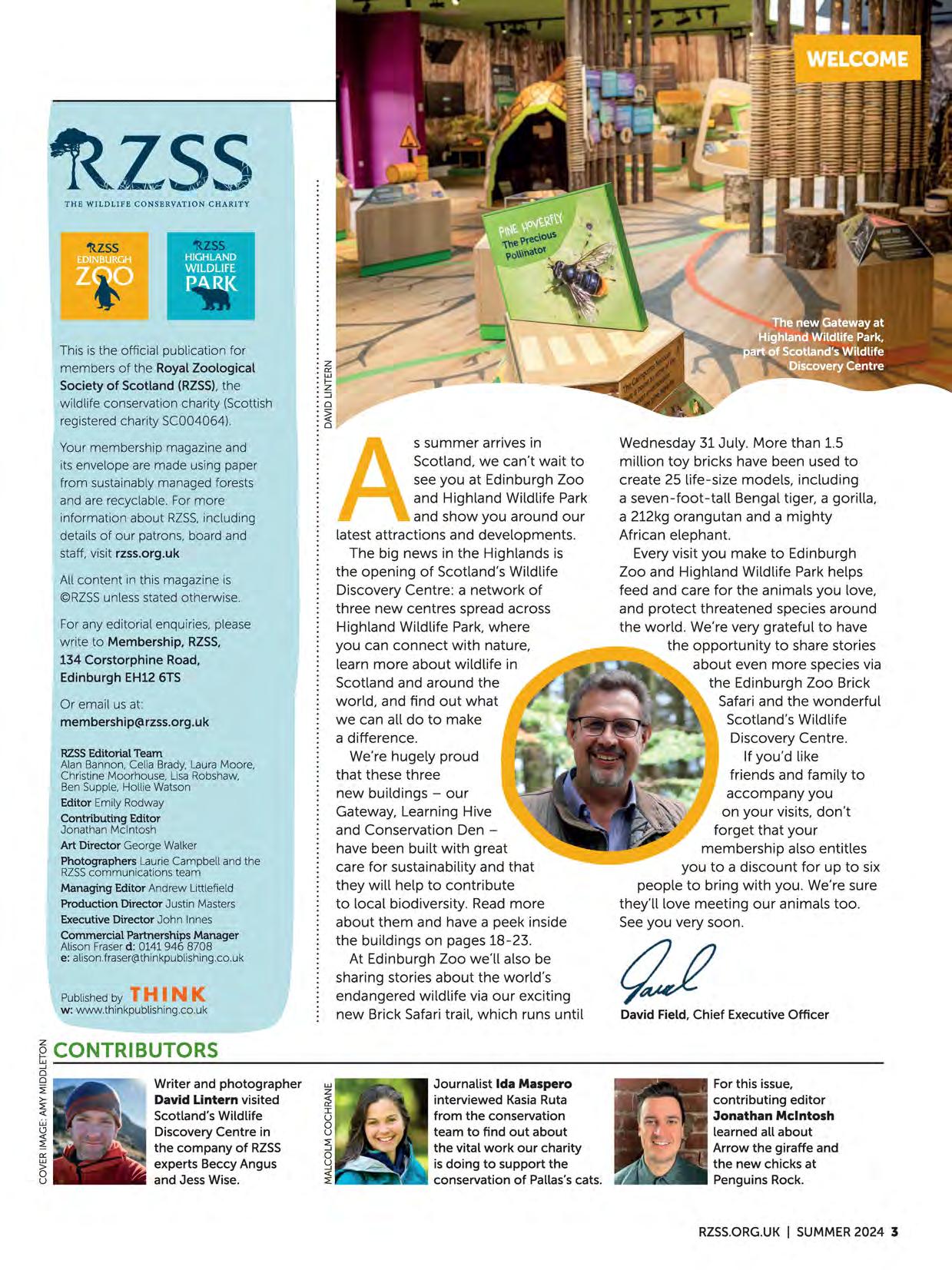
This is the official publication for members of the Royal Zoological Society of Scotland (RZSS),the wildlife conservation charity (Scottish registered charity SC004064)
Your membership magazine and its envelope are made using paper from sustainably managed forests and are recyclable. For more information about RZSS,including details of our patrons. board and staff, visit rzss.org.uk
All content in this magazine is ©RZSS unless stated otherwise.
For any editorial enquiries, please write to Membership, RZSS, 134 Corstorphine Road, Edinburgh EH12 6TS
Or email us at: membership@rzss.org.uk
RZSSEditorial Team
Alan Bannon. Celia Brady, Laura Moore, Christine Moorhouse, Lisa Robshaw, Ben Supple, Hollie Watson
Editor Emily Radway
Contributing Editor Jonathan McIntosh
Art Director George Walker
Photographers Laurie Campbell and the RZSScommunications team
Managing Editor Andrew Littlefield
Production Director Justin Masters
Executive Director John Innes
Commercial Partnerships Manager
Alison Fraser d: 0141 946 8708 e: alison.fraser@thinkpublishing.co.uk
Published by T H I N K w: www.thinkpublishing.co.uk
Writer and photographer David Lintern visited Scotland's Wildlife Discovery Centre in the company of RZSS experts Beccy Angus and Jess Wise.
As summer arrives in Scotland, we can't wait to see you at Edinburgh Zoo and Highland Wildlife Park and show you around our latest attractions and developments.
The big news in the Highlands is the opening of Scotland's Wildlife Discovery Centre: a network of three new centres spread across Highland Wildlife Park, where you can connect with nature, learn more about wildlife in Scotland and around the world, and find out what we can all do to make a difference.
We're hugely proud that these three new buildings -our Gateway, Learning Hive and Conservation Denhave been built with great care for sustainability and that they will help to contribute to local biodiversity. Read more about them and have a peek inside the buildings on pages 18-23.
At Edinburgh Zoo we'll also be sharing stories about the world's endangered wildlife via our exciting new Brick Safari trail, which runs until
Journalist Ida Maspero interviewed Kasia Ruta from the conservation team to find out about the vital work our charity is doing to support the conservation of Pallas's cats.
Wednesday 31 July. More than 1.5 million toy bricks have been used to create 25 life-size models, including a seven-foot-tall Bengal tiger, a gorilla, a 212kg orangutan and a mighty African elephant.
Every visit you make to Edinburgh Zoo and Highland Wildlife Park helps feed and care for the animals you love, and protect threatened species around the world. We're very grateful to have the opportunity to share stories about even more species via the Edinburgh Zoo Brick Safari and the wonderful Scotland's Wildlife Discovery Centre.
If you'd like friends and family to accompany you on your visits, don't forget that your membership also entitles you to a discount for up to six people to bring with you. We're sure they'll love meeting our animals too.
See you very soon.
David Field, Chief Executive OfficerFor this issue, contributing editor Jonathan McIntosh learned all about Arrow the giraffe and the new chicks at Penguins Rock.
Your membership
Enjoygreat daysout at EdinburghZoo and Highland Wildlife Parkas often as you like, plus...
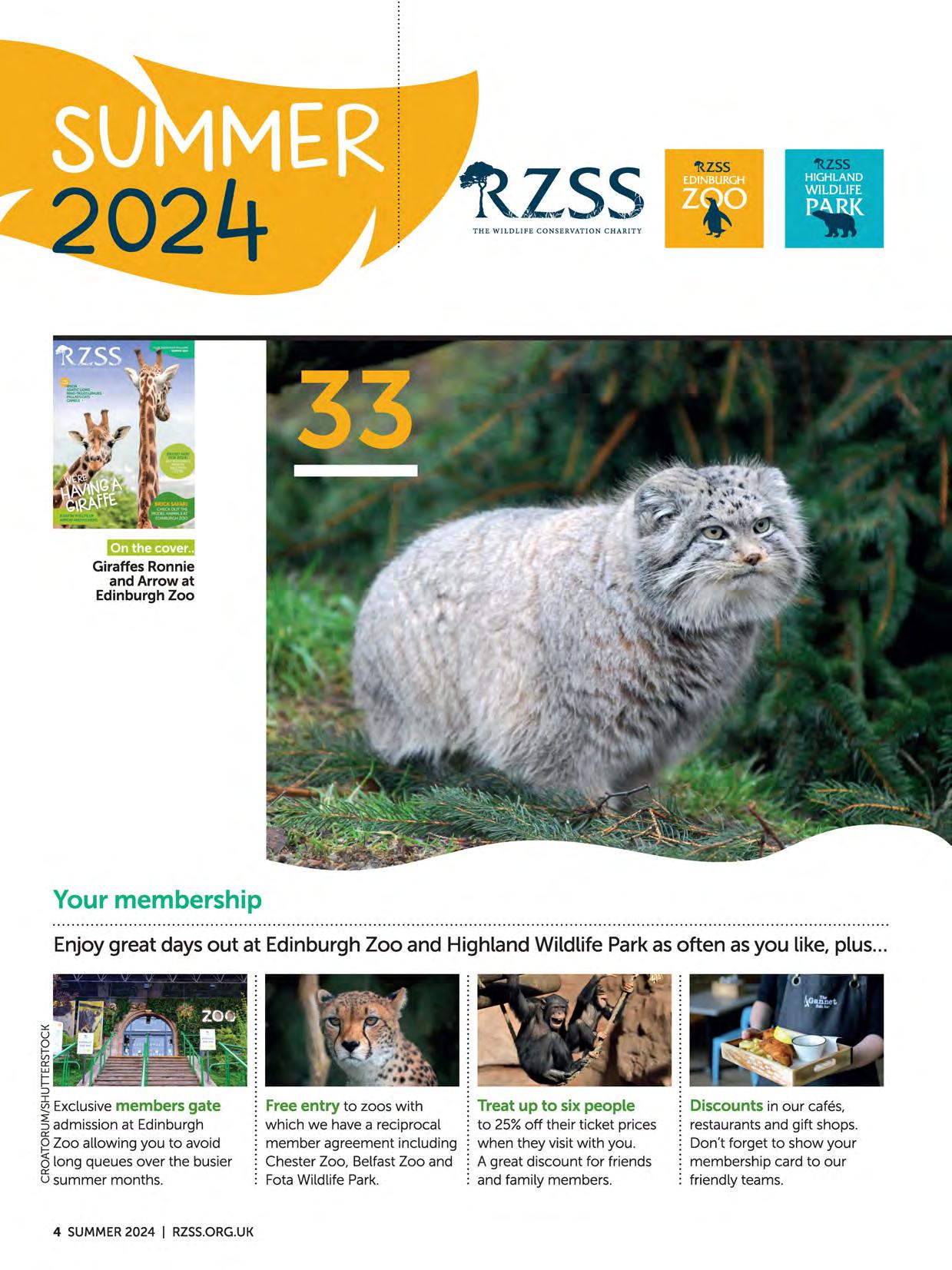
Exclusive members gate admission at Edinburgh
f2Zoo allowing you to avoid c§long queues over the busier
summer months.
Free entry to zoos with which we have a reciprocal member agreement including Chester Zoo, Belfast Zoo and Fata Wildlife Park.
Treat up to six people to 25% off their ticket prices when they visit with you. A great discount for friends and family members.
Discounts in our cafes, restaurants and gift shops. Don't forget to show your membership card to our friendly teams.
Giraffes Ronnie and Arrow at Edinburgh Zoo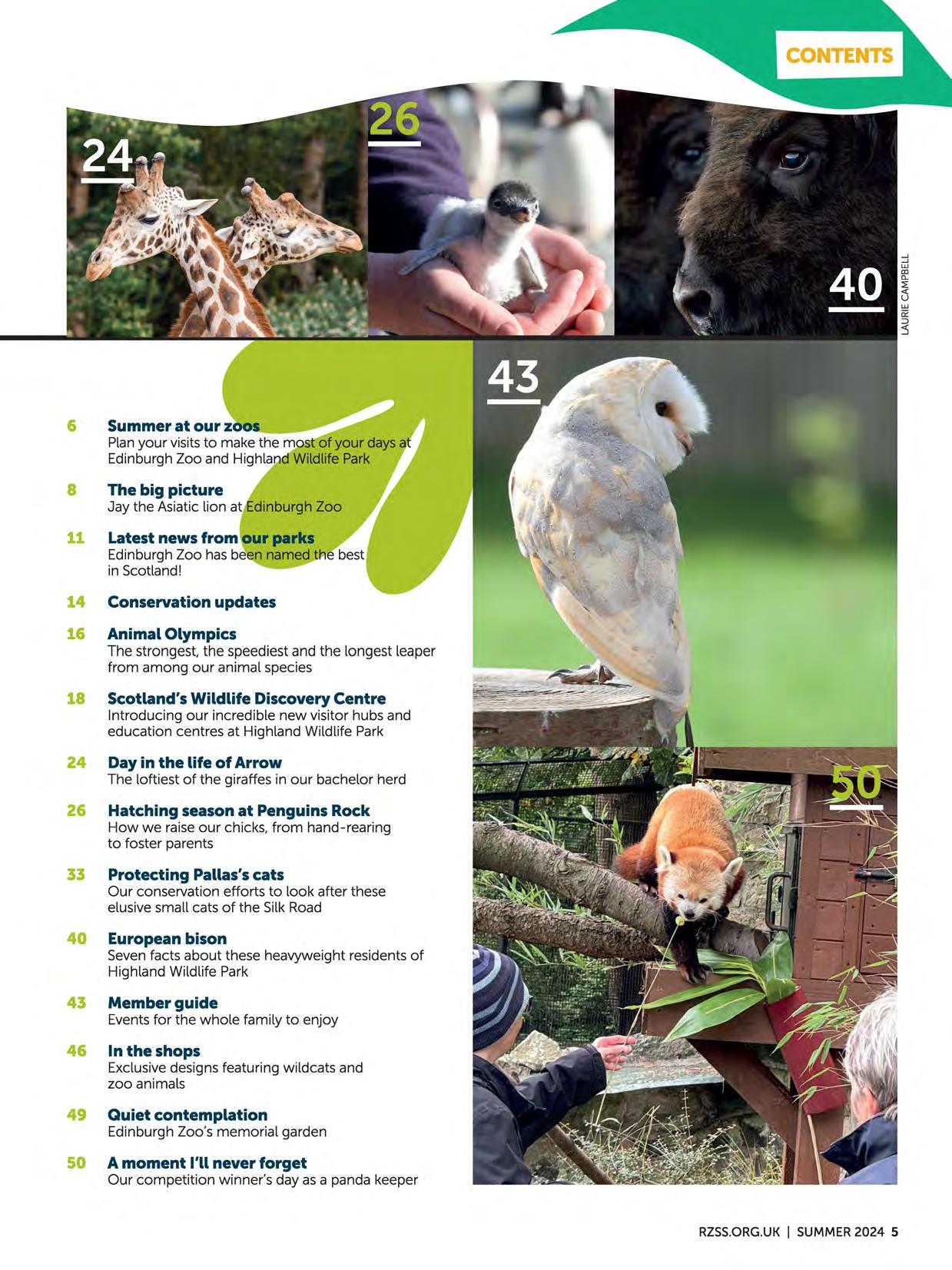
1
Join our summer trail
Brick Safari displays have returned to Edinburgh Zoo this summer! Follow the interactive trail around the zoo to spot some amazing animal sculptures expertly constructed using over one million colourful bricks. They're inspired by our tigers, lions and penguins, as well as other beautiful and endangered animals from around the world.
2
Plan your day out
Plan ahead for your next trips to Edinburgh Zoo or Highland Wildlife Park by going online. Our websites have been given a shiny new makeover and are packed with info on our animals, events to look out for, and tips and tricks on how to make the most of your days out with us. See for yourself at edinburghzoo.org.uk and highlandwildlifepark.org.uk
4
Join our daily talks and shows
Come along on one of our daily keeper-led talks to learn about the work we're doing to protect our amazing animals. Heading to Edinburgh Zoo? Ensure our Animal Antics show is on your itinerary for the chance to see some incredible creatures in action.
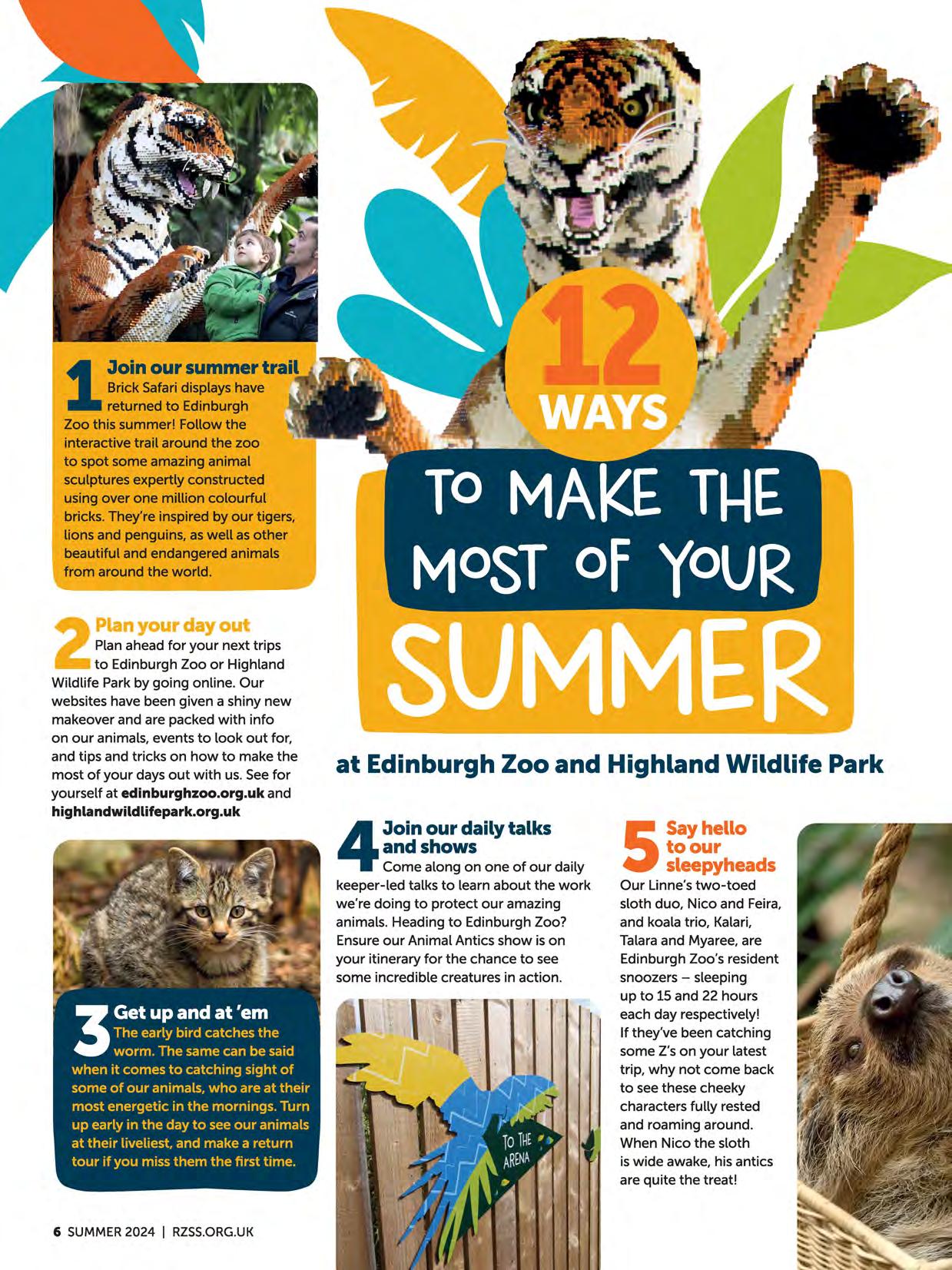
5
Say hello to our sleepyheads
Our Linne's two-toed sloth duo, Nico and Feira, and koala trio, Kalari, Talara and Myaree, are Edinburgh Zoo's resident snoozers -sleeping up to 15 and 22 hours each day respectively! If they've been catching some l's on your latest trip, why not come back to see these cheeky characters fully rested and roaming around. When Nico the sloth is wide awake, his antics are quite the treat!
From free admission for carers, wheelchair-accessible routes and blue badge parking to mobility vehicles and sensory bags designed to make visits more relaxing for children with ASD and ADHD, we're committed to making your trips as accessible as possible. Just tell us what you need and we'll do everything we can to help. Visit edinburghzoo.org.uk/ accessibility highlandwildlifepark.org.uk/visit/ accessibility
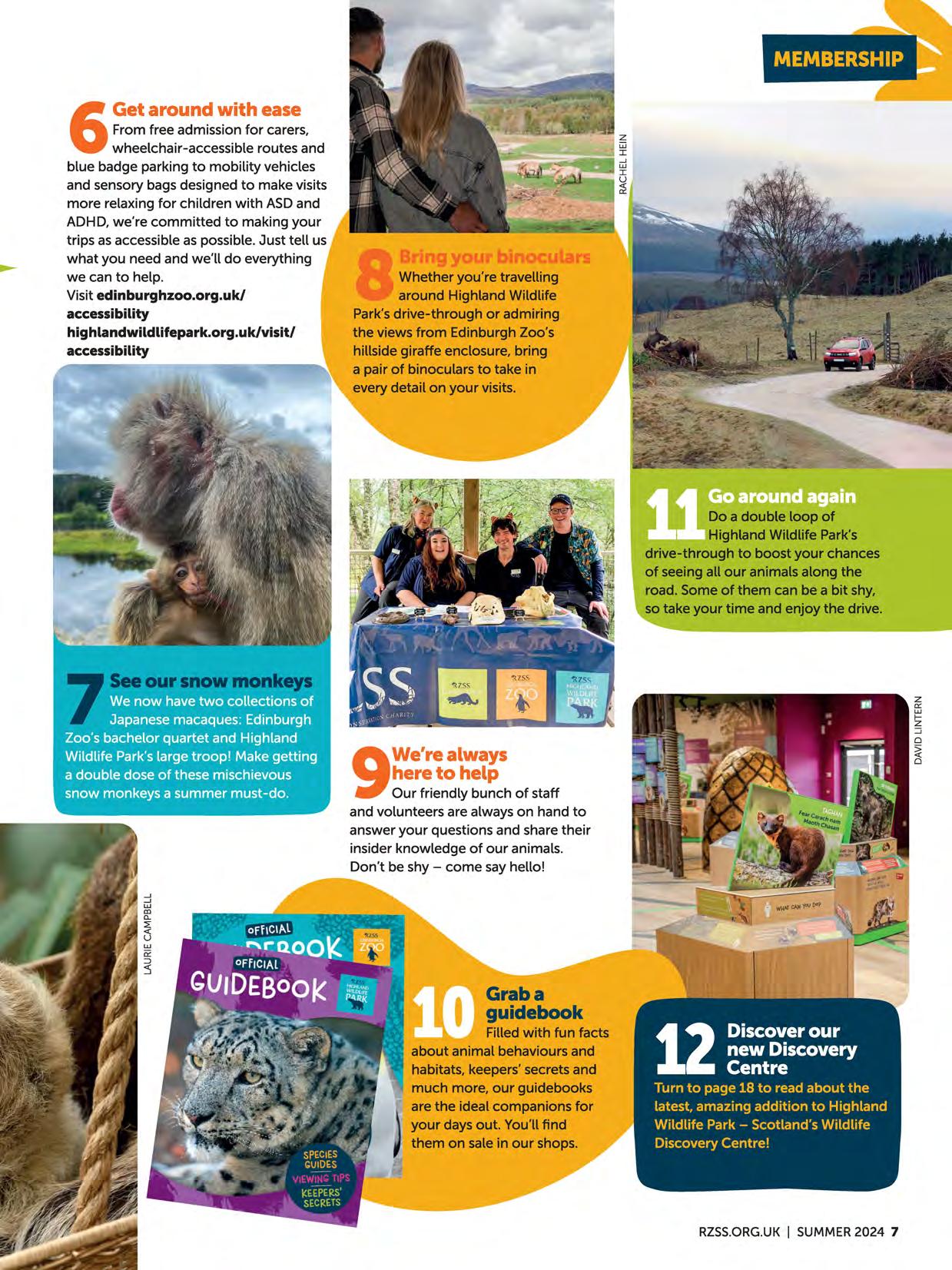
Whether you're travelling around Highland Wildlife Park's drive-through or admiring the views from Edinburgh Zoo's hillside giraffe enclosure, bring a pair of binoculars to take in every detail on your visits.
drive-through to boost your chances of seeing all our animals along the road. Some of them can be a bit shy, so take your time and enjoy the drive.
Our friendly bunch of staff and volunteers are always on hand to answer your questions and share their insider knowledge of our animals. Don't be shy -come say hello!
Filled with fun facts
habitats, keepers' secrets and much more, our guidebooks are the ideal companions for your days out. You'll find them on sale in our shops.

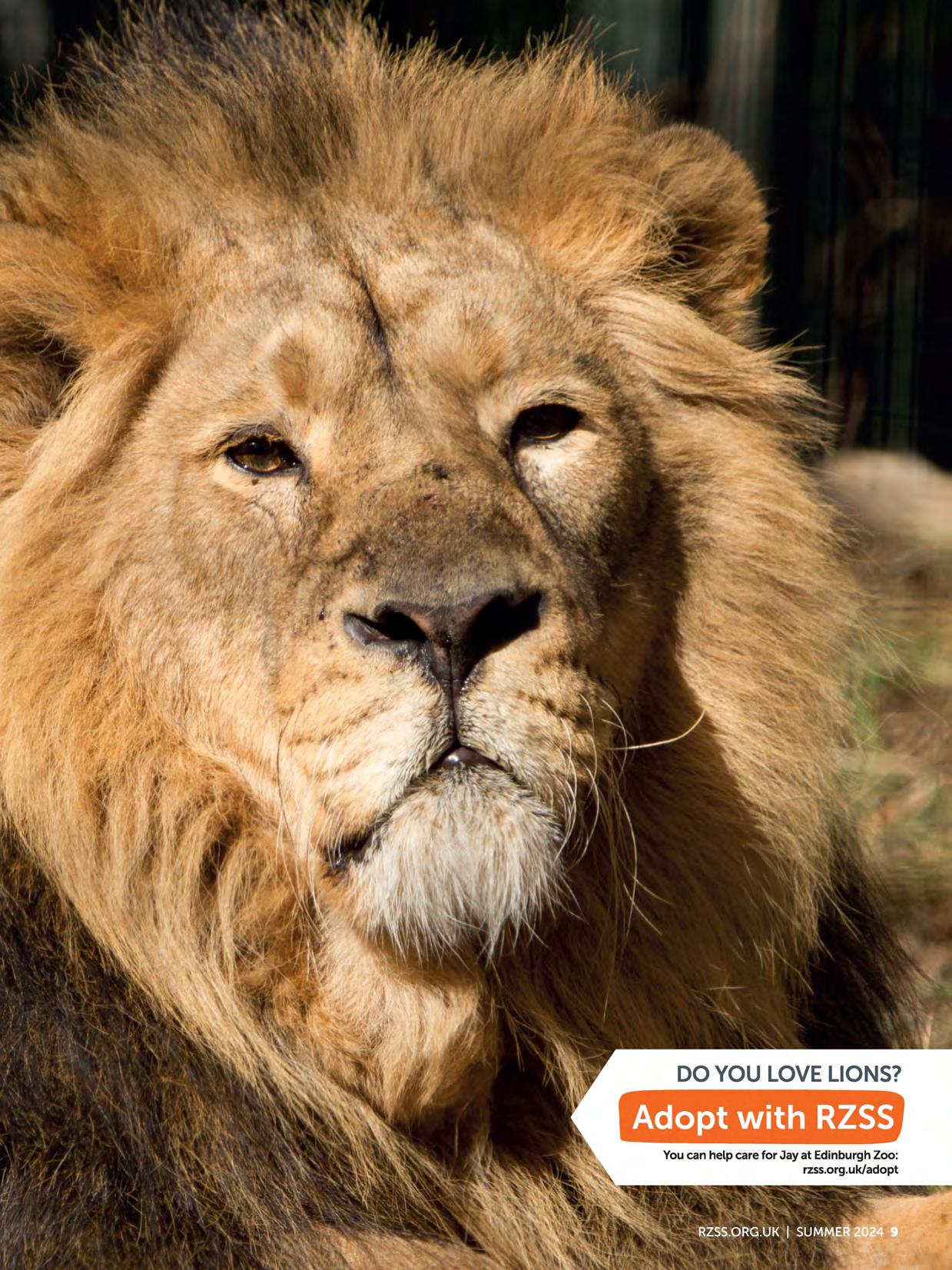

Penguins Rock is just one of the many attractions that make Edinburgh Zoo a hit with visitors
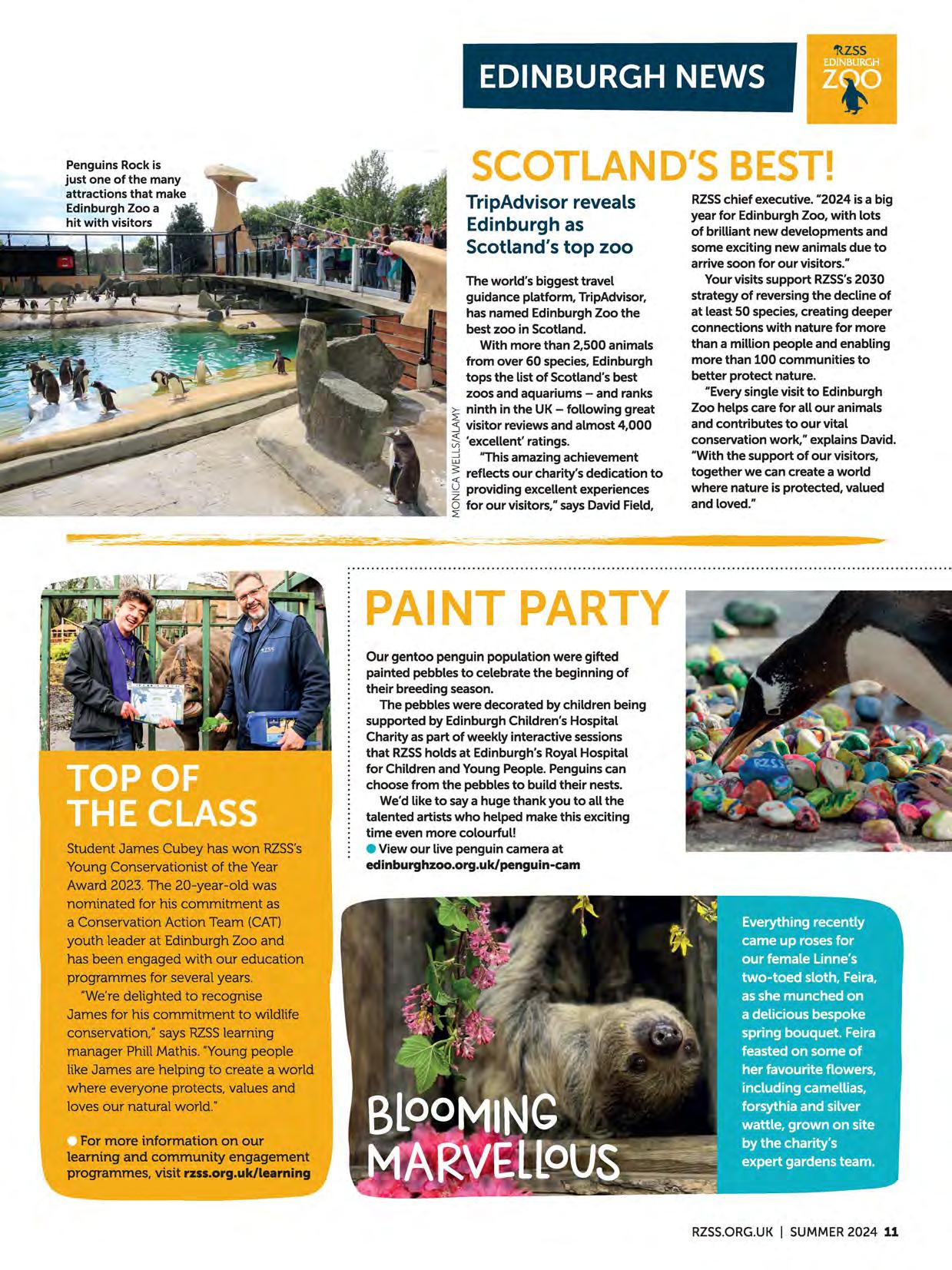
Student James Cubey has won RZSS's Young Conservationist of the Year Award 2023. The 20-year-old was nominated for his commitment as a Conservation Action Team (CAT) youth leader at Edinburgh Zoo and has been engaged with our education programmes for several years.
·we·re delighted to recognise James for his commitment to wildlife conservation," says RZSSlearning manager Phil! Mathis. "Young people like James are helping to create a world where everyone protects, values and loves our natural world."
For more information on our learning and community engagement programmes, visit rzss.org.uk/learning
The world's biggest travel guidance platform, TripAdvisor, has named Edinburgh Zoo the best zoo in Scotland.
With more than 2,500 animals from over 60 species, Edinburgh tops the list of Scotland's best zoos and aquariums -and ranks ninth in the UK -following great ::i visitor reviews and almost 4,000 i;i 'excellent' ratings.
"This amazing achievement ., ! reflects our charity's dedication to - providing excellent experiences for our visitors,• says David Field,
Our gentoo penguin population were gifted painted pebbles to celebrate the beginning of their breeding season.
The pebbles were decorated by children being supported by Edinburgh Children's Hospital Charity as part of weekly interactive sessions that RZSSholds at Edinburgh's Royal Hospital for Children and Young People. Penguins can choose from the pebbles to build their nests.
We'd like to say a huge thank you to all the talented artists who helped make this exciting time even more colourful!
• View our live penguin camera at edinburghzoo.org.uk/penguin-cam
RZSSchief executive. "2024 is a big year for Edinburgh Zoo, with lots of brilliant new developments and some exciting new animals due to arrive soon for our visitors.·
Your visits support RZSS's2030 strategy of reversing the decline of at least 50 species, creating deeper connections with nature for more than a million people and enabling more than 100 communities to better protect nature.
"Every single visit to Edinburgh Zoo helps care for all our animals and contributes to our vital conservation work," explains David. "With the support of our visitors, together we can create a world where nature is protected, valued and loved."
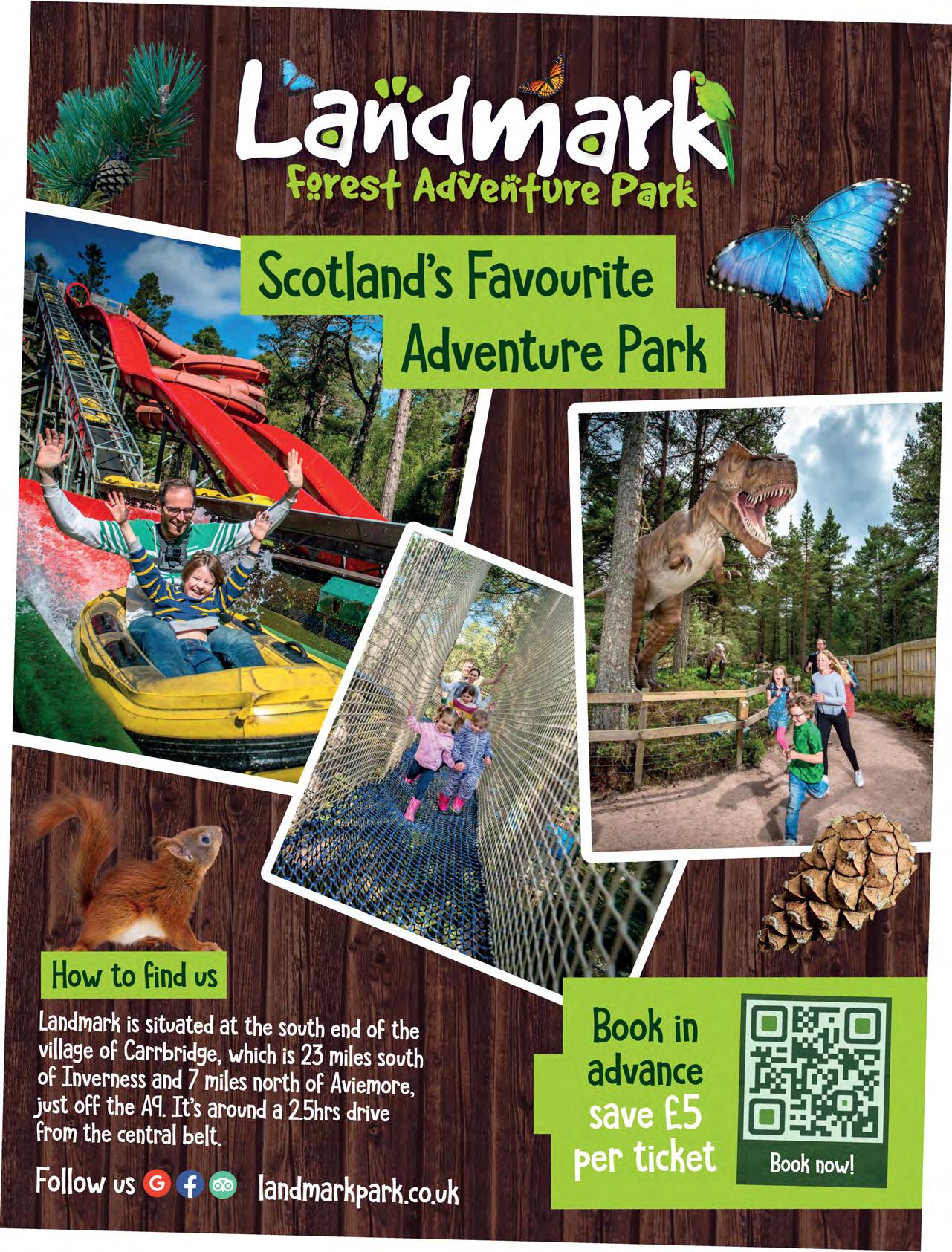
Debbie Barclay, experienced animal keeper at Highland Wildlife Park, on caring for this special Bactrian camel over the years
In 2004, one-year-old Caramel moved from ZSL Whipsnade Zoo to Edinburgh Zoo with her mum, Holly, to join male camel Kamali. Shortly after arriving, Holly gave birth to another calf, KHara.
After an excellent five years at the zoo, Caramel, Khara and Karnali moved to Highland Wildlife Park.
Our current girls, Dippy and Dierdre, joined Caramel here in 2021 from West Midlands Safari Park. The three of them can be spotted happily exploring their paddock (which we call the arable) with four yaks.
Caramel is a sensitive and gentle animal. She's unsure of any changes initially and will always let the others investigate first. Shyness aside, she's always interested in what us keepers are up to -mostly in the hope she'll get some treats!
Even after her breakfast, she'll check to see if the yaks have any leftovers or if there's unattended snacks in the keeper van. From pellets to browse (pine bark, willow leaves, rosebay willow herb) and the odd carrot, Caramel loves her food!
Caramel doesn't let being an older lady stop her from running about in her paddock either. She enjoys doing the odd jump and kicking her legs out when she's feeling playful or cheeky.
Knowing that we've all given Caramel the best care while letting her be her own silly self is an honour and a privilege.
Highland Wildlife Park has joined the World Association of Zoos and Aquariums (WAZA),which has been dedicated to guiding and supporting organisations in animal welfare, environmental education and global conservation since 1935.
"We're thrilled Highland Wildlife Park is now a member of WAZA. RZSShas long been a part of the global zoo community, and this reflects our charity's dedication to high standards of animal welfare, wildlife conservation and inspiring people to protect, value and love nature," says RZSSchief executive David Field.
"Highland Wildlife Park is at the heart of species conservation action in Scotland. The opening of Scotland's Wildlife Discovery Centre later this year will bring to life the challenges facing wildlife in Scotland and worldwide."
"We're very pleased to welcome Highland Wildlife Park as a WAZA member," says WAZA CEO Dr Martfn Zordan. 'The institution has played a crucial role in the recovery of wildcats and three native invertebrate species. I'm confident our community will learn from its impactful work."
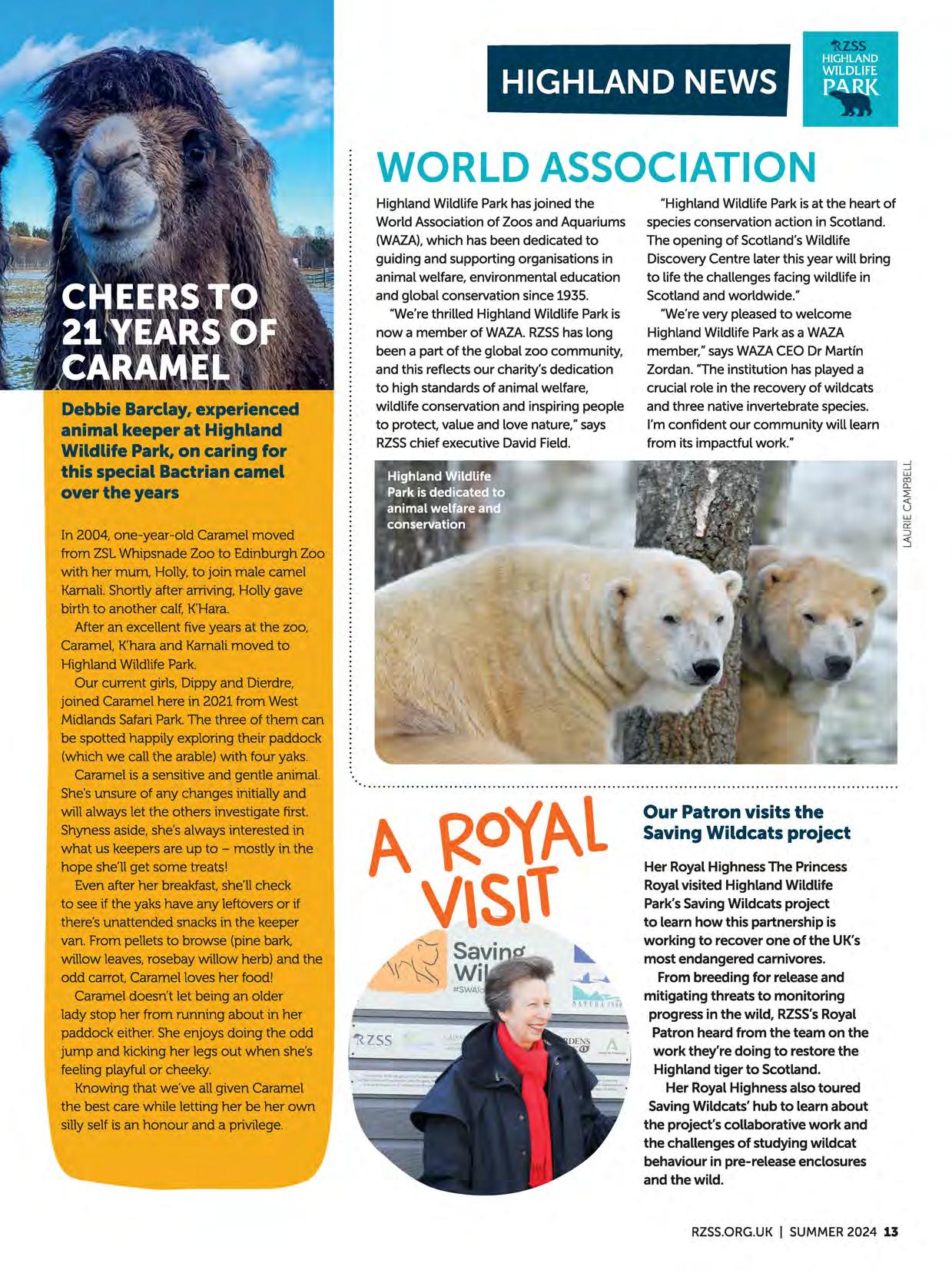
Our Patron visits the Saving Wildcats project
Her RoyalHighnessThe Princess Royalvisited HighlandWildlife Park'sSavingWildcatsproject to learn how this partnershipis working to recoverone of the UK's most endangeredcarnivores.
From breedingfor releaseand mitigatingthreats to monitoring progressin the wild, RZSS'sRoyal Patron heard from the team on the work they're doing to restorethe Highlandtiger to Scotland.
Her RoyalHighnessalsotoured SavingWildcats'hub to learn about the project'scollaborativework and the challengesof studyingwildcat behaviourin pre-releaseenclosures and the wild.
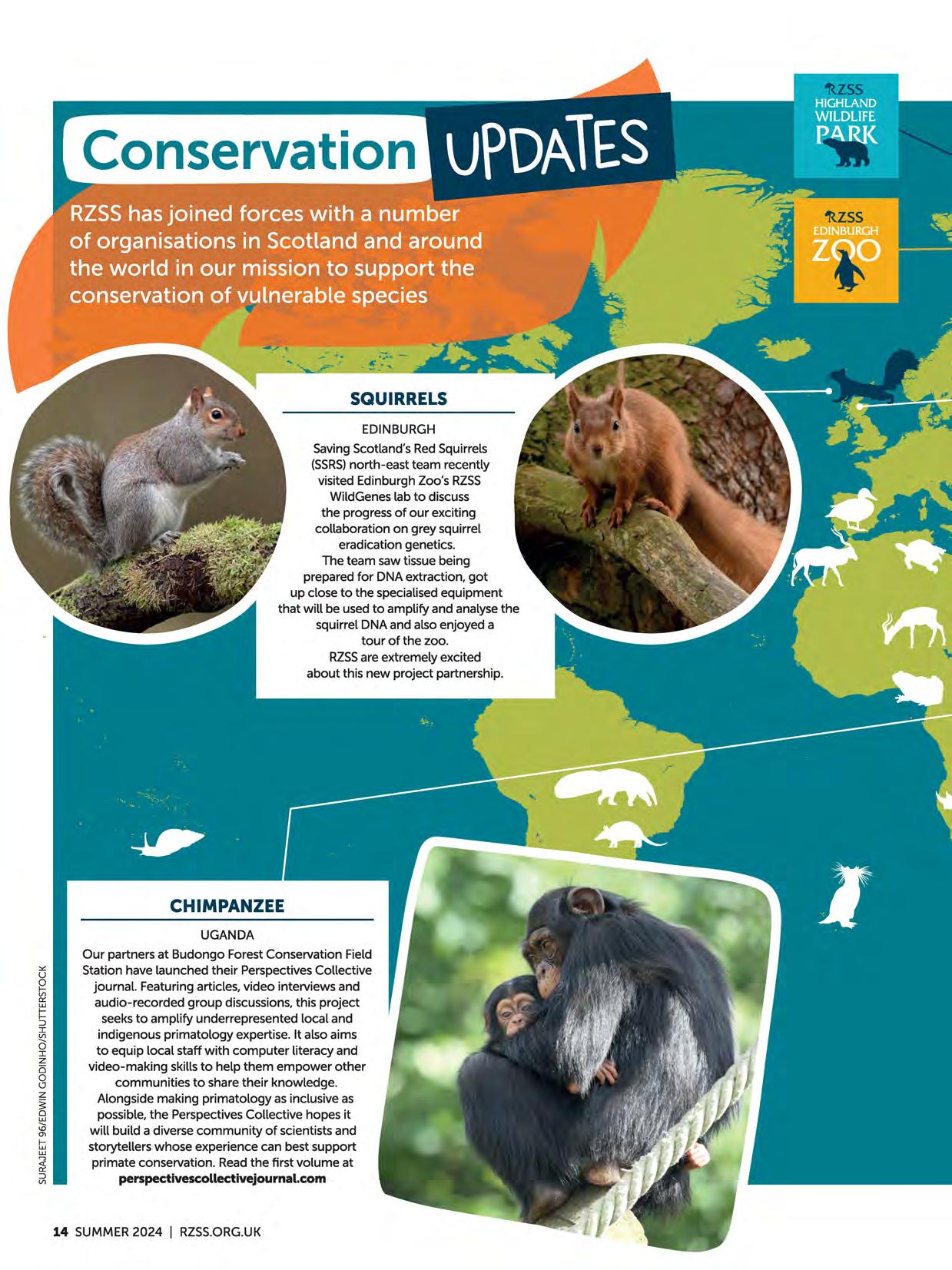
Saving Scotland's Red Squirrels (SSRS)north-east team recently visited Edinburgh Zoo's RZSS WildGenes lab to discuss the progress of our exciting collaboration on grey squirrel eradication genetics. The team saw tissue being prepared for DNA extraction, got up close to the specialised equipment that will be used to amplify and analyse the squirrel DNA and also enjoyed a tour of the zoo.
RZSSare extremely excited about this new project partnership.
Our partners at Budongo Forest Conservation Field Station have launched their Perspectives Collective journal. Featuring articles, video interviews and audio-recorded group discussions, this project seeks to amplify underrepresented local and indigenous primatology expertise. It also aims to equip local staff with computer literacy and video-making skills to help them empower other communities to share their knowledge. Alongside making primatology as inclusive as possible, the Perspectives Collective hopes it will build a diverse community of scientists and storytellers whose experience can best support primate conservation. Read the first volume at perspectivescollectivejournal.com
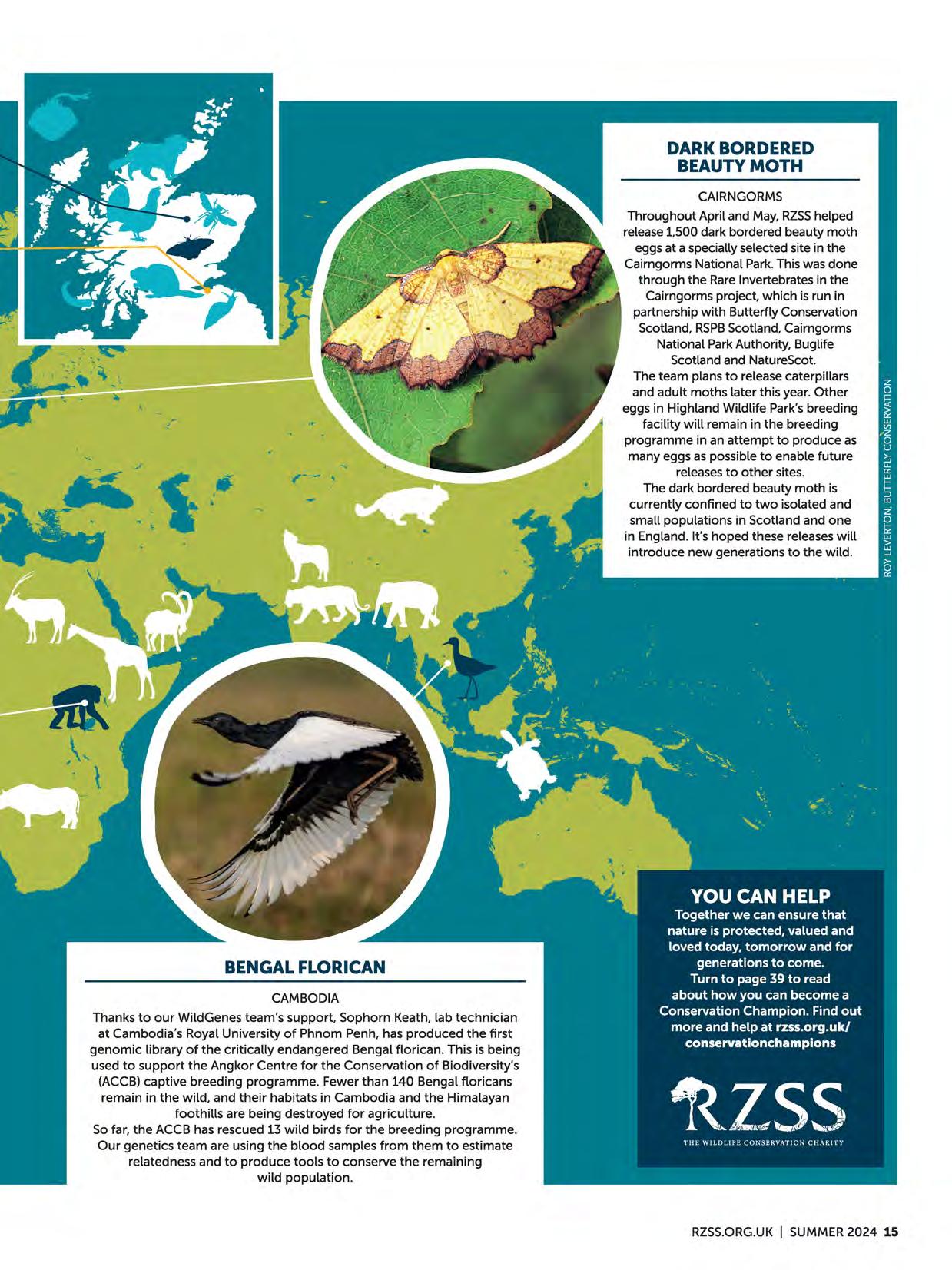
Thanks to our WildGenes team's support, Sophorn Keath, lab technician at Cambodia's Royal University of Phnom Penh, has produced the first genomic library of the critically endangered Bengal florican. This is being used to support the Angkor Centre for the Conservation of Biodiversity's (ACCB) captive breeding programme. Fewer than 140 Bengal floricans remain in the wild, and their habitats in Cambodia and the Himalayan foothills are being destroyed for agriculture.
So far, the ACCB has rescued 13 wild birds for the breeding programme. Our genetics team are using the blood samples from them to estimate relatedness and to produce tools to conserve the remaining wild population.
Throughout April and May, RZSShelped release 1,500 dark bordered beauty moth eggs at a specially selected site in the Cairngorms National Park. This was done through the Rare Invertebrates in the Cairngorms project, which is run in partnership with Butterfly Conservation Scotland, RSPBScotland, Cairngorms National Park Authority, Buglife Scotland and NatureScot.
The team plans to release caterpillars and adult moths later this year. Other eggs in Highland Wildlife Park's breeding facility will remain in the breeding programme in an attempt to produce as many eggs as possible to enable future releases to other sites.
The dark bordered beauty moth is currently confined to two isolated and small populations in Scotland and one in England. It's hoped these releases will introduce new generations to the wild.
Our ring-tailed lemurs -Kitata, Jingoma, Tipiaka and Pop Pop
Edinburgh Zoo
These cat-sized primates are easily the Madagascan rainforest's most gymnastic creatures. Strong hands provide powerful climbing and hanging prowess. while their nonprehensile tail helps them balance when travelling from tree to tree. Their muscular back legs allow them to leap up to 7.Sm -a distance six times the length of their body!
Our Amur tigers -Dominika, Botzman, Nishka, Layla and Aleksander
Highland Wildlife Park
Also known as the Siberian tiger, the world's largest big cat can run up to 53 miles per hour while hunting. Sprinting like this is exhausting, so these tigers only run at these speeds over short distances. They feed on wild boar, elk, deer, rodents and rabbits to keep their energy levels high for top performance.
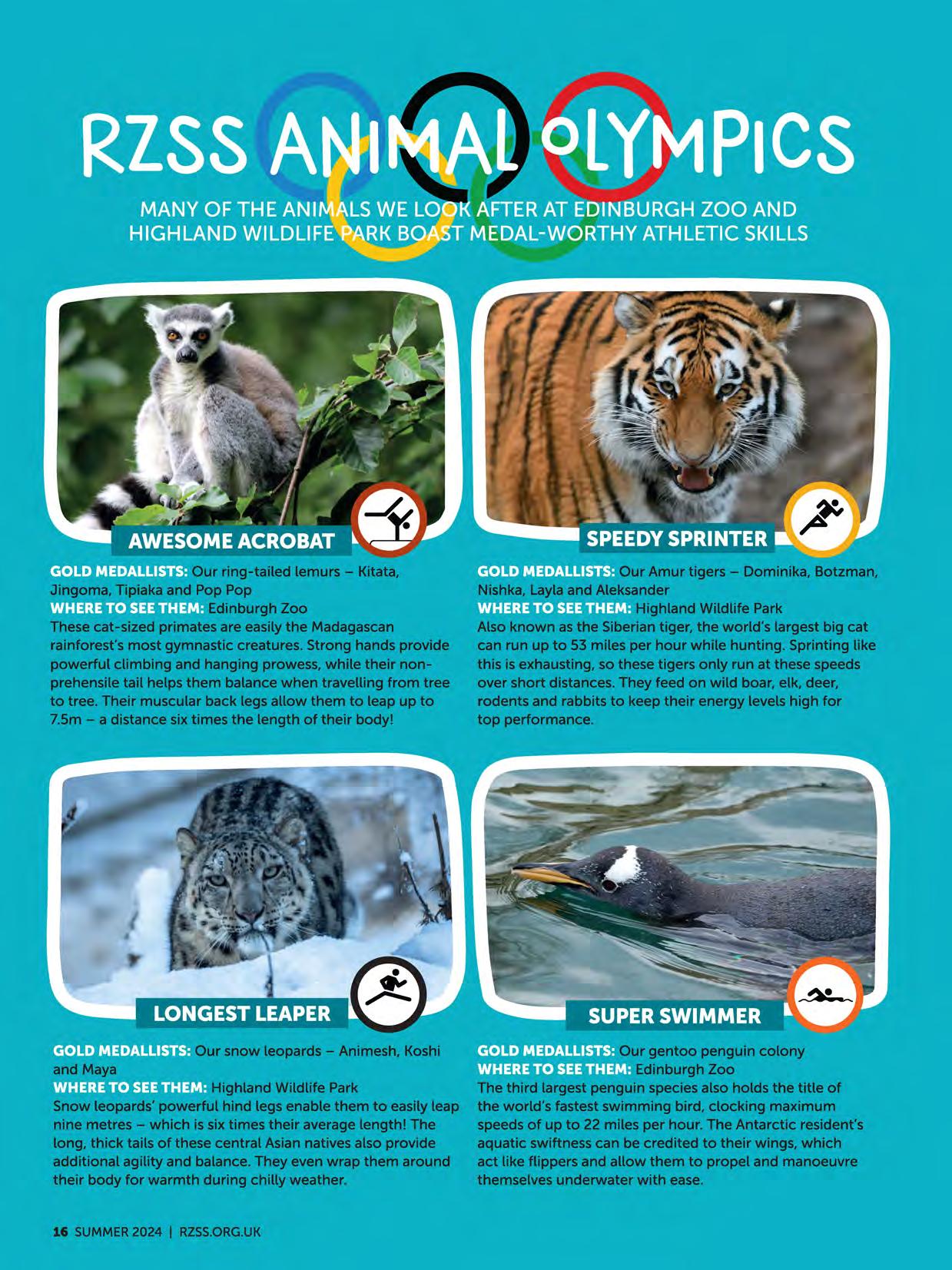
Highland Wildlife Park
Snow leopards' powerful hind legs enable them to easily leap nine metres -which is six times their average length! The long, thick tails of these central Asian natives also provide additional agility and balance. They even wrap them around their body for warmth during chilly weather.
ur gentoo penguin colony
Edinburgh Zoo
The third largest penguin species also holds the title of the world's fastest swimming bird, clocking maximum speeds of up to 22 miles per hour. The Antarctic resident's aquatic swiftness can be credited to their wings, which act like flippers and allow them to propel and manoeuvre themselves underwater with ease.
;;~~~~~~~~:;~~~;:,:;_nOur Arctic foxes -Jack, Sarahand Toots
Highland Wildlife Park
This crafty Arctic region resident employs distinctive hunting techniques when searching for lemmings buried under the snow. They tilt their heads to listen for prey burrowing underneath and, once located, jump several feet in the air before nose-diving into the snow to claim their target. While their aim might not always be 100% successful on first dive, their overall success rate is very impressive.
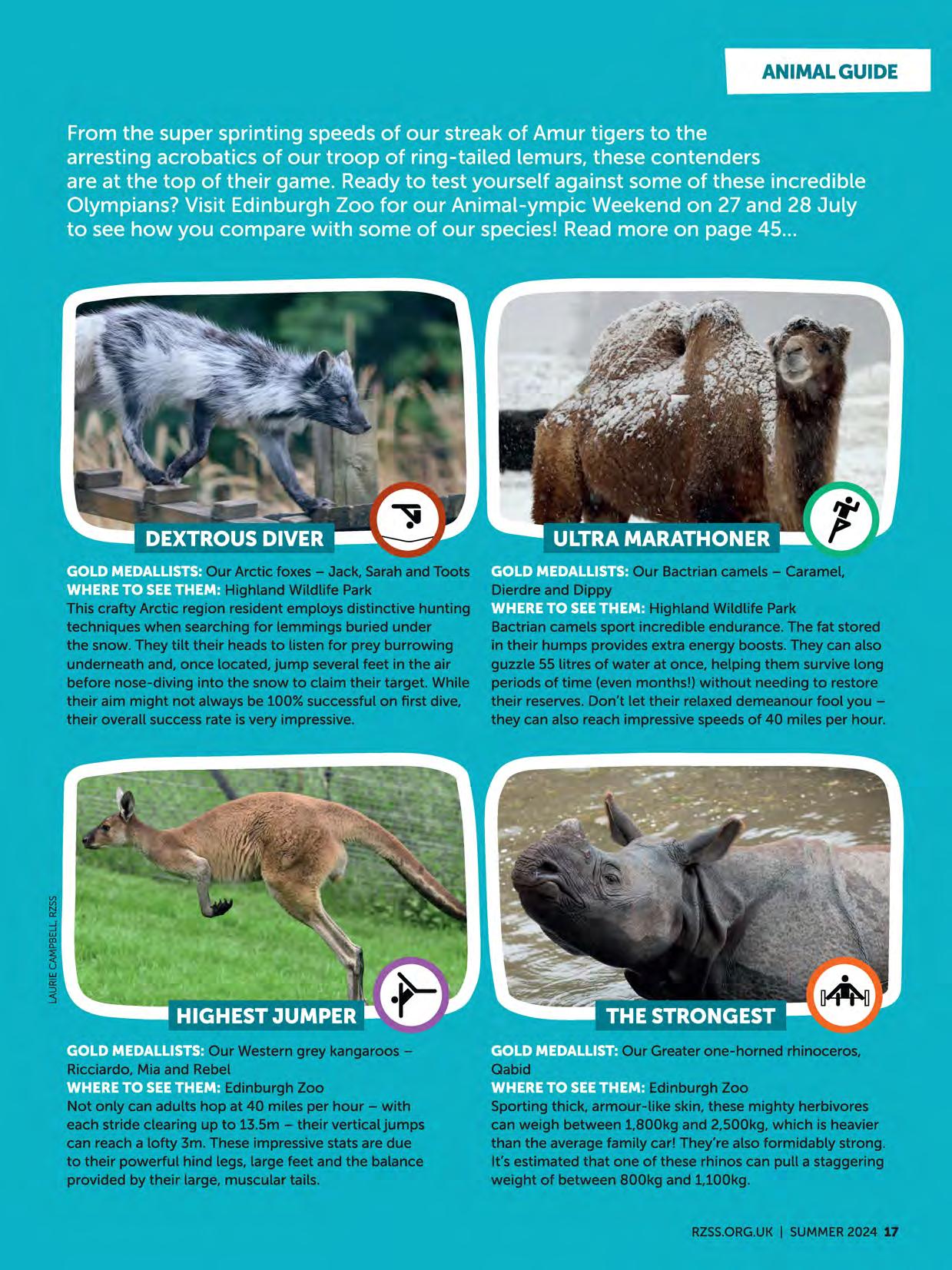
Our Western grey kangaroosRicciardo, Mia and Rebel
Edinburgh Zoo
Not only can adults hop at 40 miles per hour -with each stride clearing up to 13.5m -their vertical jumps can reach a lofty 3m. These impressive stats are due to their powerful hind legs, large feet and the balance provided by their large, muscular tails.
Highland Wildlife Park
Bactrian camels sport incredible endurance. The fat stored in their humps provides extra energy boosts. They can also guzzle 55 litres of water at once, helping them survive long periods of time (even months!) without needing to restore their reserves. Don't let their relaxed demeanour fool youthey can also reach impressive speeds of 40 miles per hour .
Edinburgh Zoo
Sporting thick, armour-like skin, these mighty herbivores can weigh between 1,800kg and 2,500kg, which is heavier than the average family car! They're also formidably strong. It's estimated that one of these rhinos can pull a staggering weight of between 800kg and 1,100kg.
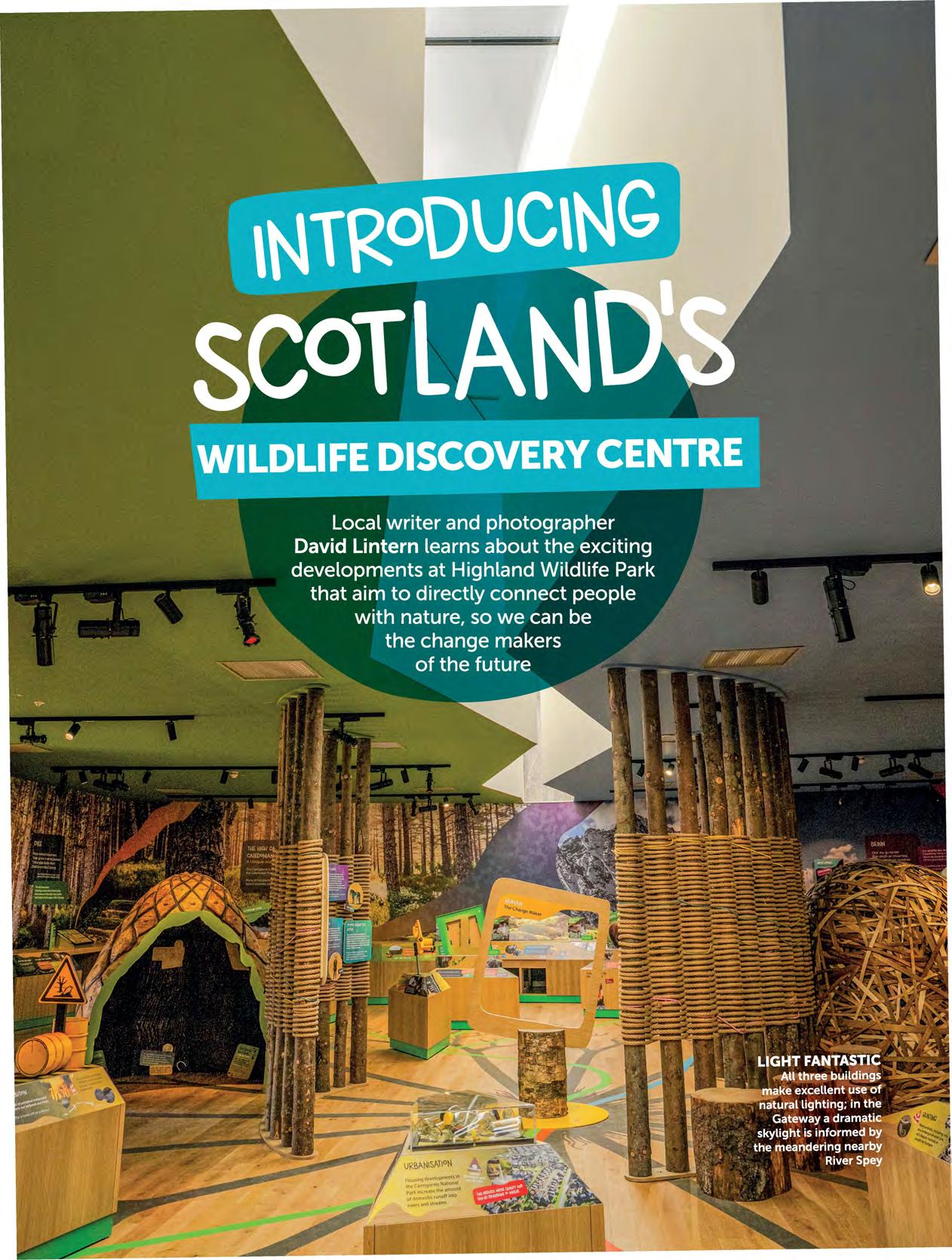
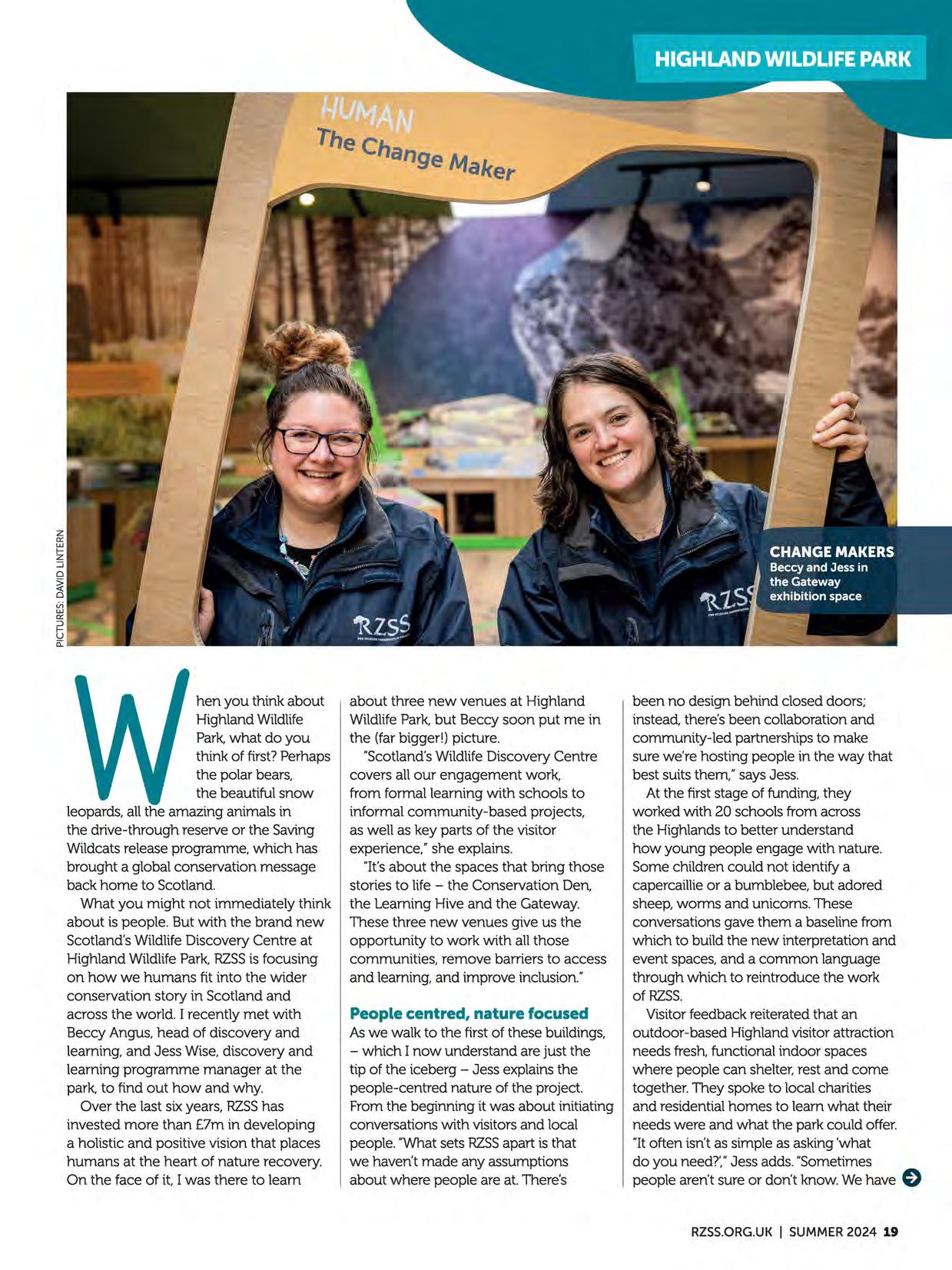
hen you think about Highland Wildlife Park, what do you think of first? Perhaps the polar bears, the beautiful snow leopards, all the amazing animals in the drive-through reserve or the Saving Wildcats release programme, which has brought a global conservation message back home to Scotland.
What you might not immediately think about is people. But with the brand new Scotland's WildlifeDiscovery Centre at Highland WildlifePark, RZSSis focusing on how we humans fit into the wider conservation story in Scotland and across the world. I recently met with Beccy Angus, head of discovery and learning, and Jess Wise, discovery and learning programme manager at the park, to find out how and why.
Over the last six years, RZSShas invested more than £7m in developing a holistic and positive vision that places humans at the heart of nature recovery. On the face of it, I was there to learn
about three new venues at Highland WildlifePark, but Beccy soon put me in the (far bigger!) picture.
"Scotland's WildlifeDiscovery Centre covers all our engagement work, from formal learning with schools to informal community-based projects, as well as key parts of the visitor experience," she explains.
"It's about the spaces that bring those stories to life -the Conservation Den, the Learning Hive and the Gateway. These three new venues give us the opportunity to work with all those communities, remove barriers to access and learning, and improve inclusion."
As we walk to the first of these buildings, -which I now understand are just the tip of the iceberg -Jess explains the people-centred nature of the project. From the beginning it was about initiating conversations with visitors and local people. "What sets RZSSapart is that we haven't made any assumptions about where people are at. There's
been no design behind closed doors; instead, there's been collaboration and community-led partnerships to make sure we're hosting people in the way that best suits them," says Jess.
At the first stage of funding, they worked with 20 schools from across the Highlands to better understand how young people engage with nature. Some children could not identify a capercaillie or a bumblebee, but adored sheep, worms and unicorns. These conversations gave them a baseline from which to build the new interpretation and event spaces, and a common language through which to reintroduce the work of RZSS.
Visitorfeedback reiterated that an outdoor-based Highland visitor attraction needs fresh, functional indoor spaces where people can shelter, rest and come together. They spoke to local charities and residential homes to learn what their needs were and what the park could offer. "It often isn't as simple as asking 'what do you need?'," Jess adds. "Sometimes people aren't sure or don't know. We have 0
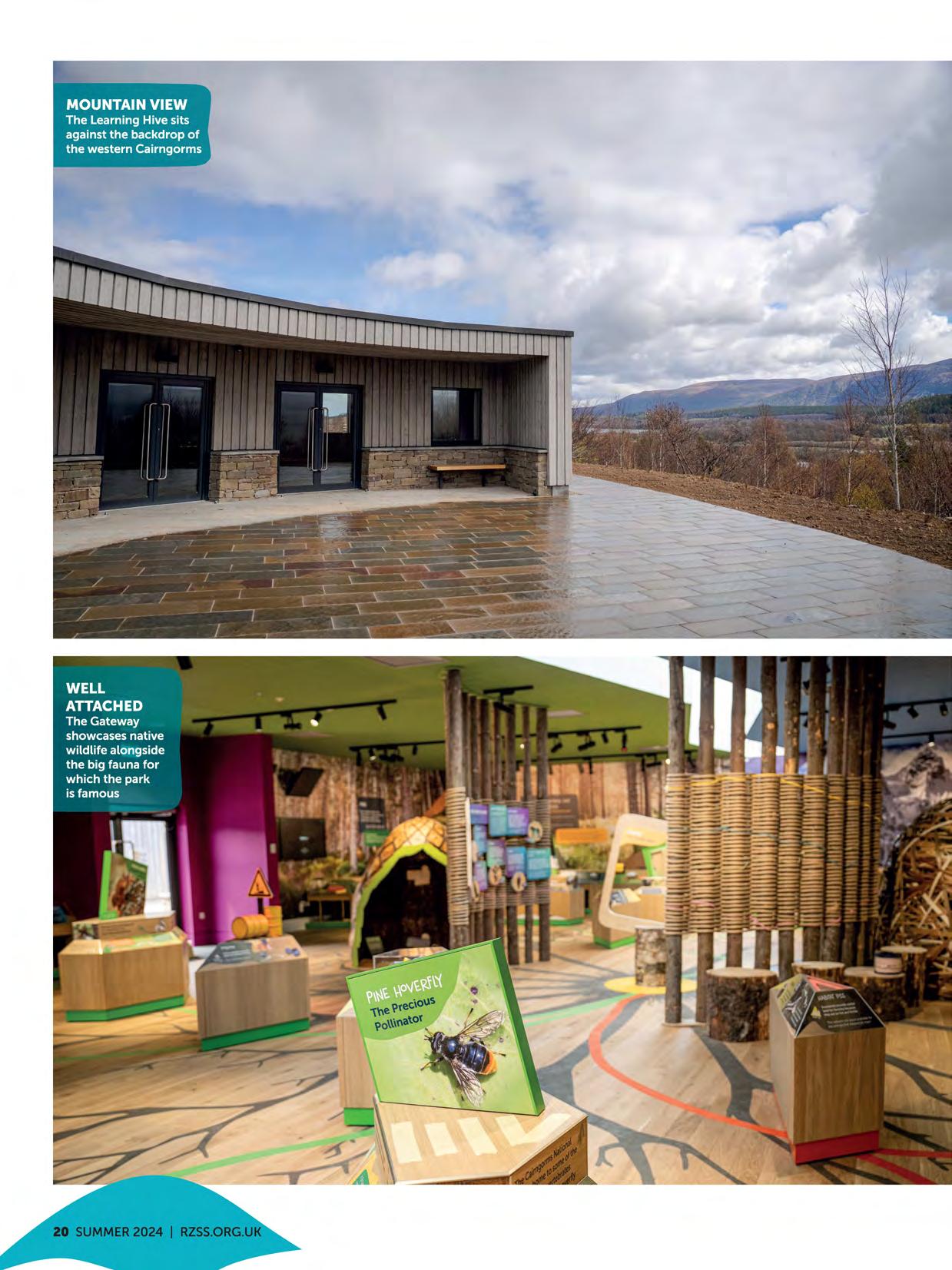
pooled years of market research and relationships to make sure that we are talking to people in a way that means something to them."
Up the hill, we arrive at the Conservation Den (in Gaelic, An Soabhaidh, a fox's den), which looks out across Strathspey to the mountains beyond. As Beccy explains the thinking behind the building, a penny drops and I feel genuinely excited about what Scotland's WildlifeDiscovery Centre has to offer. "It has been placed purposefully in between our global ambassador species, the polar bear and the snow leopard, with the aim of bringing conservation home," she says.
"I think it's easy to think that conservation is this big scientific thing done by experts in far-off places. Yet, the Den looks directly over to the Saving Wildcats conservation breeding for release centre. Visitors have a 360° view, both of the animals within our reserve and those who inhabit the place as their own wild space, and then across into Insh Marshes, Loch Insh and the Cairngorm mountains. These are the release sites for the wildcats. Our human visitors are put right in the middle of conservationnot the other side of the world, but tangible and right here and now."
11 We aim to initiate a train of thought or a conversation. lt 1s about creating an opening 11
BeccyAngus,Head of Discoveryand Learning
The building has an airy and open, bird-hide feel, is topped with a planted green roof and uses natural lighting. It really makes the most of where the park is, in the heart of Britain's largest National Park. It's possible to walk through the space, from reserve to release site, emphasising the

connection between the work of RZSSand the wider world. Beccy calls it "building that beyond".
The interpretation focuses on local conservation efforts, including the dark bordered beauty moth, medicinal leech, pine hoverfly, wildcat and capercaillie, as well as beavers and wading birds. But, as Jess points out, it also serves a practical purpose: "It's a seated, covered area at the top of a hill, so people can have a break and catch their breath. We can also hold talks or begin tours from here. It's a meeting place."
Conversation starter
The second venue I visit, the Gateway (Gaelic: An Dorus, a doorway), adjacent to the visitor centre and car park, is the main exhibition space, but can be enjoyed by visitors at any point in their daynot just at the start or end. Beccy describes this beautifully, as aiming "to initiate a train of thought or a conversation. It's about creating an opening. Imagine the feeling when you walk into a forest clearing. People are in the middle of the stories, very physically in the middle of the exhibition in terms of the interpretation, but also reminded that we are part of nature".
There's a refreshing lack of doommongering here. Our environmental
challenges are presented. but the emphasis is more on what humans and wildlife have in common. our shared needs.
Beccy calls this "fights and plights"the daily ups and downs faced by all life on Earth: the challenges of finding and keeping a warm. safe place to live. to find food and water. and for that environment to be stable enough to consider having offspring.
"Human impact does radiate outwards. But this is not about what we are doing to other species. without consequences for ourselves. It's about connection. Rather than appointing
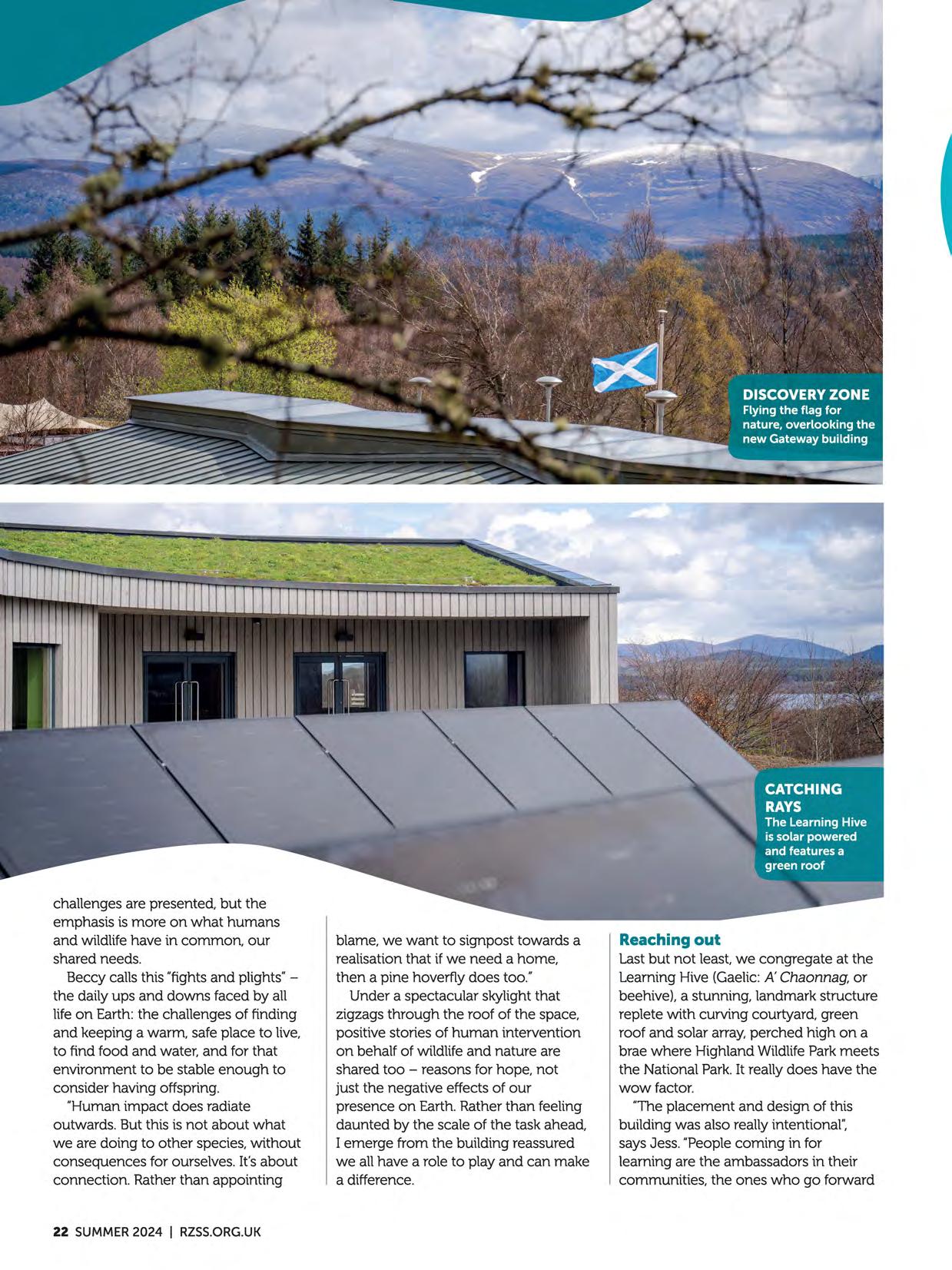
blame. we want to signpost towards a realisation that if we need a home, then a pine hoverfly does too."
Under a spectacular skylight that zigzags through the roof of the space, positive stories of human intervention on behalf of wildlife and nature are shared too -reasons for hope, not just the negative effects of our presence on Earth. Rather than feeling daunted by the scale of the task ahead, I emerge from the building reassured we all have a role to play and can make a difference.
Last but not least, we congregate at the Learning Hive (Gaelic: A' Chaonnag, or beehive). a stunning, landmark structure replete with curving courtyard. green roof and solar array, perched high on a brae where Highland WildlifePark meets the National Park It really does have the wow factor.
"The placement and design of this building was also really intentional", says Jess. "People coming in for learning are the ambassadors in their communities. the ones who go forward
/t begs the question
what do you want to do with this?1
You have the power and the choices 11
JessWise, Highland Wildlife Park Discovery and Learning Programme Manager
and will 'be the change'. We wanted this to be an inspiring, empowering place. When you are standing up here, you are looking out onto your landscape. It begs the question 'what do you want to do with this?' You have the power and the choices."
Jess's discovery and learning team are still in touch with those same schools that helped shape the first stage of the project. Transport is a barrier to learning in rural areas, so much of the work has involved going directly into schools, providing curriculum-linked resources through the park's own digital learning platform, Zoodle, and
supporting careers sessions for older children. Now, they have a bespoke venue to use as a meeting point for their Wild SkillsSchools, the Science Summer School, and want to establish the Hive as an extended classroom for on-site geography and biology lessons.
There are ambitions to move beyond schools to include adult and lifelong learning, including vocational training for mid-life career changers. This strategy is already being piloted at the higher education level through the Discovery Ambassador programme, a paid role that enables participants to gain the experience needed to be competitive in the conservation sector.
However, that's just the formal side of the education work based out of the Learning Hive. Jess and I have met briefly before, during one of her sessions with Alzheimer's Scotland, which runs an ingenious 'bring the outside in' event in a heated tepee that moves from village to village. RZSShas supported those events with work of its own, using 'bio facts' (wildcat pelts, red deer and elk antlers, bison horns and other natural artefacts that visitors can hold and touch) to elicit memories and conversations from the participants, many of whom have strong associations with the park.
Jess and her team also work with the Caberfeidh Horizons charity based in the neighbouring village of Kingussie. Their WildlifeWombles group meets twice weekly to work with the rangers, keepers and visitor staff around the park. The changes in confidence, teamwork and communication skills are plain to see.
They are also supporting a parentrun after-school club in the village of
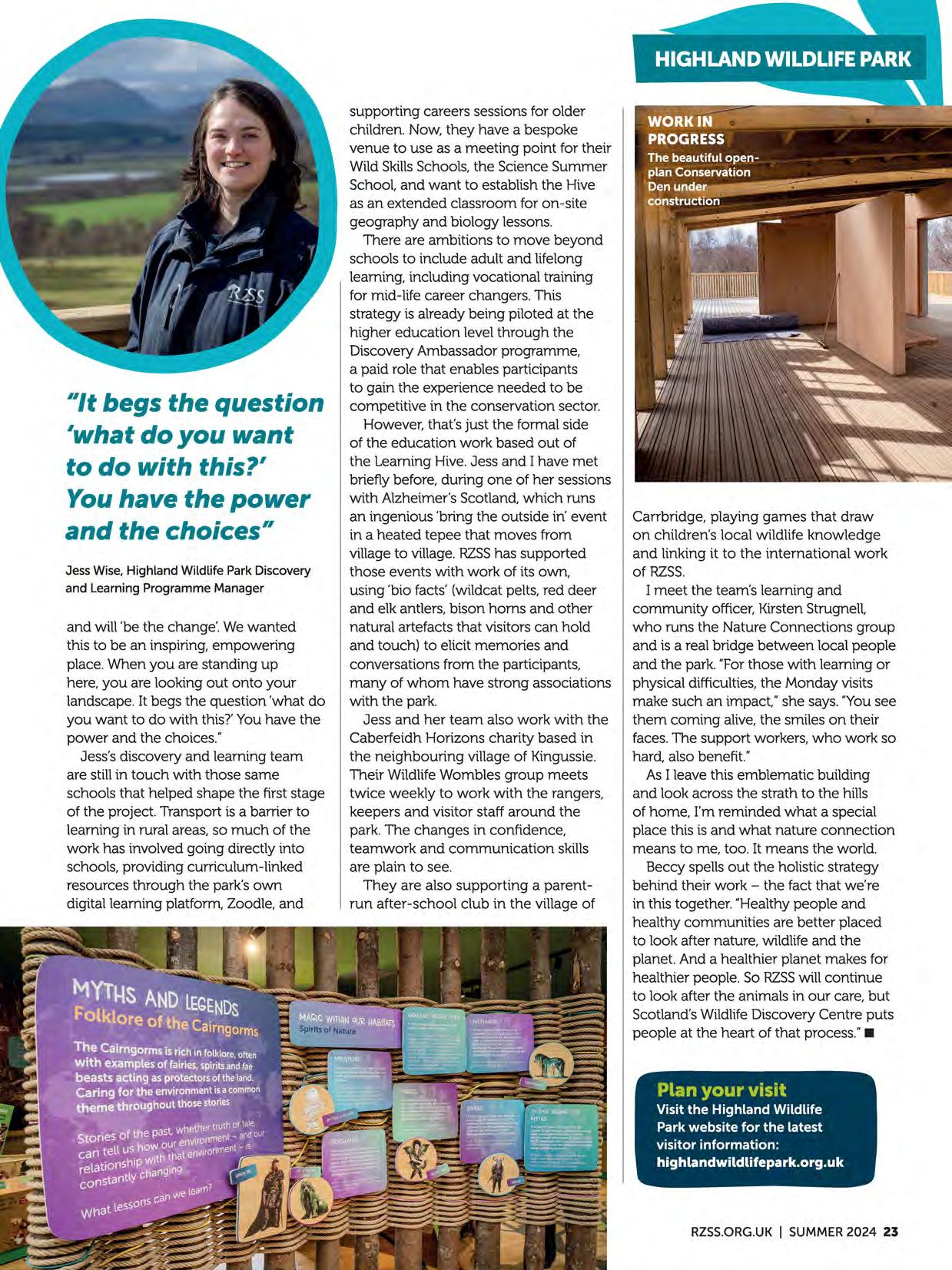
Carrbridge, playing games that draw on children's local wildlife knowledge and linking it to the international work of RZSS.
I meet the team's learning and community officer, Kirsten Strugnell, who runs the Nature Connections group and is a real bridge between local people and the park. "Forthose with learning or physical difficulties,the Monday visits make such an impact," she says. "Yousee them coming alive, the smiles on their faces. The support workers, who work so hard, also benefit."
As I leave this emblematic building and look across the strath to the hills of home, I'm reminded what a special place this is and what nature connection means to me, too. It means the world.
Beccy spells out the holistic strategy behind their work -the fact that we're in this together. "Healthy people and healthy communities are better placed to look after nature, wildlife and the planet. And a healthier planet makes for healthier people. So RZSSwill continue to look after the animals in our care, but Scotland's WildlifeDiscovery Centre puts people at the heart of that
Plan your visit
Journalist Jonathan McIntosh learns all about the leader of Edinburgh Zoo's herd of giraffes
Edinburgh Zoo's Nubian giraffe quintet has settled in nicely since arriving in May 2021. The tallest of the herd, Arrow, usually keeps his buddies in check, even on the days when he's feeling a little shy.
"Arrow may be the biggest and most dominant, but he's a bit timid," explains Jonny Appleyard, Edinburgh Zoo's hoofstock and reptiles team leader. "He's come on leaps and bounds since arriving, however. At first, he didn't want to take part in much. Now he enjoys interacting with the keepers and visitors."
This 'bachelor herd' of five young male giraffes has deep family ties to Edinburgh Zoo. Gilbert is the grandson of Rebecca and Niger, who came here in 1983. Half-brothers Ronnie and Arrow, and brothers Fennessy and Gerald, are related to Big Ed and Jade, residents from the mid-nineties.
Getting this gang together for the first time was a big challenge for Jenny's team. "Giraffes notoriously don't like change, so we knew they'd be anxious during their first meeting. However, the group were at ages when they'd naturally be looking to join other juvenile giraffe groups, so we used this to our advantage," says Jonny.
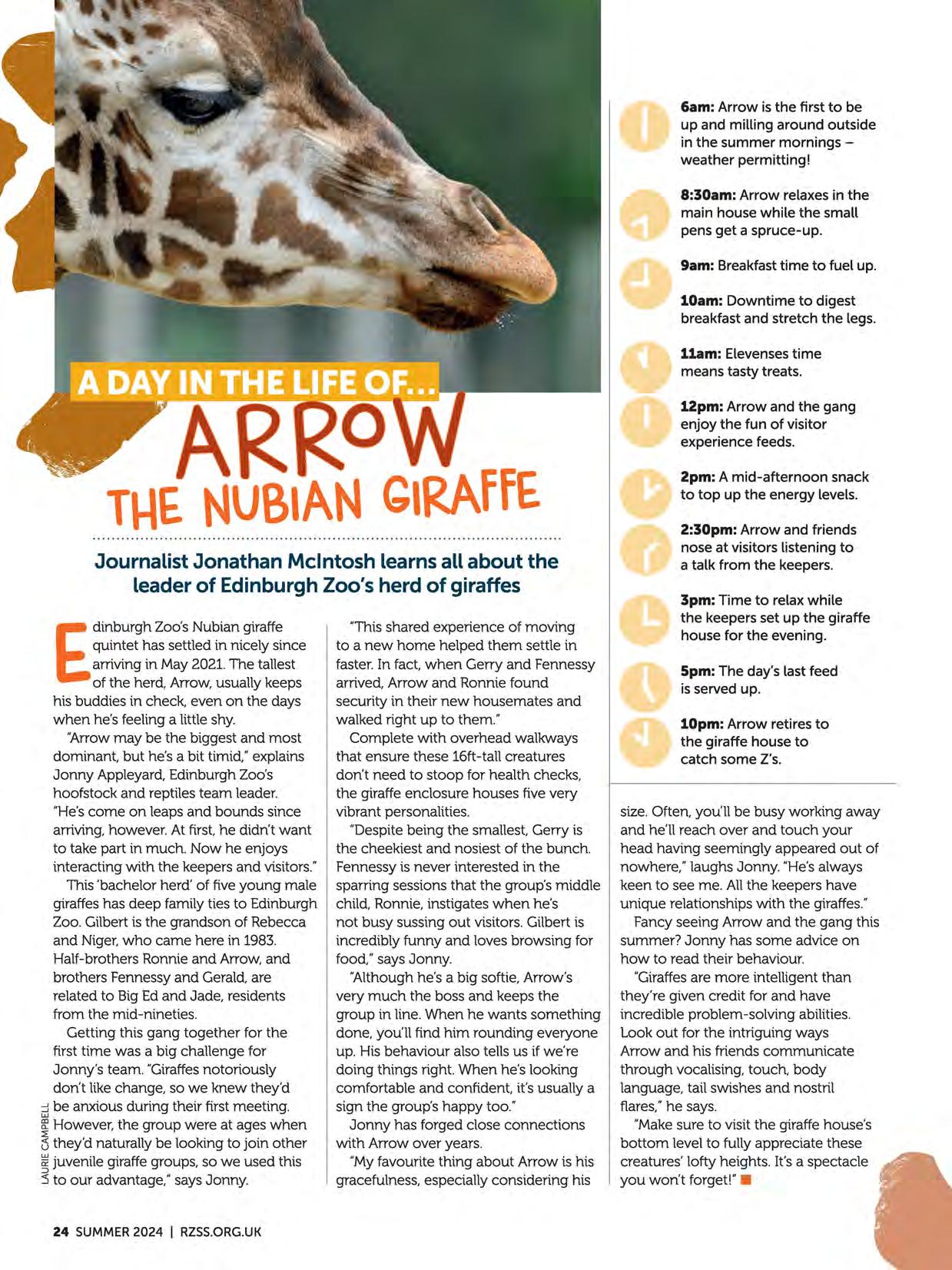
"This shared experience of moving to a new home helped them settle in faster. In fact, when Gerry and Fennessy arrived, Arrow and Ronnie found security in their new housemates and walked right up to them."
Complete with overhead walkways that ensure these 16ft-tall creatures don't need to stoop for health checks, the giraffe enclosure houses five very vibrant personalities.
"Despite being the smallest, Gerry is the cheekiest and nosiest of the bunch. Fennessy is never interested in the sparring sessions that the group's middle child, Ronnie, instigates when he's not busy sussing out visitors. Gilbert is incredibly funny and loves browsing for food," says Jonny.
"Although he's a big softie, Arrow's very much the boss and keeps the group in line. When he wants something done, you'll find him rounding everyone up. His behaviour also tells us if we're doing things right. When he's looking comfortable and confident, it's usually a sign the group's happy too."
Jonny has forged close connections with Arrow over years.
"My favourite thing about Arrow is his gracefulness, especially considering his
0
e
0
0
0
0
0
e
0
0
6am: Arrow is the first to be up and milling around outside in the summer morningsweather permitting!
8:30am: Arrow relaxes in the main house while the small pens get a spruce-up.
9am: Breakfast time to fuel up.
10am: Downtime to digest breakfast and stretch the legs.
11am: Elevenses time means tasty treats.
12pm: Arrow and the gang enjoy the fun of visitor experience feeds.
2pm: A mid-afternoon snack to top up the energy levels.
2:30pm: Arrow and friends nose at visitors listening to a talk from the keepers.
3pm: Time to relax while the keepers set up the giraffe house for the evening.
5pm: The day's last feed is served up.
10pm: Arrow retires to the giraffe house to catch some l's.
size. Often, you'll be busy working away and he'll reach over and touch your head having seemingly appeared out of nowhere," laughs Jonny. "He's always keen to see me. AU the keepers have unique relationships with the giraffes."
Fancy seeing Arrow and the gang this summer? Jonny has some advice on how to read their behaviour.
"Giraffes are more intelligent than they're given credit for and have incredible problem-solving abilities. Look out for the intriguing ways Arrow and his friends communicate through vocalising, touch, body language, tail swishes and nostril flares," he says.
"Make sure to visit the giraffe house's bottom level to fully appreciate these creatures' lofty heights. It's a spectacle you won't
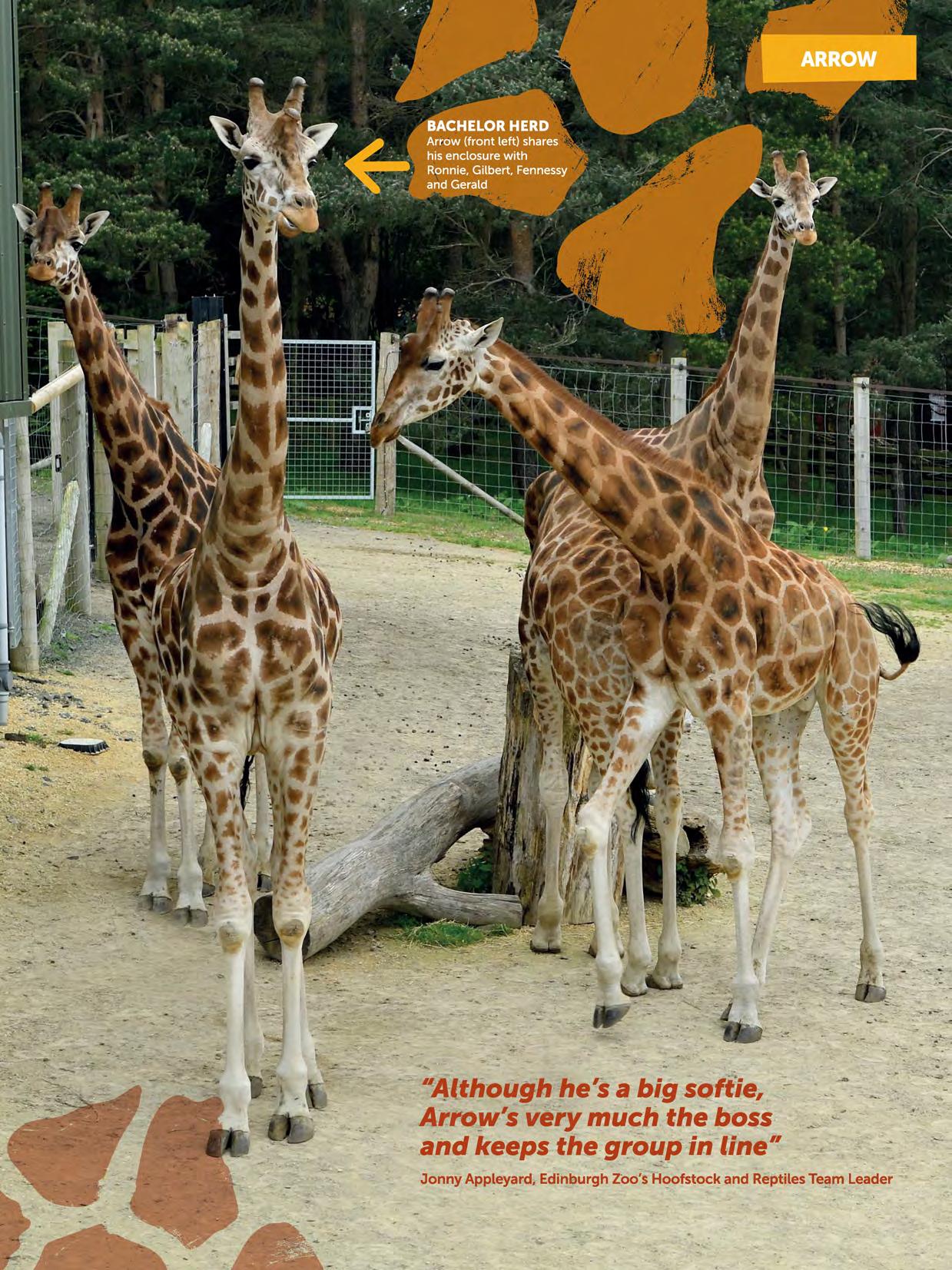
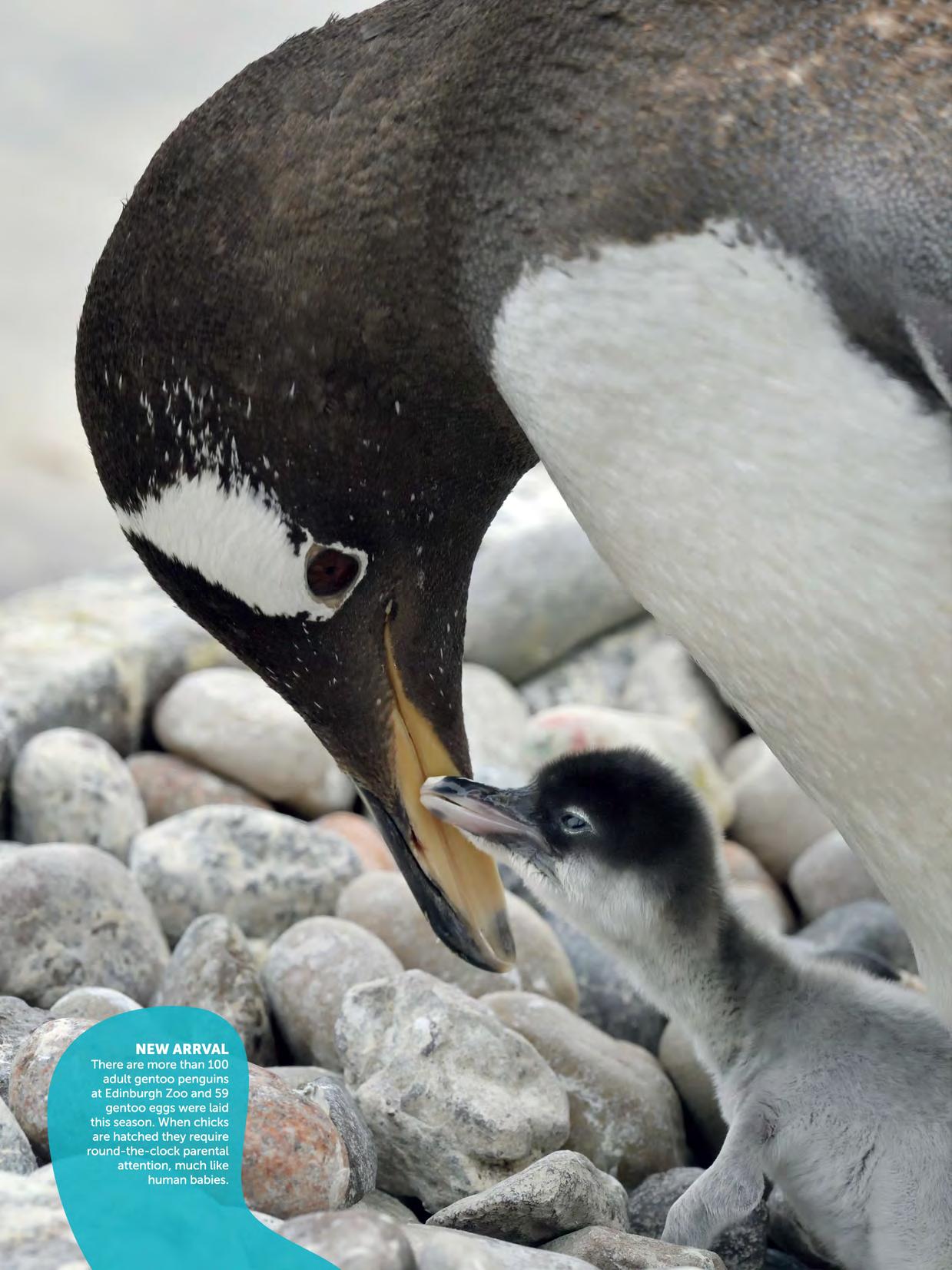
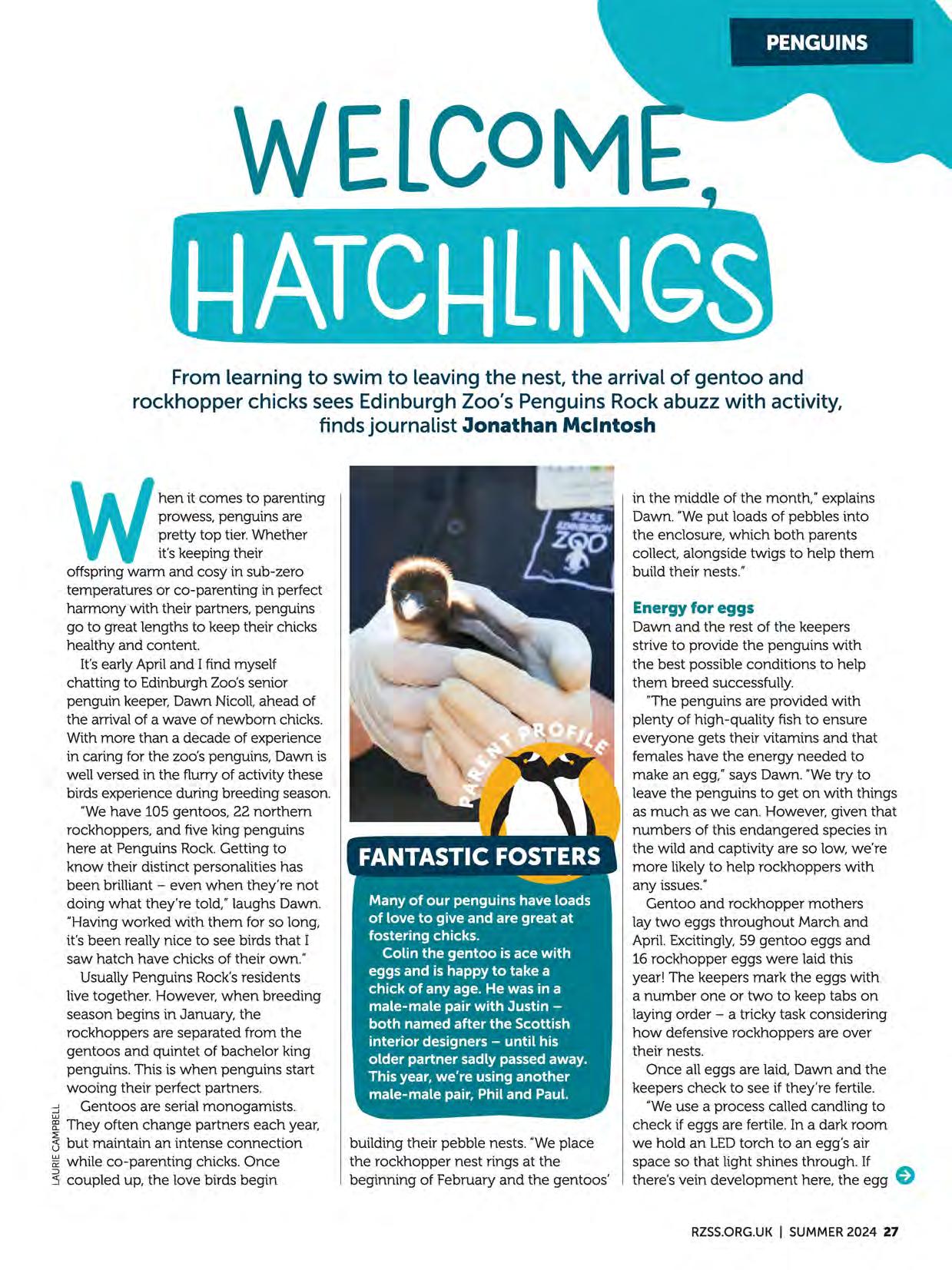
From learning to swim to leaving the nest, the arrival of gentoo and rockhopper chicks sees Edinburgh Zoo's Penguins Rock abuzz with activity, finds journalist Jonathan McIntosh
When it comes to_parenting prowess, penguins are pretty top tier. Whether it's keeping their offspring warm and cosy in sub-zero temperatures or co-parenting in perfect harmony with their partners, penguins go to great lengths to keep their chicks healthy and content.
It's early April and I find myself chatting to Edinburgh Zoo's senior penguin keeper, Dawn Nicoll, ahead of the arrival of a wave of newborn chicks. With more than a decade of experience in caring for the zoo's penguins, Dawn is well versed in the flurry of activity these birds experience during breeding season.
"We have 105 gentoos, 22 northern rockhoppers, and five king penguins here at Penguins Rock. Getting to know their distinct personalities has been brilliant -even when they're not doing what they're told," laughs Dawn. "Having worked with them for so long, it's been really nice to see birds that I saw hatch have chicks of their own."
Usually Penguins Rock's residents live together. However, when breeding season begins in January, the rockhoppers are separated from the gentoos and quintet of bachelor king penguins. This is when penguins start wooing their perfect partners.
Gentoos are serial monogamists. They often change partners each year, but maintain an intense connection while co-parenting chicks. Once coupled up, the love birds begin
in the middle of the month," explains Dawn. "We put loads of pebbles into the enclosure, which both parents collect, alongside twigs to help them build their nests."
Dawn and the rest of the keepers strive to provide the penguins with the best possible conditions to help them breed successfully.
"The penguins are provided with plenty of high-quality fish to ensure everyone gets their vitamins and that females have the energy needed to make an egg," says Dawn. "We try to leave the penguins to get on with things as much as we can. However, given that numbers of this endangered species in the wild and captivity are so low, we're more likely to help rockhoppers with any issues."
Gentoo and rockhopper mothers lay two eggs throughout March and April. Excitingly,59 gentoo eggs and 16 rockhopper eggs were laid this year! The keepers mark the eggs with a number one or two to keep tabs on laying order -a tricky task considering how defensive rockhoppers are over their nests.
Once all eggs are laid, Dawn and the keepers check to see if they're fertile.
"We use a process called candling to check if eggs are fertile. In a dark room we hold an LEDtorch to an egg's air space so that light shines through. If A there's vein development here, the egg W
building their pebble nests. "We place the rockhopper nest rings at the beginning of February and the gentoos'is fertile," says Dawn. "Candling gives us an idea of how many chicks we're expecting and helps us plan for the care of the eggs."
Rockhoppers typically have one fertile egg each year, while gentoos produce two. A studbook is used to manage Penguins Rock's family tree. If relatives have partnered, their eggs are removed and replaced with dummy ones to protect the colony's genetic diversity. These pairs may later go on to become foster parents if needed.
This year's penguin pairs have been hard at work putting their parenting instincts into practice.
"Both parents take turns keeping the eggs warm throughout the incubation period, which for gentoos is 35 days and between 33 and 38 days for rockhoppers," explains Dawn.
"In the wild, the free parent would go and hunt. At Penguins Rock,they spend their downtime swimming, napping or devotedly standing guard over their nest."
The keepers do everything they can to ensure as many eggs as possible hatch successfully.
"Ifa pair is struggling to keep their egg warm, we can help by putting

them in artificial incubators," says Dawn. "We also use our fostering system to move eggs between parent pairs so that fertile eggs get the best possible care."
Rockhopper eggs usually hatch in mid-April, while Gentoo eggs start hatching at the end of the month and into May.
Chicks first pip by poking a small hole in the egg. They then chip at the shell until they can push off the top, which can take up to three days. Dawn's team are always on hand to welcome these new arrivals into the world.
"When feeding the parents, we'll keep an eye on their eggs to see how the chicks are hatching. Sometimes chicks can get tired. We'll spray their egg to get moisture into the membrane to prevent it sticking to the chick's feathers," explains Dawn.
"We weigh chicks daily to check they're growing as they should. We also give them extra sprats to help them bulk up"
"Ifthe chick becomes exhausted, we can peel back the shell to help if it's safe to do so. For more complex situations, the vet team are here to support."
Unfortunately, not all penguin chicks make it. Some eggs don't hatch after the incubation period or roll off the nests.
"If a chick dies, we give the parents time to come to terms with what's happened. By giving them this space, the parents don't call for it when we take it away," says Dawn. "Our vets do a full post-mortem because it's important we find out what went wrong. Usually there's no reason for itit's just one of these sad things that happen."
New arrivals require round-the-clock attention. Newly hatched chicks are covered in white and grey downy feathers, which aren't waterproof, so one of the parents' main responsibilities is to keep them out of water until their juvenile plumage comes in.
As well as keeping them cosy, both parents must also ensure their offspring are eating as much as possible so that they grow up big and strong. Dawn and the keepers provide the penguin parents with double the quantity of fish to keep these young bellies full.
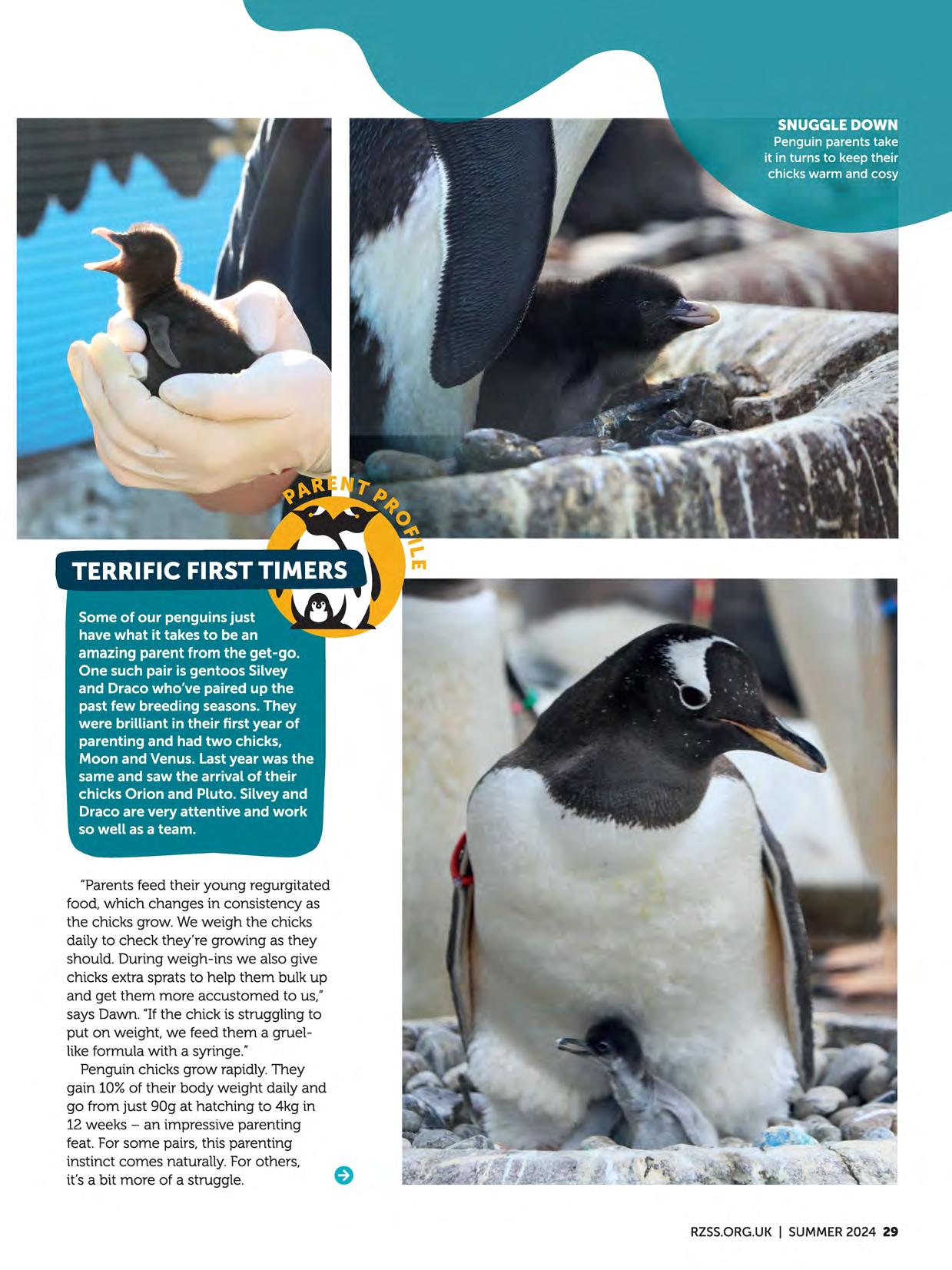
"Parents feed their young regurgitated food, which changes in consistency as the chicks grow. We weigh the chicks daily to check they're growing as they should. During weigh-ins we also give chicks extra sprats to help them bulk up and get them more accustomed to us," says Dawn. "Ifthe chick is struggling to put on weight, we feed them a gruellike formula with a syringe."
Penguin chicks grow rapidly. They gain 10% of their body weight daily and go from just 90g at hatching to 4kg in 12 weeks -an impressive parenting feat. For some pairs, this parenting instinct comes naturally. For others, A it's a bit more of a struggle. W
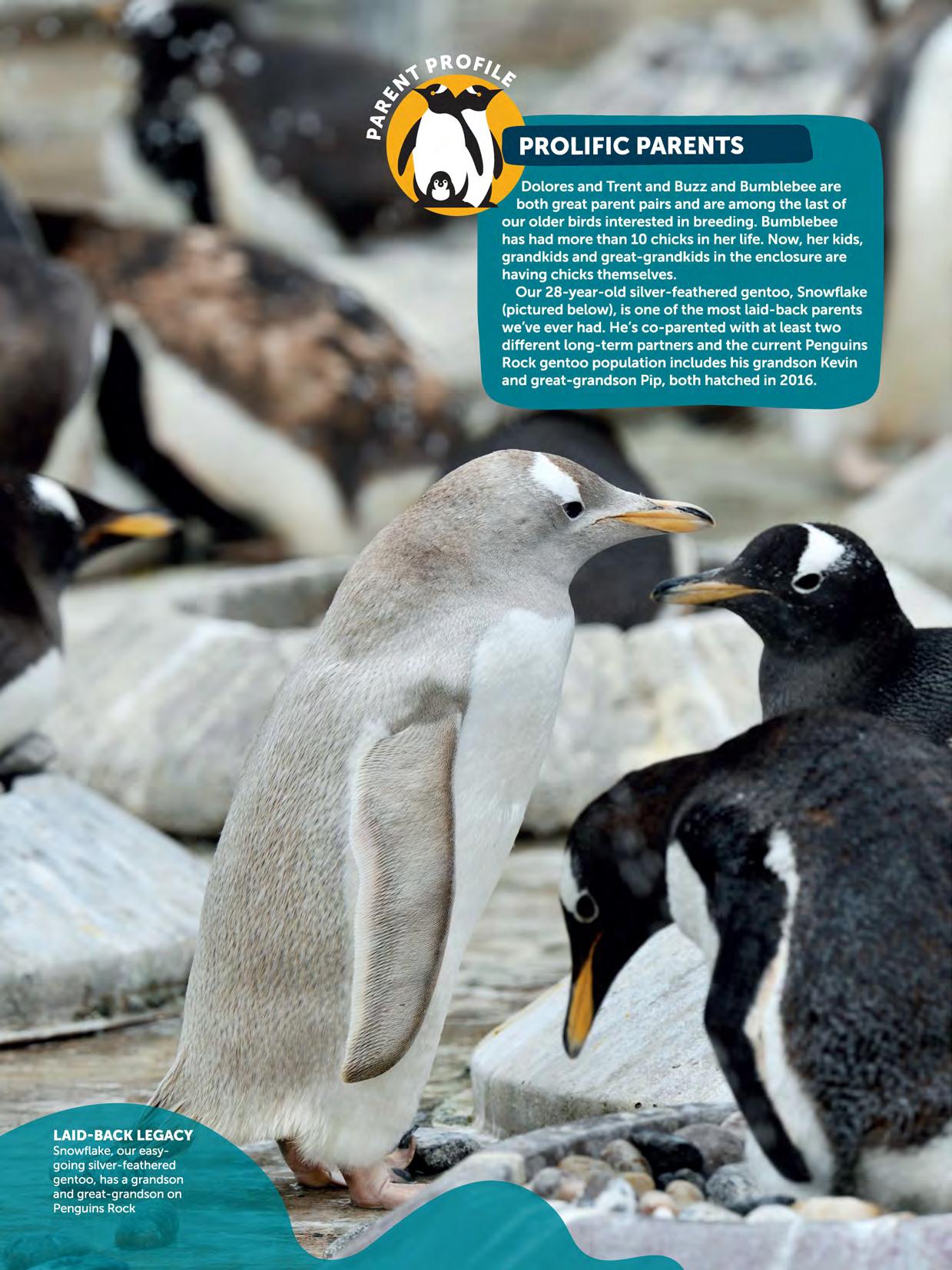
"I think the main quality that successful penguin parents have is that they're so attuned to reading their chicks' behaviour. This helps them respond quickly to whatever their offspring needs," says Dawn.
"Iffirst-time parents are struggling, we'll give their chicks a little extra food. We want chicks to stay with their parents as long as possible, so the adults learnt the parenting ropes. That way, they'll be better equipped if they breed the following year."
However, if parents are having a really hard time, Dawn and the team can rely on foster pairs.
"We always ensure there's foster parent pairs on standby who're ready to take on chicks if needed," says Dawn. "Although we'll get involved in rearing if necessary, it's best for the chicks if they're brought up by other penguins."
Penguin personalities
According to Dawn, chicks tend to have opposite temperaments to their parents. For example, Colin the gentoo is so chilled but always has really angsty chicks. As the chicks get older, their personalities only get stronger. And so too do their demands for food. By the three-month mark, they're ready to enter an exciting new chapter of their young lives
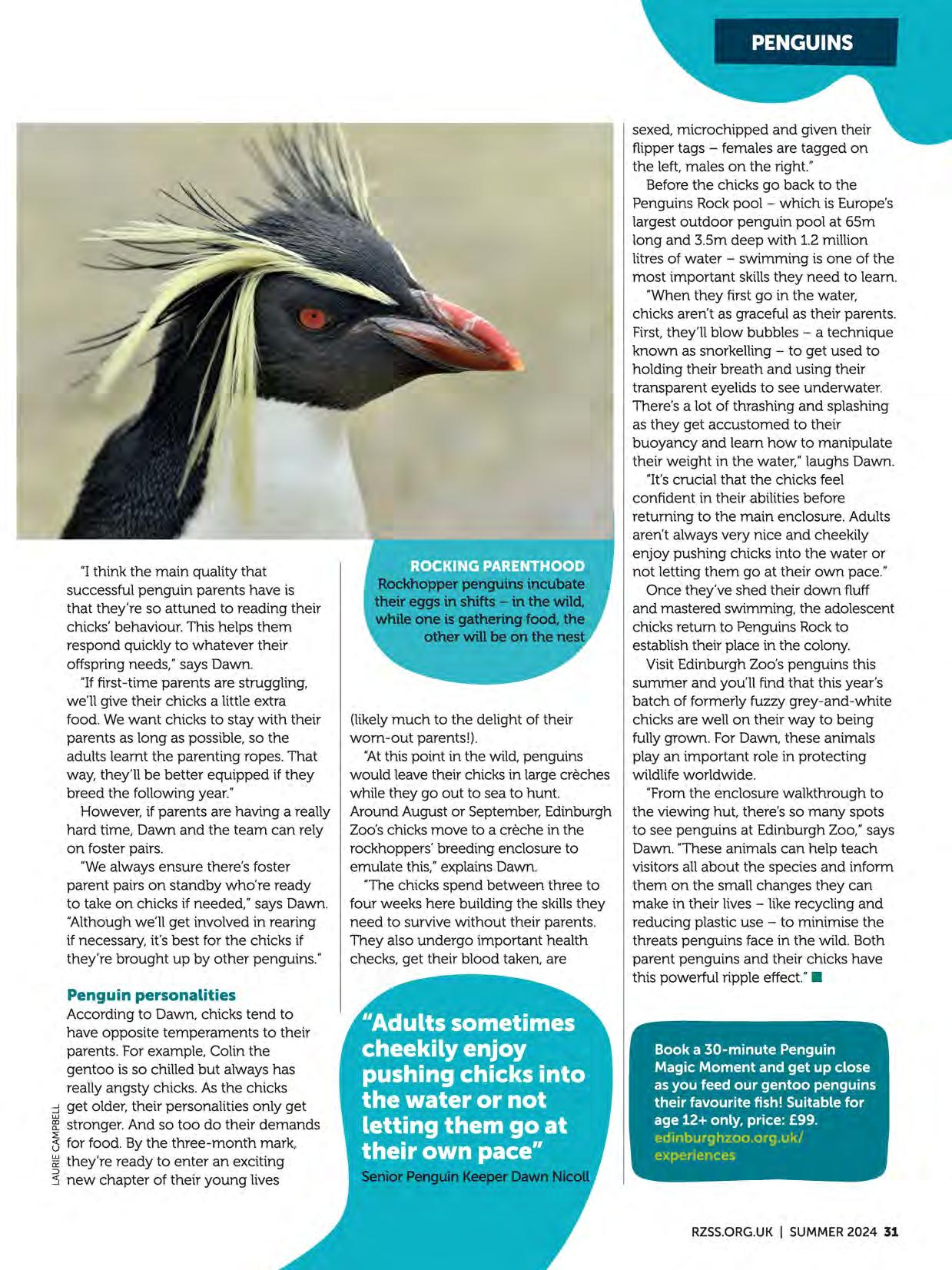
Rockhopperpenguins incubate their eggs in shifts -in the wild, while one is gatheringfood, the other will be on the nest
(likelymuch to the delight of their worn-out parents!).
"Atthis point in the wild, penguins would leave their chicks in large creches while they go out to sea to hunt.
Around August or September, Edinburgh Zoo's chicks move to a creche in the rockhoppers' breeding enclosure to emulate this," explains Dawn.
"The chicks spend between three to four weeks here building the skills they need to survive without their parents. They also undergo important health checks, get their blood taken, are
sexed, microchipped and given their flipper tags -females are tagged on the left, males on the right."
Before the chicks go back to the Penguins Rock pool -which is Europe's largest outdoor penguin pool at 65m long and 3.Sm deep with 1.2 million litres of water -swimming is one of the most important skills they need to learn.
"When they first go in the water, chicks aren't as graceful as their parents. First, they'll blow bubbles -a technique known as snorkelling -to get used to holding their breath and using their transparent eyelids to see underwater. There's a lot of thrashing and splashing as they get accustomed to their buoyancy and learn how to manipulate their weight in the water," laughs Dawn.
"It's crucial that the chicks feel confident in their abilities before returning to the main enclosure. Adults aren't always very nice and cheekily enjoy pushing chicks into the water or not letting them go at their own pace."
Once they've shed their down fluff and mastered swimming, the adolescent chicks return to Penguins Rock to establish their place in the colony.
Visit Edinburgh Zoo's penguins this summer and you'll find that this year's batch of formerly fuzzy grey-and-white chicks are well on their way to being fully grown. For Dawn, these animals play an important role in protecting wildlife worldwide.
"From the enclosure walkthrough to the viewing hut, there's so many spots to see penguins at Edinburgh Zoo," says Dawn. "These animals can help teach visitors all about the species and inform them on the small changes they can make in their lives -like recycling and reducing plastic use -to minimise the threats penguins face in the wild. Both parent penguins and their chicks have this powerful ripple effect."
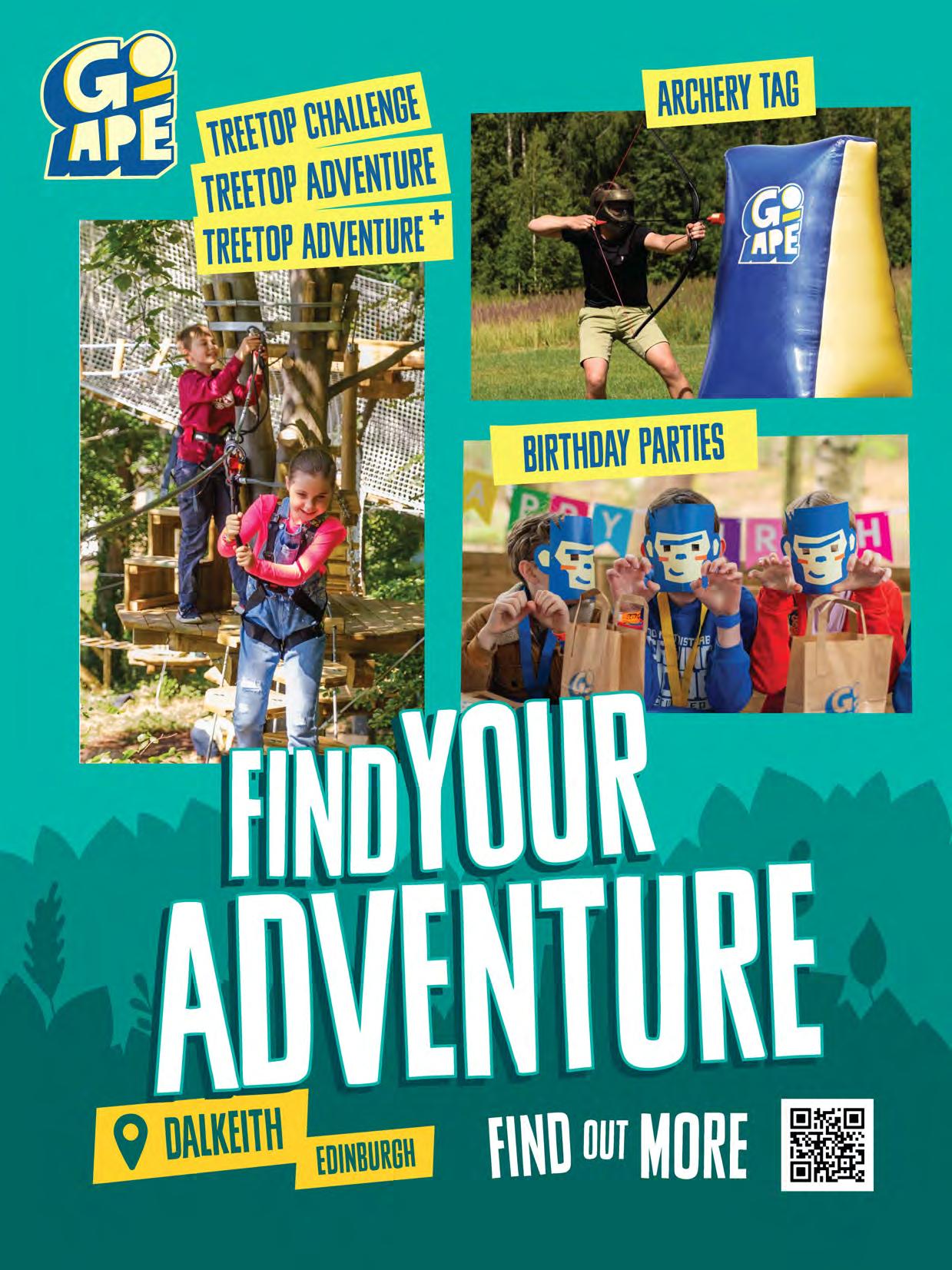
lRlHOf~O~lNlURl -"-- ::.'-'TRmDPAOVENTUR( +
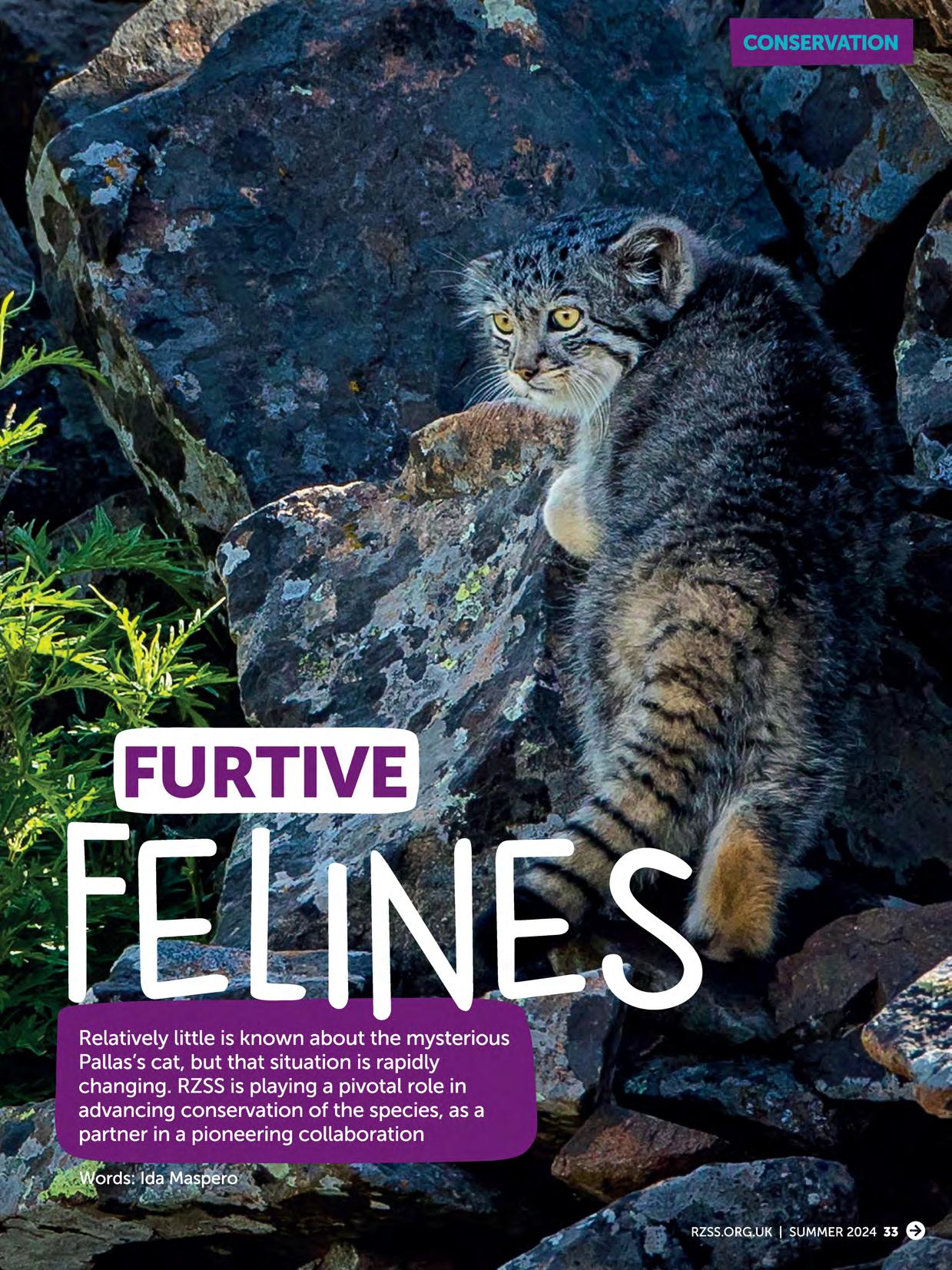
With its endearing scowl, stocky stature and voluminous fur, there would be no mistaking the identity of this feline if you were to come across it in the wild. But the chances of that are vanishingly slim.
Solitary, secretive and hardy, the Pallas's cat, or manul, is a denizen of the o::vast steppes and bitterly cold, remote w 5 mountain ranges of much of Eurasia. It toughs out extreme conditions, hunting small rodents and using marmot iiiburrows and rocky crevices as dens.
Though it has an enormous range spanning 16 countries -from Turkmenistan and Iran in the west to Mongolia and China in the east -it is ii incredibly elusive and very rarely seen. § "Asa result of that and the fact that its population is fragmented and sparse 8:across much of this enormous range,
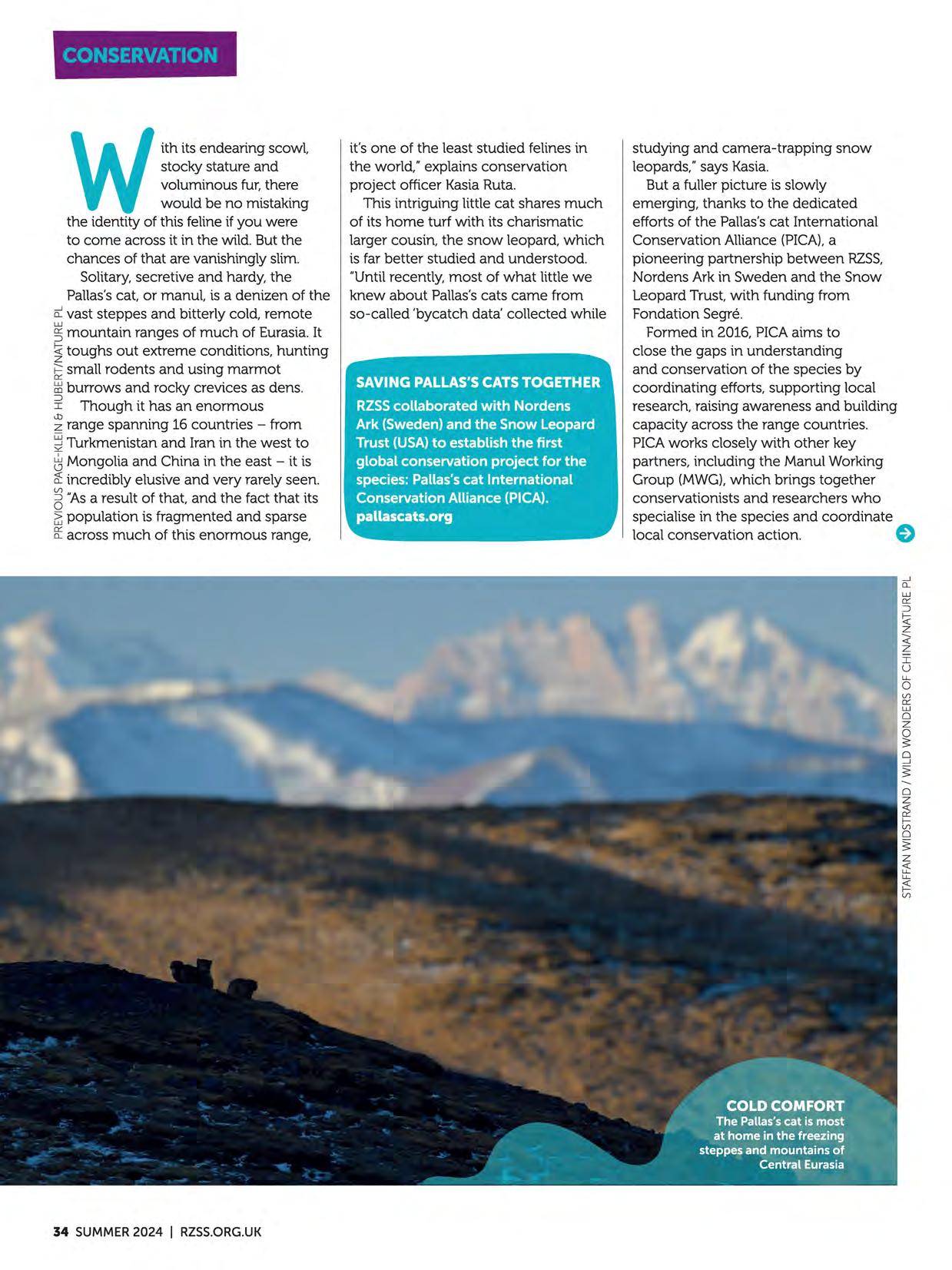
it's one of the least studied felines in the world," explains conservation project officer Kasia Ruta.
This intriguing little cat shares much of its home turf with its charismatic larger cousin, the snow leopard, which is far better studied and understood.
"Until recently, most of what little we knew about Pallas's cats came from so-called 'bycatch data' collected while
RZSS collaborated with Nordens Ark (Sweden} and the Snow Leopard Trust (USA} to establish the first global conservation project for the species: Pallas's cat International Conservation Alliance (PICA}. pallascats.org
studying and camera-trapping snow leopards," says Kasia.
But a fuller picture is slowly emerging, thanks to the dedicated efforts of the Pallas's cat International Conservation Alliance (PICA),a pioneering partnership between RZSS, Nordens Ark in Sweden and the Snow Leopard Trust, with funding from Fondation Segre.
Formed in 2016, PICA aims to close the gaps in understanding and conservation of the species by coordinating efforts, supporting local research, raising awareness and building capacity across the range countries. PICAworks closely with other key partners, including the Manul Working Group (MWG),which brings together conservationists and researchers who specialise in the species and coordinate local conservation action.
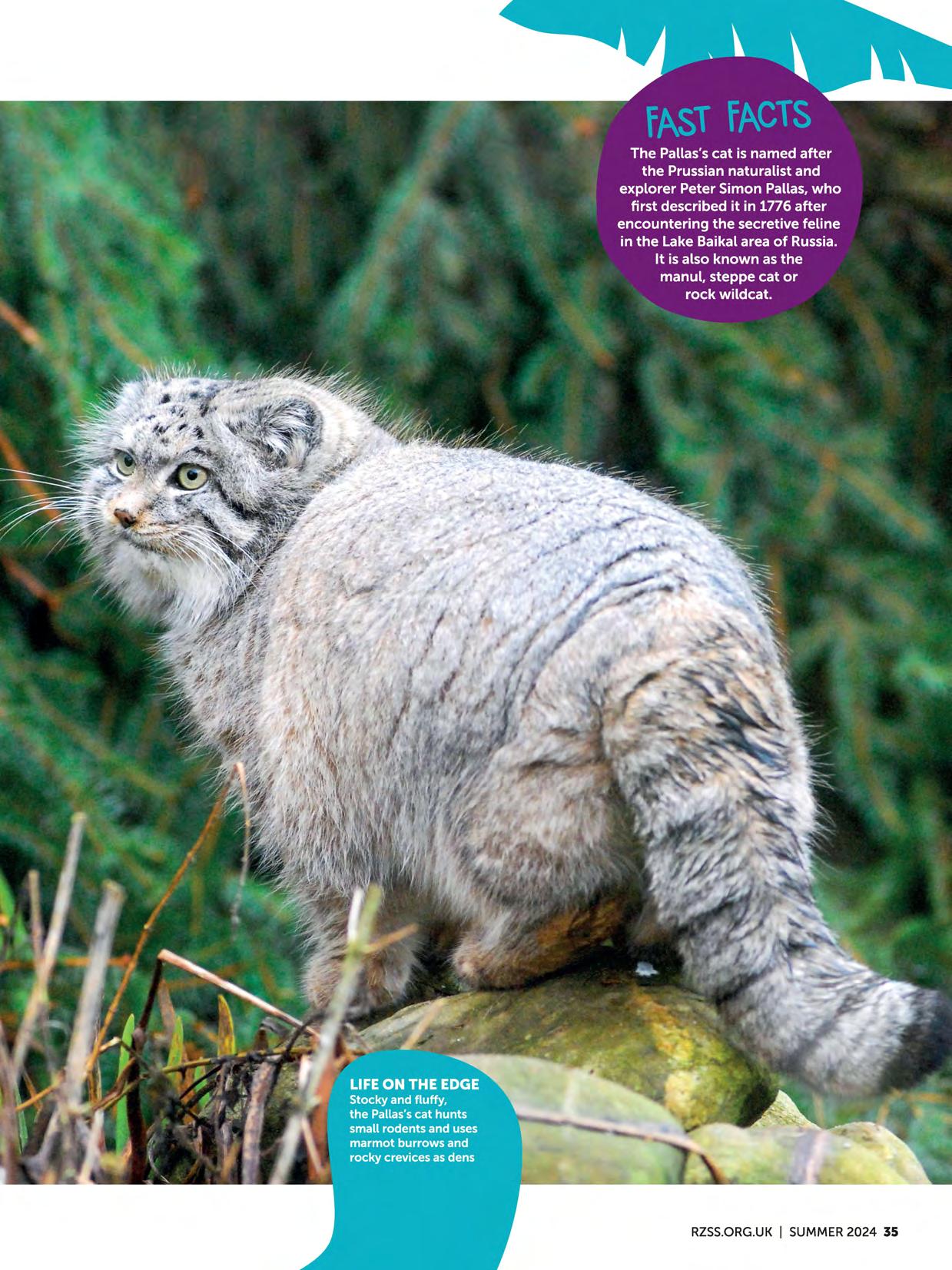
o:: "PICAis a great example of how zoos like those run by RZSScan be involved in conservation in the wild," says Kasia.
z "One of its core activities is a small
O' iii grant programme which, so far, has supported 12 projects in 10 countries. These funded projects respond to local conservation challenges and needs, and include baseline surveys and dedicated camera trapping to gather vital data, as well as community education and threat mitigation initiatives."
Although the Pallas's cat is classed as a species of least concern on the International Union for Conservation of Nature (IVCN)Red List,its future is
by no means secure. 'The IVCNstatus might raise the question: why should we care? Why should we work with these cats?" admits Kasia."Due to its vast range, it's true that the species is unlikely to go globally extinct in the near future. However, what that doesn't tell you is
"There may be a risk of regional extinction. There's so much we don't know yet"
Kasia Ruta, Conservation Project Officer
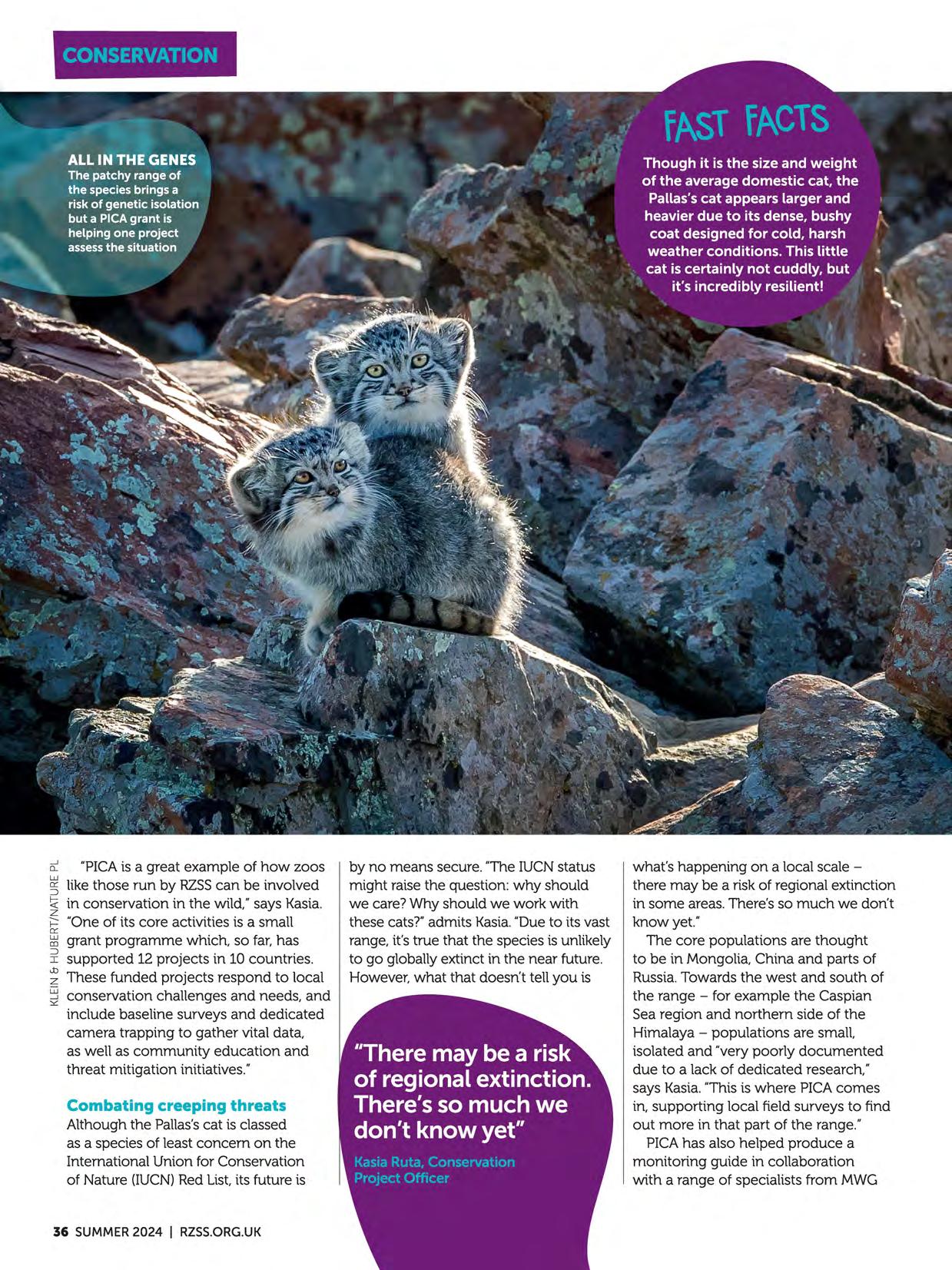
what's happening on a local scalethere may be a risk of regional extinction in some areas. There's so much we don't know yet."
The core populations are thought to be in Mongolia, China and parts of Russia. Towards the west and south of the range -for example the Caspian Sea region and northern side of the Himalaya -populations are small, isolated and "very poorly documented due to a lack of dedicated research," says Kasia."This is where PICAcomes in, supporting local field surveys to find out more in that part of the range."
PICAhas also helped produce a monitoring guide in collaboration with a range of specialists from MWG
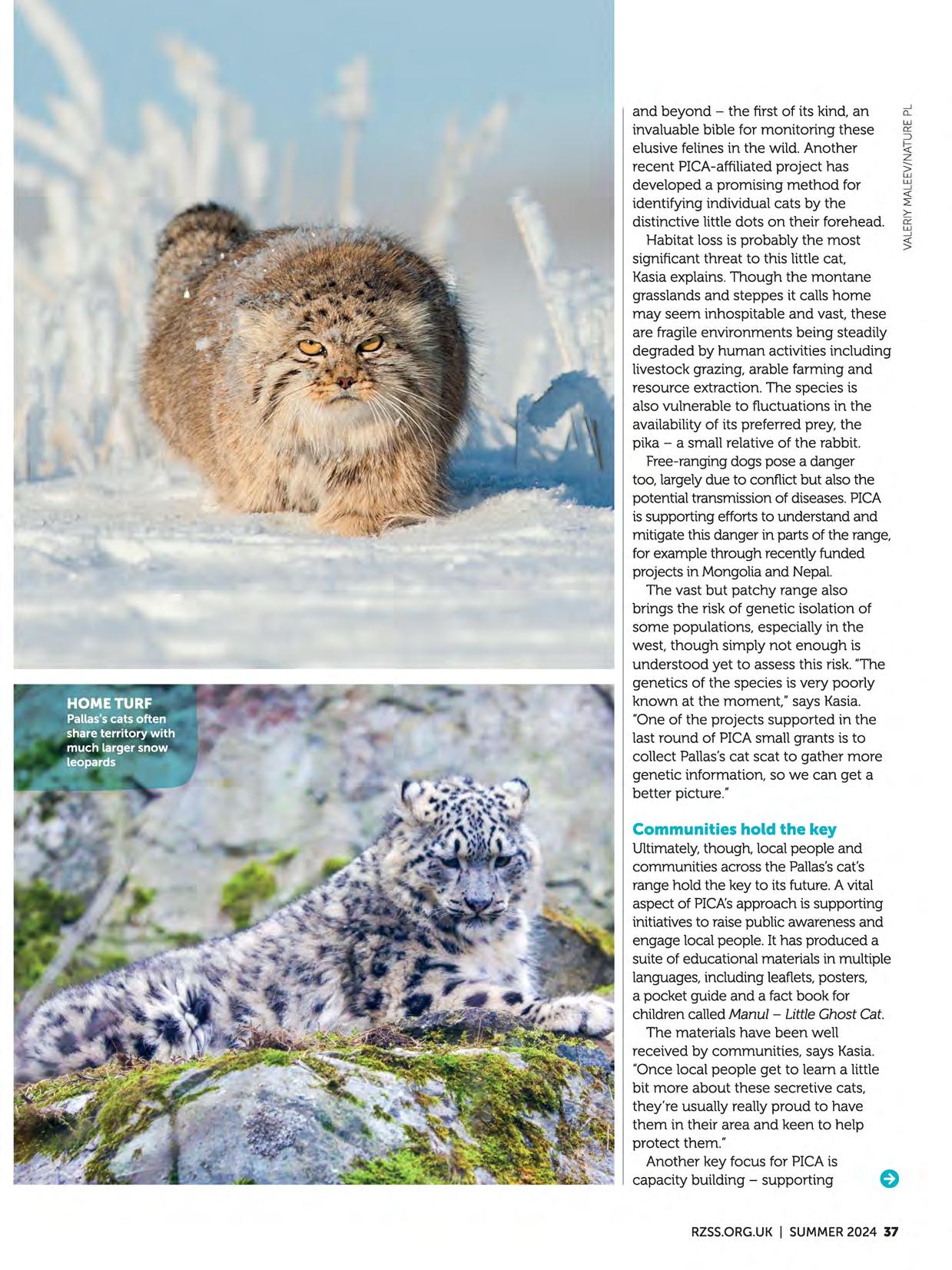
and beyond -the first of its kind, an invaluable bible for monitoring these elusive felines in the wild. Another recent PICA-affiliatedproject has developed a promising method for identifying individual cats by the distinctive little dots on their forehead.
Habitat loss is probably the most significant threat to this little cat, Kasia explains. Though the montane grasslands and steppes it calls home may seem inhospitable and vast, these are fragile environments being steadily degraded by human activities including livestock grazing, arable farming and resource extraction. The species is also vulnerable to fluctuations in the availability of its preferred prey, the pika -a small relative of the rabbit.
Free-ranging dogs pose a danger too, largely due to conflict but also the potential transmission of diseases. PICA is supporting efforts to understand and mitigate this danger in parts of the range, for example through recently funded projects in Mongolia and Nepal.
The vast but patchy range also brings the risk of genetic isolation of some populations, especially in the west, though simply not enough is understood yet to assess this risk. "The genetics of the species is very poorly known at the moment," says Kasia. "One of the projects supported in the last round of PICAsmall grants is to collect Pallas's cat scat to gather more genetic information, so we can get a better picture."
Ultimately,though, local people and communities across the Pallas's cat's range hold the key to its future. A vital aspect of PICAsapproach is supporting initiatives to raise public awareness and engage local people. It has produced a suite of educational materials in multiple languages, including leaflets, posters, a pocket guide and a fact book for children called Manul - Little Ghost Cat.
The materials have been well received by communities, says Kasia. "Once local people get to learn a little bit more about these secretive cats, they're usually really proud to have them in their area and keen to help protect them."
Another key focus for PICAis capacity building -supporting 0
o" and expanding home-grown skills and expertise in the species· range !;,: countries. This involves connecting z ffiexperienced conservationists and researchers with budding young 8 local scientists, and providing expert z training in vital skills -from fieldwork <( techniques to writing reports and grant vi funding applications.
"We'll continue to work with our partners to build capacity and support field research"
Though local initiatives are crucial, global recognition is vital too. In February this year, PICAand its partners celebrated a major milestone they'd long been working towards and advocating for -the listing of the Pallas's cat under the Convention on Migratory Species (CMS).This was approved in a landmark decision at COP14 in Uzbekistan.
"It's a hugely significant achievement and will have immensely positive benefits for the cats on a global scale," explains Kasia."In the first instance, it will have put them on the global agenda and boosted awareness amongst politicians, governments and the wider public in the range countries.
"Secondly, the listing also encourages collaboration across borders, which is
very important for a species that occurs in pockets across so many countries. And finally,it provides a platform for even more concrete conservation action, as it obligates governments to consider the species in policymaking."
With the CMSlisting secured and the small grant programme expanding its support, PICAis going from strength to strength, says Kasia.
"We'llcontinue to work with our partners to build capacity and to support local field research. In fact, we're excited to report that PICArecently began supporting a project in China -the first time we've been involved in this country, which is believed to be a stronghold in the cat's range."
Small cat conservation
Now, says Kasia, early work is also under way to apply PICA'ssuccessful collaboration model to help conserve other small cat species in Central Asia, such as the sand cat, caracal and jungle cat. "Likethe Pallas's cat, several other small cats in this part of the world are IVCN listed as of least concern, but remain extremely poorly studied.
"These small cat species are highly specialised and sensitive to changes in their habitats. This makes them excellent indicator species of habitat and ecosystem health, so studying them is also of wider conservation interest.
"We're hoping to launch a new project called Small Cats of the Silk Road, which will build on PICA's pioneering approach, so watch this space! The grumpy Pallas's cat is indeed a mascot for many other small cat

RZSSConservation Champions are helping to save 50 of the world's most endangered species from extinction. Give from £1 a week to £1 a day and join a growing group of caring people like you, committed to saving animals. Find out more at: rzss.org.uk/conservationchampions
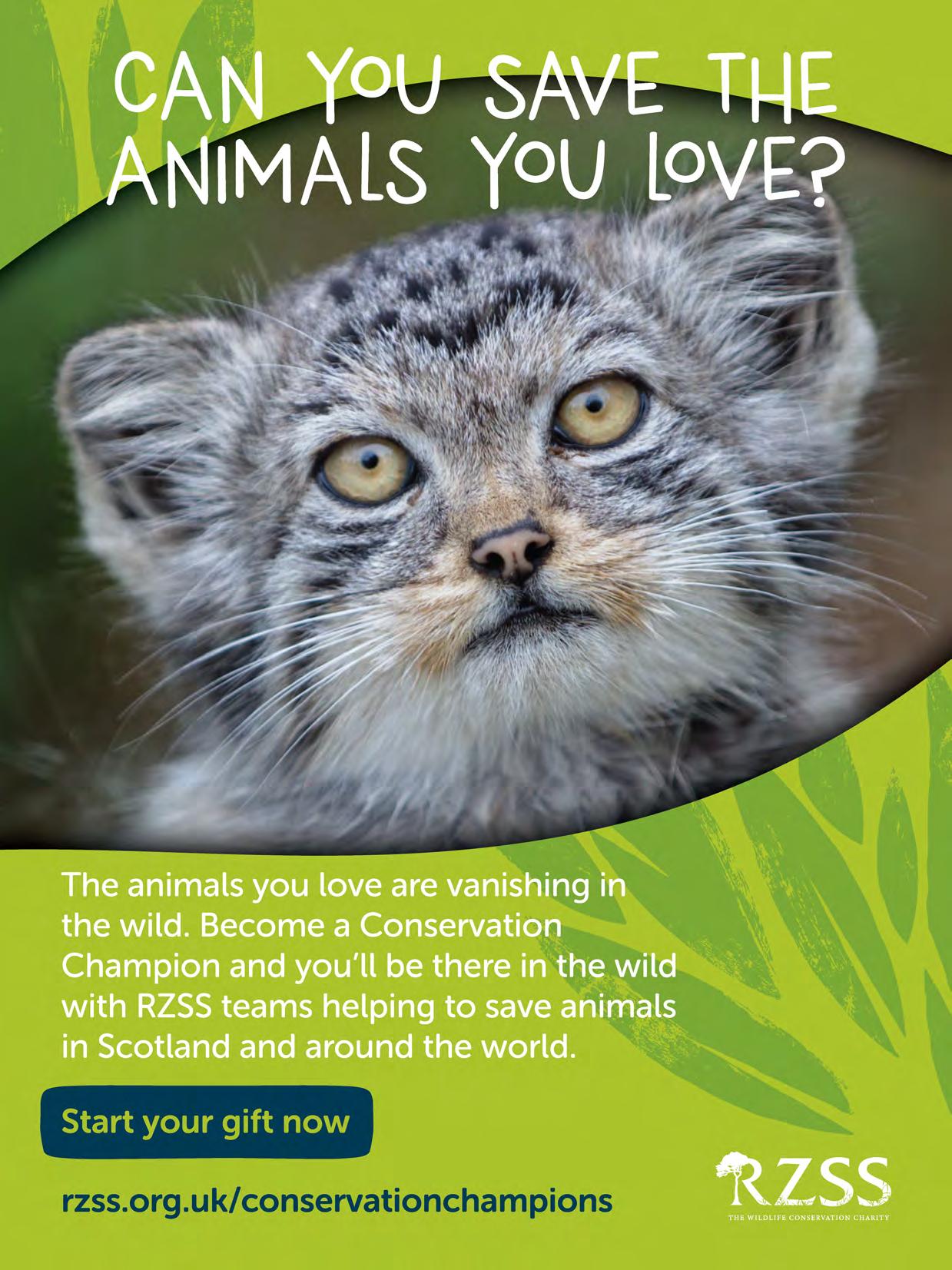
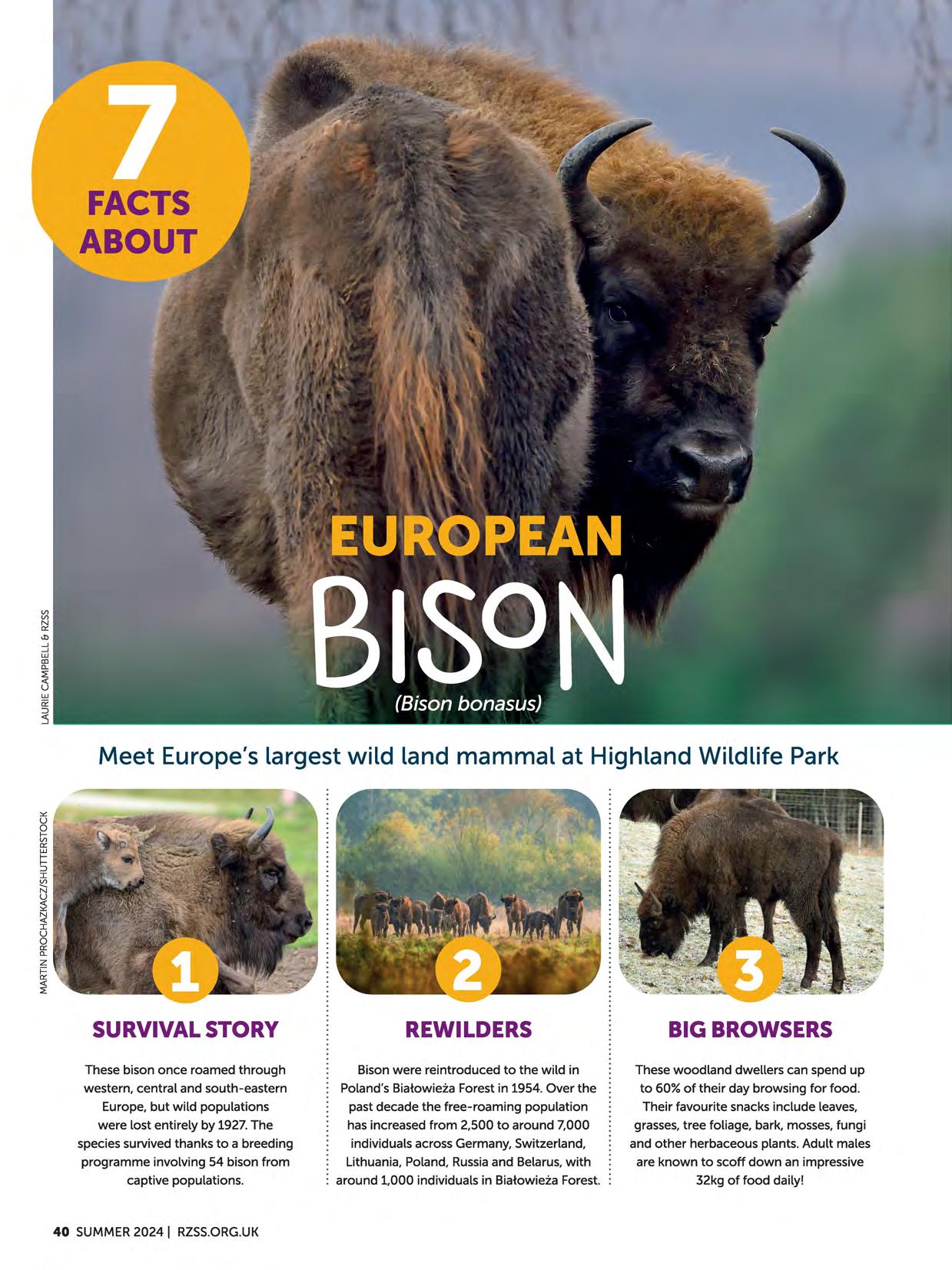
Meet Europe's largest wild land mammal at Highland Wildlife Park
These bison once roamed through western, central and south-eastern Europe, but wild populations were lost entirely by 1927. The species survived thanks to a breeding programme involving 54 bison from captive populations.
Bison were reintroduced to the wild in Poland's Biatowiei:a Forest in 1954. Over the past decade the free-roaming population has increased from 2,500 to around 7,000 individuals across Germany, Switzerland, Lithuania, Poland, Russiaand Belarus, with around 1,000 individuals in Biatowiei:a Forest.
These woodland dwellers can spend up to 60% of their day browsing for food. Their favourite snacks include leaves, grasses, tree foliage, bark, mosses, fungi and other herbaceous plants. Adult males are known to scoff down an impressive 32kg of food daily!
The bison is the heaviest land animal in Europe, with a fully grown bull weighing up to 1,000kg. Thanks to their powerful haunches, they can easily jump three-metre-wide streams from a standing start and run at speeds of up to 40 miles per hour -the same galloping pace as horses!
European bison herds tend to include either bull-only groups or mixed groups containing calves, cows, young bison between two and three years of age, and male adults. On average, there are between eight and 13 animals in each group.
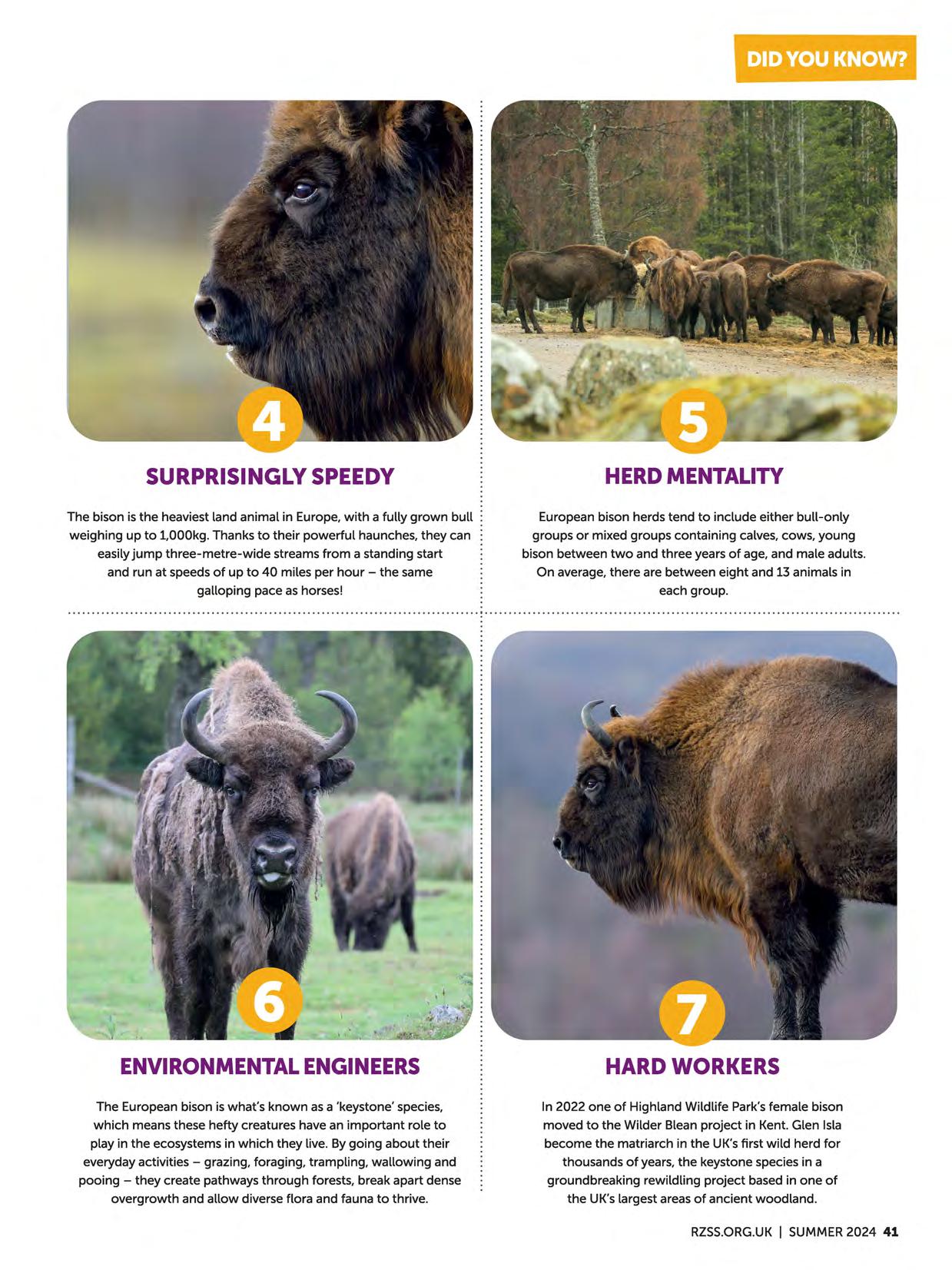
The European bison is what's known as a 'keystone' species, which means these hefty creatures have an important role to play in the ecosystems in which they live. By going about their everyday activities -grazing, foraging, trampling, wallowing and pooing -they create pathways through forests, break apart dense overgrowth and allow diverse flora and fauna to thrive.
In 2022 one of Highland Wildlife Park's female bison moved to the Wilder Blean project in Kent. Glen Isla become the matriarch in the UK's first wild herd for thousands of years, the keystone species in a groundbreaking rewildling project based in one of the UK's largest areas of ancient woodland.
Step aboard Queen Elizabeth ll's former floating palace
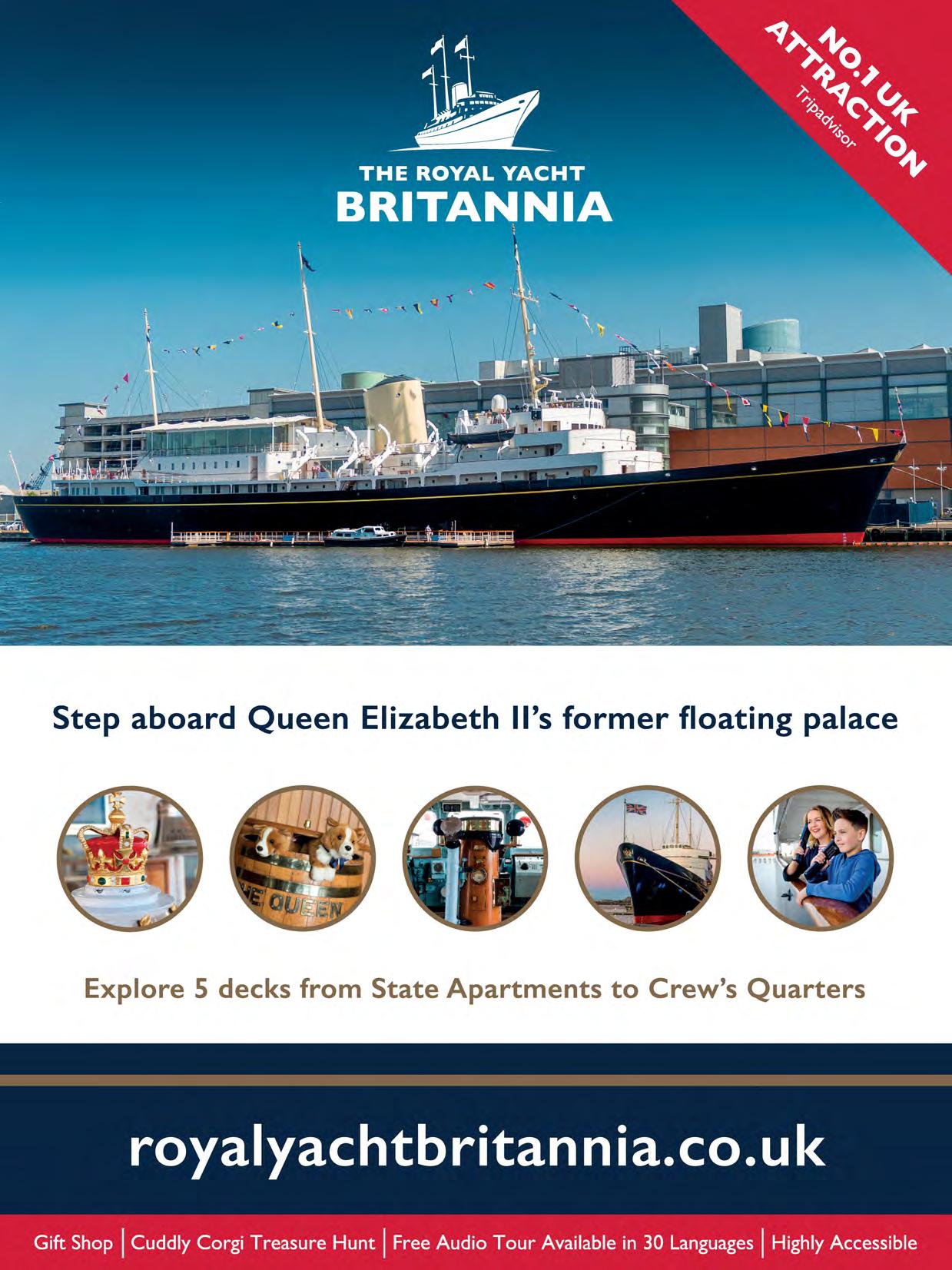
Explore 5 decks from State Apartments to Crew's Quarters
Edinburgh Zoo
f.tjtfflmfm!fifflllam-12pm
These popular talks are continuing over the summer and offer a wonderful opportunity to learn more about the animals you love. Join us for a natter and a brew at the zoo with the friendly RZSSteam in the stunning setting of the Mansion House at Edinburgh Zoo.
• Tuesday 11 June - Sloths and armadillos
• Thursday 18 July - Red pandas and sun bears
• Tuesday 13 August - Giraffes (with BSL interpreter)
• Thursday 12 September - Big cats
Tickets include entry to Edinburgh Zoo. Adult: £35. Adult member: £10.
To book: edinburghzoo.org.uk/tea-and-talks
Edinburgh Zoo
~titmi@G!fiffi
Meet one of our experts for a one-hour guided tour of the zoo before we open. Enjoy an early morning visit as you learn amazing new facts about the species we care for and the conservation work carried out by RZSS.Tours begin at 9am, starting from our members gate in the car park. Please note, pre-booking is essential.
• Sunday 23 June
• Sunday 21 July
• Sunday 25 August
• Saturday 7 September
Tickets include entry to Edinburgh Zoo. Adult: £35. Child: £25. Member: £10.
To book: edinburghzoo.org.uk/sunrise-safaris
Edinburgh Zoo
Until 31 July I 7
This summer, visitors to Edinburgh Zoo will come face-to-face with 25 incredible animal sculptures on our amazing interactive Brick Safari trail. Created using 1.5m toy bricks, the models include a seven-foot-tall Bengal tiger, a giant panda, an African elephant and a gorilla. Our Brick Safari will also feature interactive selfie zones, including a sit-in jeep made from more than 70,000 toy bricks. Members and visitors can enjoy Edinburgh Zoo Brick Safari this summer with regular admission.
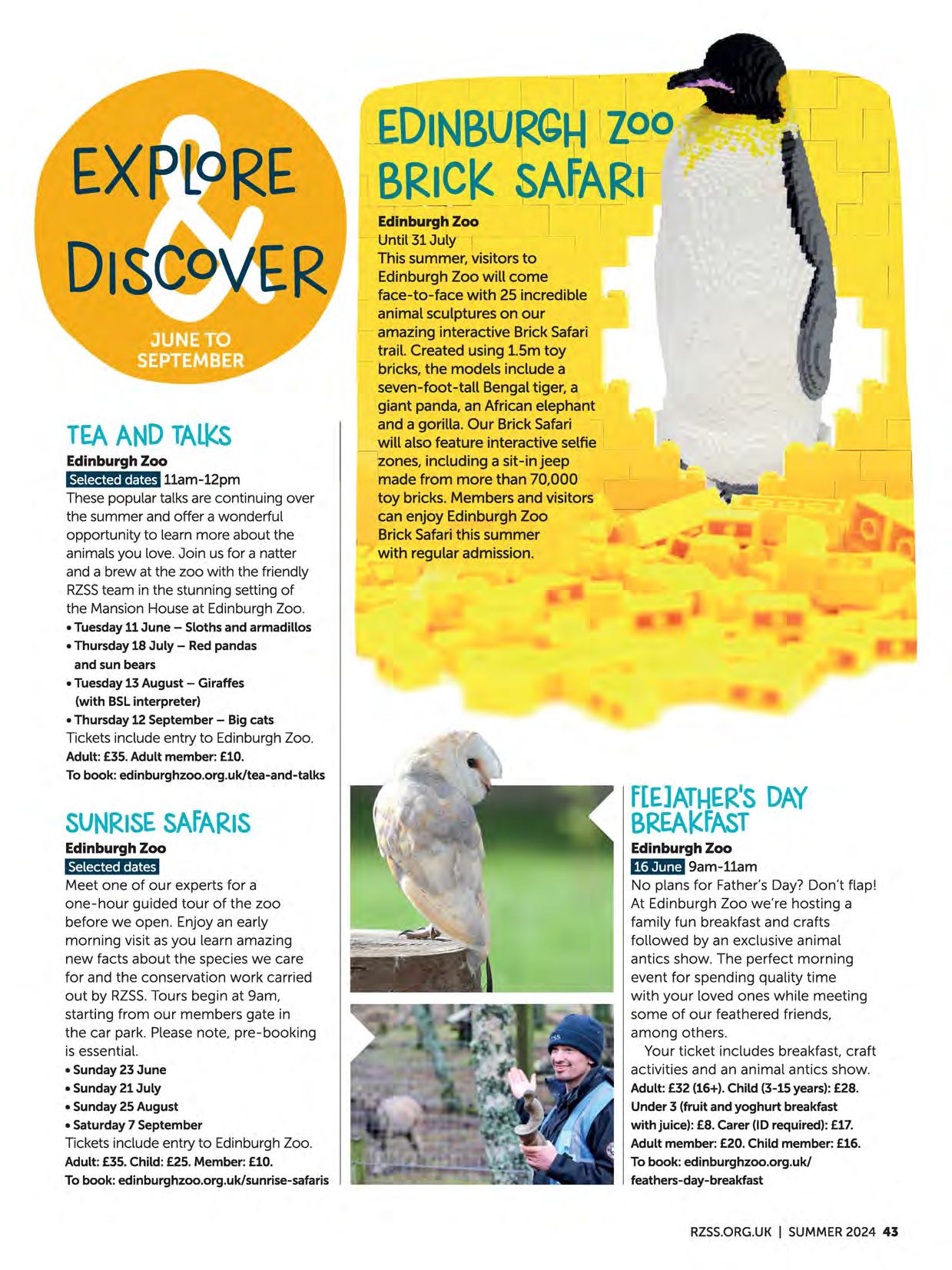
Edinburgh Zoo ltsfii!lei49am-llam
No plans for Father's Day? Don't flap! At Edinburgh Zoo we're hosting a family fun breakfast and crafts followed by an exclusive animal antics show. The perfect morning event for spending quality time with your loved ones while meeting some of our feathered friends, among others.
Your ticket includes breakfast, craft activities and an animal antics show. Adult: £32 (16+). Child (3-15 years): £28. Under 3 (fruit and yoghurt breakfast with juice): £8. Carer (ID required): £17. Adult member: £20. Child member: £16.
To book: edinburghzoo.org.uk/ feathers-day-breakfast
Edinburgh Zoo t,H@,146pm-8pm
Back for a second year, we're celebrating the brighter nights and World Giraffe Day with a summer soiree.
The evening will begin with an exclusive guided tour of the zoo after closing, followed by a talk at the giraffe house with drinks courtesy of Glenmorangie. RZSSis now in the fourth year of a unique partnership with Glenmorangie and the Giraffe (How animalsthink)
(How animalsplay)
Conservation Foundation to conserve giraffes in Africa. Through science and genetic expertise, the partnership is helping to reverse the decline in this much-loved species and give hope for their future. Entry for this event is through our members gate at the top of the Edinburgh Zoo car park.
Please note this event is suitable for adults aged 18+. For further information please contact events@rzss.org.uk.Adults: £20. Members: £15. To book: edinburghzoo.org. uk/summer-soiree
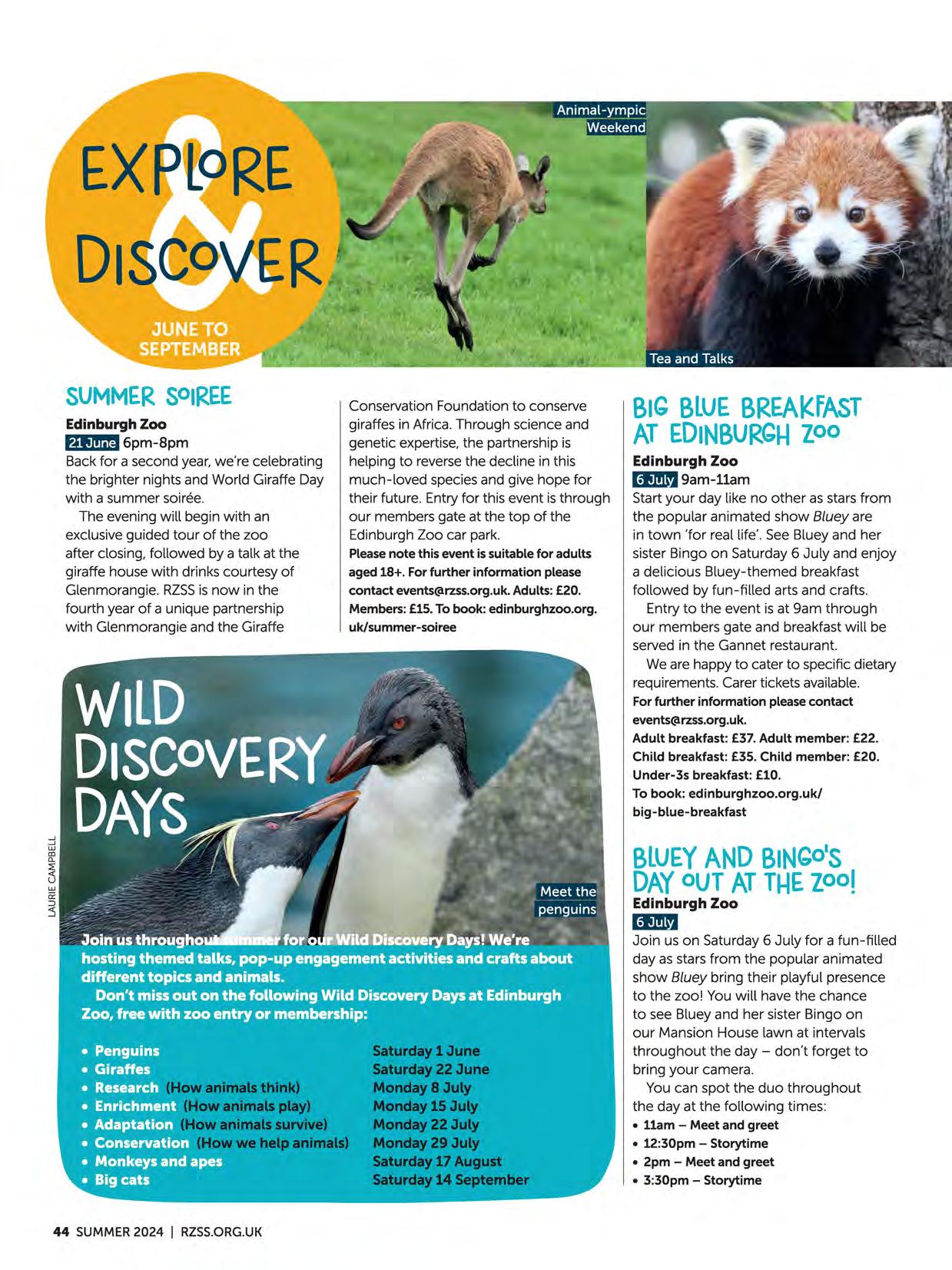
(How animalssurvive) (How we help animals)
Saturday1
Edinburgh Zoo mL!Jl9am-11am
Start your day like no other as stars from the popular animated show Bluey are in town 'for real life'. See Bluey and her sister Bingo on Saturday 6 July and enjoy a delicious Bluey-themed breakfast followed by fun-filled arts and crafts. Entry to the event is at 9am through our members gate and breakfast will be served in the Gannet restaurant.
We are happy to cater to specific dietary requirements. Carer tickets available. For further information please contact events@rzss.org.uk.
Adult breakfast: £37. Adult member: £22. Child breakfast: £35. Child member: £20. Under-3s breakfast: £10. To book: edinburghzoo.org.uk/ big-blue-breakfast
Edinburgh Zoo mm
Join us on Saturday 6 July for a fun-filled day as stars from the popular animated show Bluey bring their playful presence to the zoo! You will have the chance to see Bluey and her sister Bingo on our Mansion House lawn at intervals throughout the day -don't forget to bring your camera.
You can spot the duo throughout the day at the following times:
• 11am - Meet and greet
• 12:30pm - Storytime
• 2pm - Meet and greet
• 3:30pm -Storytime
For your chance to see Bluey and Bingo, admission tickets to Edinburgh Zoo are essential. Please note we do not have specific tickets for attending the meet and greets or storytime sessions.There is a designated performance area for these appearances that guests can attend on a first-come, first-served basis. To book: edinburghzoo.org.uk/ bluey-and-bingo
Edinburgh Zoo
t-iihi 0 H:lffl@9am-11am
To celebrate the opening of the Olympics, we're hosting some ZOO-per games of our own! Join E5us on Saturday 27 and Sunday 28 July ft and see how you compare with UJ 0 some of our species in challenges ci of strength, speed and more.
Free with zoo entry.
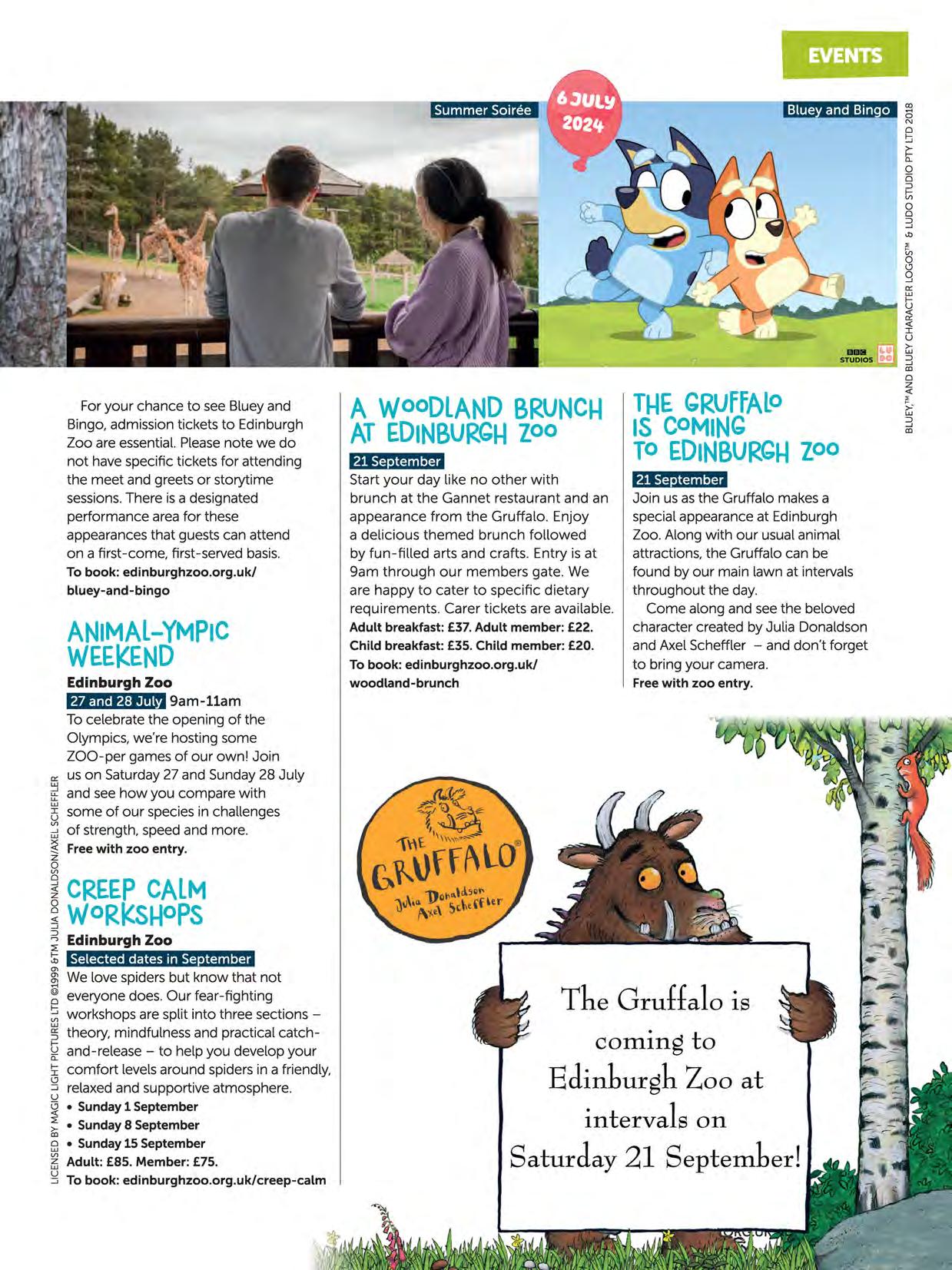
Edinburgh Zoo
Selected dates in September
We love spiders but know that not everyone does. Our fear-fighting workshops are split into three sectionsUJ theory, mindfulness and practical catchQ and-release -to help you develop your j: comfort levels around spiders in a friendly, CJ relaxed and supportive atmosphere.
\?
0
• Sunday 1 September
• Sunday 8 September
• Sunday 15 September
Adult: £85. Member: £75.
To book: edinburghzoo.org.uk/creep-calm
Start your day like no other with brunch at the Gannet restaurant and an appearance from the Gruffalo. Enjoy a delicious themed brunch followed by fun-filled arts and crafts. Entry is at 9am through our members gate. We are happy to cater to specific dietary requirements. Carer tickets are available. Adult breakfast: £37. Adult member: £22. Child breakfast: £35. Child member: £20.
To book: edinburghzoo.org.uk/ woodland-brunch
Join us as the Gruffalo makes a special appearance at Edinburgh Zoo. Along with our usual animal attractions, the Gruffalo can be found by our main lawn at intervals throughout the day.
Come along and see the beloved character created by Julia Donaldson and Axel Scheffler -and don't forget to bring your camera. Free with zoo entry.
The Gruff alo 1s coming to Edinburgh Zoo at intervals on Saturday 21 September!
We are ce ebrating our charity's important work leading the Saving Wildcats project with a pawsatively purrfect range of wildcat-themed gifts 4RZSS
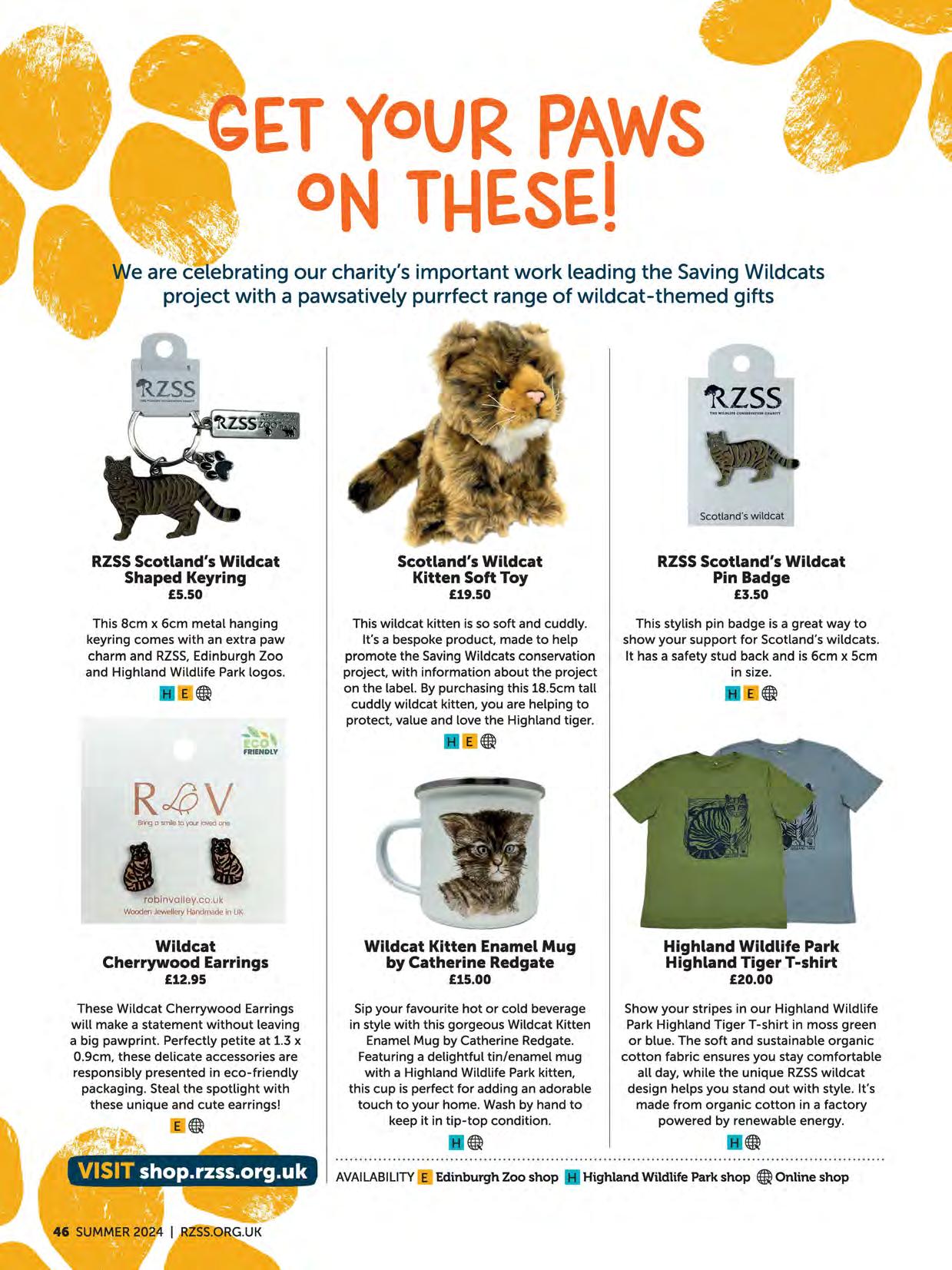
RZSSScotland's Wildcat Shaped Keyring
£5.50
This 8cm x 6cm metal hanging keyring comes with an extra paw charm and RZSS,Edinburgh Zoo and Highland Wildlife Park logos.
Scotland's Wildcat Kitten Soft Toy
£19.50
This wildcat kitten is so soft and cuddly. It's a bespoke product, made to help promote the Saving Wildcats conservation project, with information about the project on the label. By purchasing this 18.5cm tall cuddly wildcat kitten, you are helping to protect, value and love the Highland tiger.
RZSSScotland's Wildcat Pin Badge
£3.50
This stylish pin badge is a great way to show your support for Scotland's wildcats. It has a safety stud back and is 6cm x 5cm in size.
Wildcat Cherrywood Earrings
£12.95
These Wildcat Cherrywood Earrings will make a statement without leaving a big pawprint. Perfectly petite at 1.3 x 0.9cm, these delicate accessories are responsibly presented in eco-friendly packaging. Steal the spotlight with these unique and cute earrings!
Wildcat Kitten Enamel Mug by Catherine Redgate
£15.00
Sip your favourite hot or cold beverage in style with this gorgeous Wildcat Kitten Enamel Mug by Catherine Redgate. Featuring a delightful tin/enamel mug with a Highland Wildlife Park kitten, this cup is perfect for adding an adorable touch to your home. Wash by hand to keep it in tip-top condition.
Highland Wildlife Park Highland Tiger T-shirt
£20.00
Show your stripes in our Highland Wildlife Park Highland Tiger T-shirt in moss green or blue. The soft and sustainable organic cotton fabric ensures you stay comfortable all day, while the unique RZSSwildcat design helps you stand out with style. It's made from organic cotton in a factory powered by renewable energy.
Bold colours and characterful creatures are central to artist Ally Smith's work, now available to buy at Edinburgh Zoo's shop
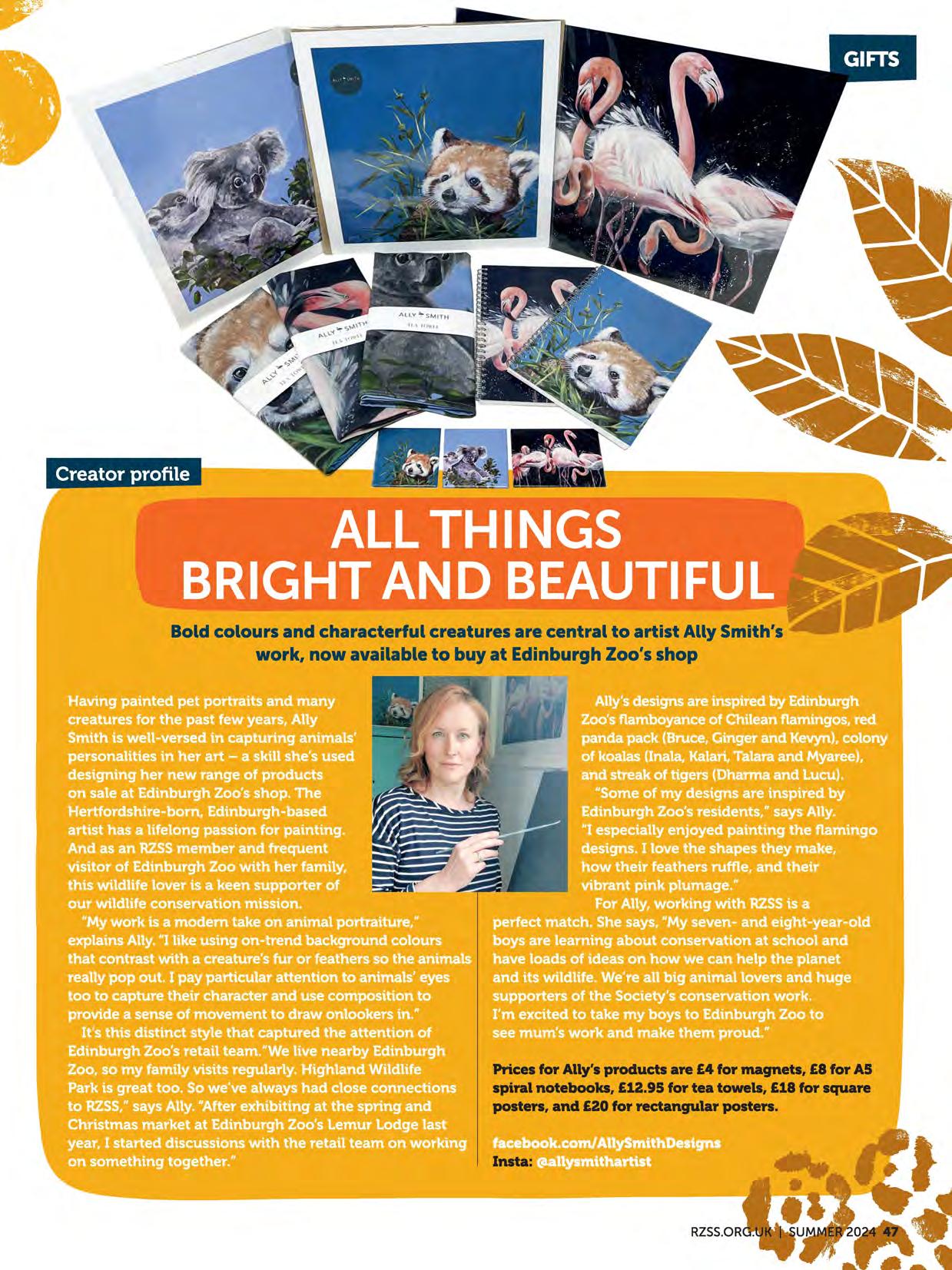
Prices for Ally's products are £4 for magnets, £8 for AS spiral notebooks, £12.95 for tea towels, £18 for square posters, and £20 for rectangular posters.
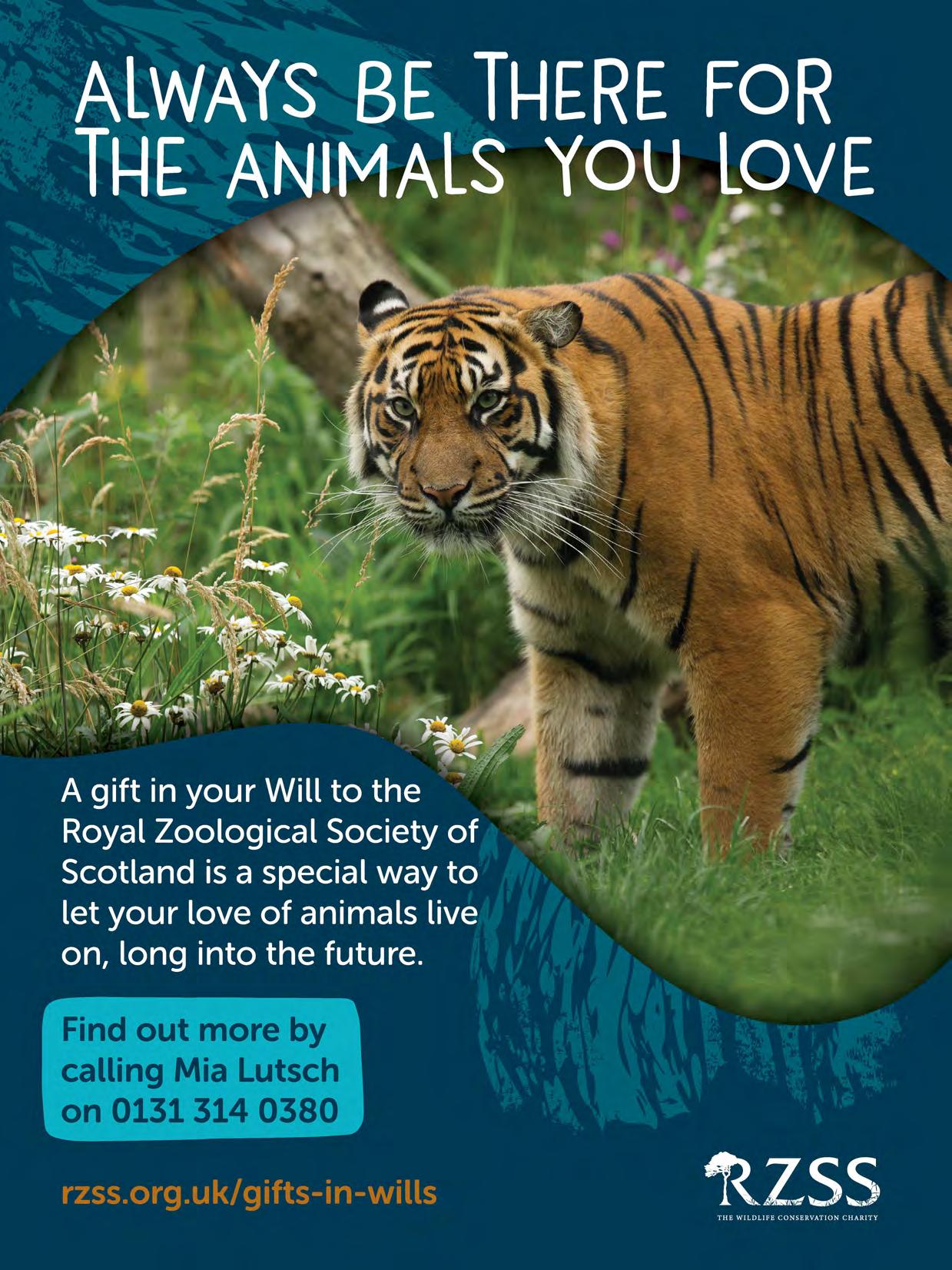
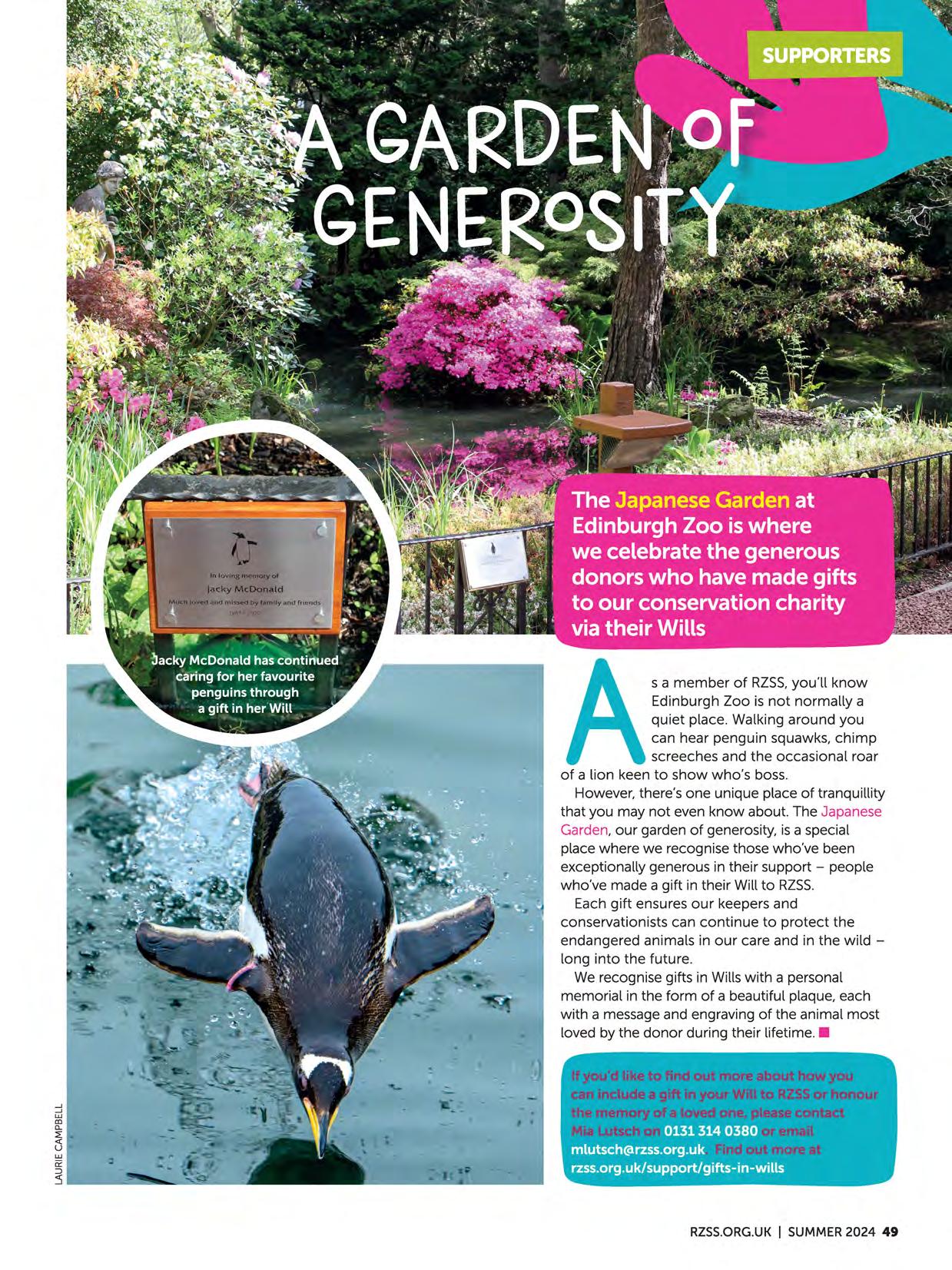
s a member of RZSS,you'll know Edinburgh Zoo is not normally a quiet place. Walking around you can hear penguin squawks, chimp screeches and the occasional roar of a lion keen to show who's boss.
However, there's one unique place of tranquillity that you may not even know about. The Japanese Garden, our garden of generosity, is a special place where we recognise those who've been exceptionally generous in their support -people who've made a gift in their Will to RZSS.
Each gift ensures our keepers and conservationists can continue to protect the endangered animals in our care and in the wildlong into the future.
We recognise gifts in Wills with a personal memorial in the form of a beautiful plaque, each with a message and engraving of the animal most loved by the donor during their 0131314 0380 mlutsch@rzss.org.uk rzss.org.uk/support/gifts-in-wills
Above and below right: Tracy had the opportunity to feed red pandas at Edinburgh Zoo as well as care for giant pagas Yang Guang ar.1dTian Tian
Alifetime member of RZSS,Tracy Noden has countless happy memories of visits to Edinburgh Zoo and Highland Wildlife Park. But last year's day working as a panda keeper during Yang Guang and Tian Tian's final weeks at Edinburgh Zoo has to be the most extraordinary experience of them all.
"I've always loved animals and I appreciate how RZSSprovides the best environments for the creatures it cares for," explains the University of Edinburgh teaching planning administrator.
"I can't pick one favourite animal, but pandas are certainly in my top 10. I loved visiting them at Edinburgh Zoo."
Tracy takes part in as many of the charity's fundraising activities as possible. Little did she imagine this would lead to a once-in-a-lifetime meeting with giant pandas Yang Guang and Tian Tian.
"I entered the Crowdfunder competition to be a pander keeper for a day never dreaming anything would come of it," says Tracy. "I couldn't believe my
luck when I won. I had to read the email a few times before it sunk in."
The experience was even better than the 49-yearold Edinburgh resident imagined. "I spent the day with head panda keeper Alison Maclean. The team generously let me take part in cleaning, feeding and weighing," says Tracy. "I also helped make Yang Guang and Tian Tian's favourite treat, panda cake, which is made using a secret recipe handed to the team before the pair left China for Scotland in December 2011. This secret remains safe with me."
Tracy had plenty of time to observe Yang Guang up close, having been prepared by Alison to expect that he would warm up to visitors quicker than female panda Tian Tian.
"At the start of the day, Yang Guang was sleeping cosily. When he woke up, I was in awe seeing this gorgeous creature just a few feet away," says Tracy.
"He didn't seem fazed by me and graciously accepted the carrot sticks I offered him. I loved seeing how Yang Guang ate -his table manners are better than mine!"
Tracy loved witnessing first hand Alison and the team's commitment to Yang Guang and Tian Tian. "I can't overstate how moved I was by the dedication the team displayed. They're incredible human beings and it's heartening knowing they were there to look after the pandas," says Tracy.
As part of her Crowdfunder prize, Tracy also enjoyed a visit to the red pandas -another of her top 10 animals -to feed them fresh bamboo and grapes. However, the icing on the (panda) cake for Tracy was catching sight of Tian Tian, just as her keeper experience was wrapping up.
"The experience was especially poignant knowing that Yang Guang and Tian Tian were soon returning to China. I treasured every second with them and the day has gifted me memories I'll cherish forever," reflects Tracy. "Yang Guang and Tian Tian have left behind a fantastic legacy. They've connected so many people to the natural world by helping promote the conservation work carried out by RZSS.We have a lot to thank them for."
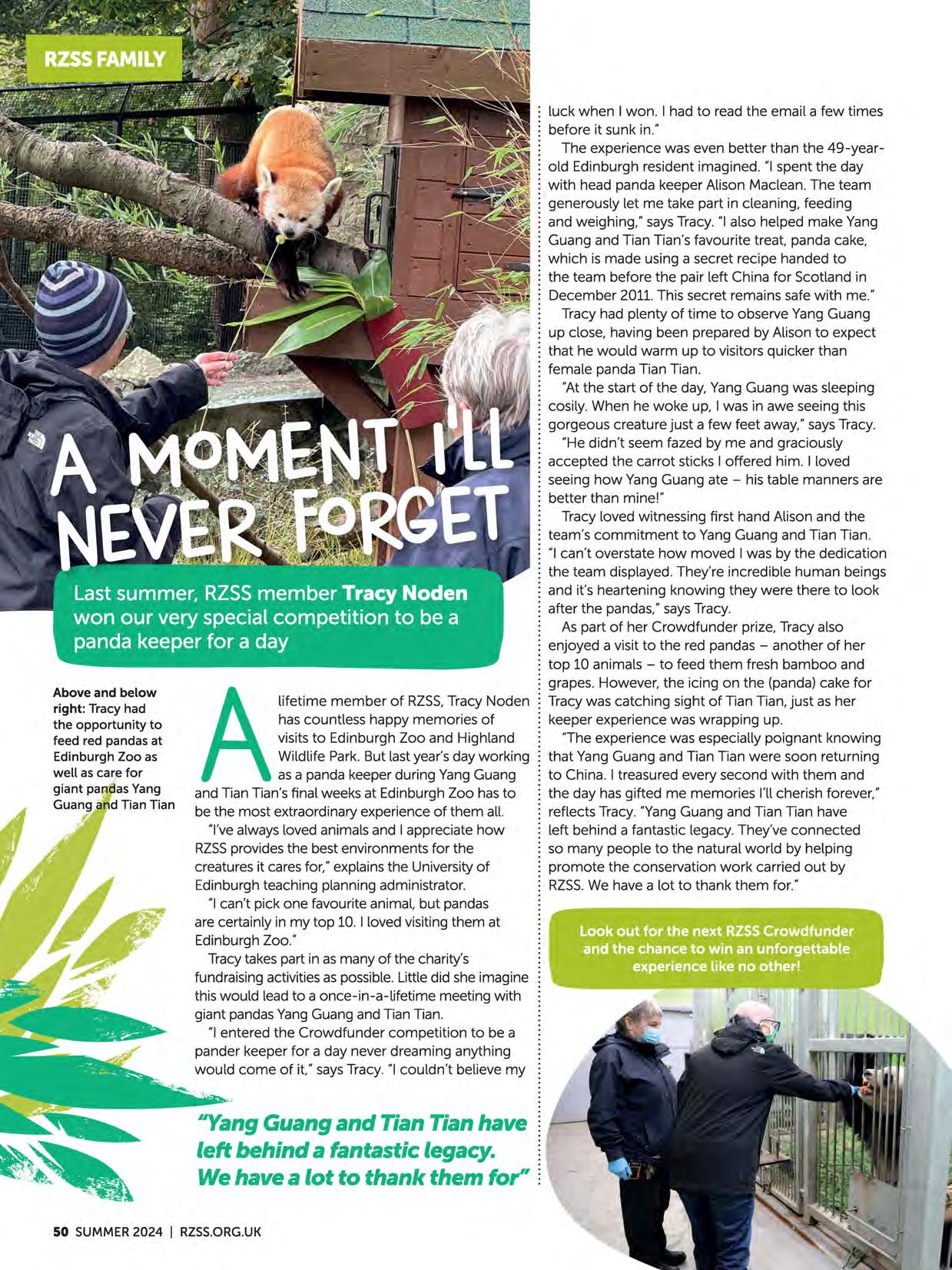
1 Yang Guang and Tian Tian have left behind a fantastic legacy. We have a lot to thank them for 1
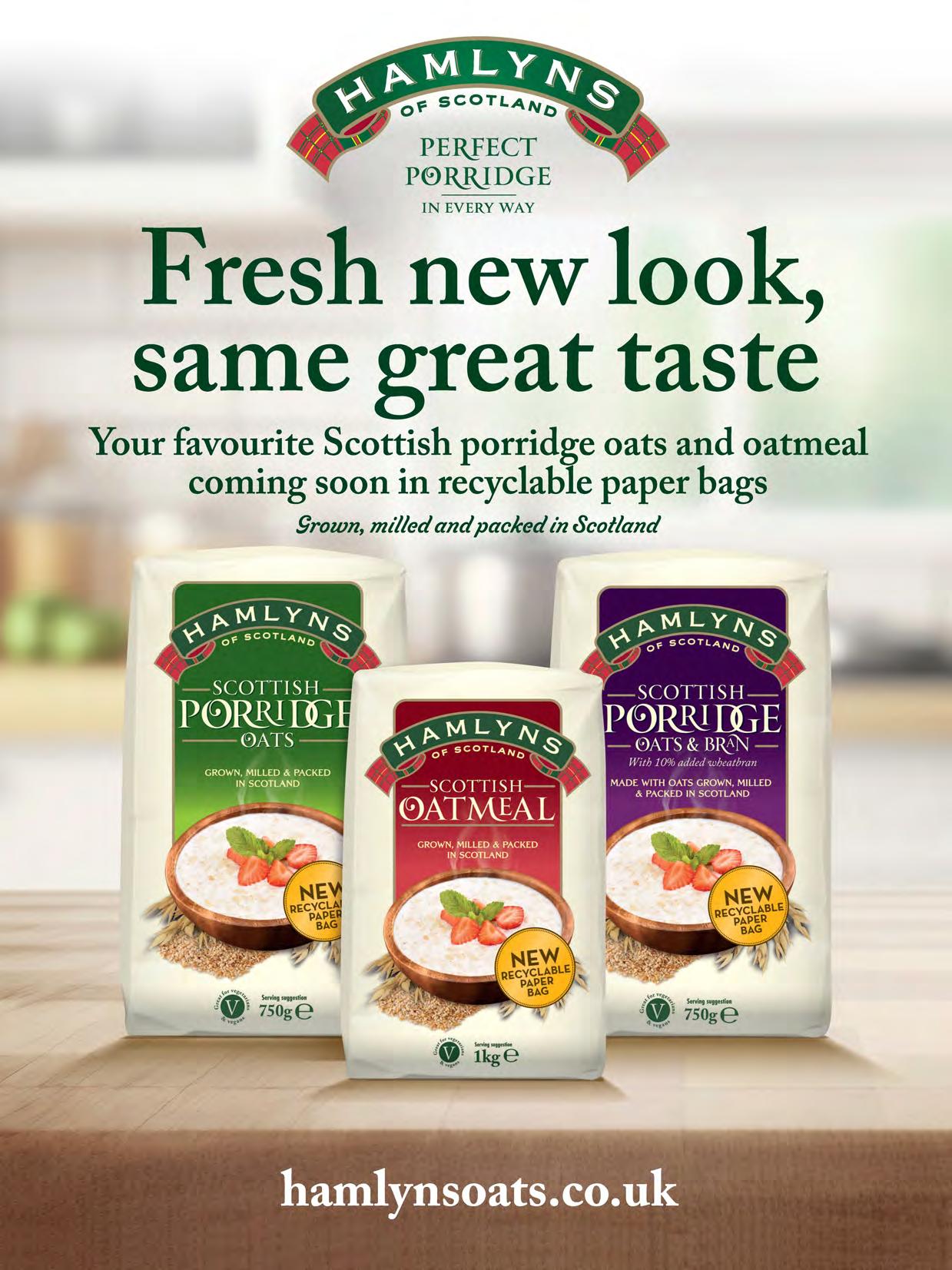
PER.fECT
P0R.__IUDGE IN EVERY WAY
Your favourite Scottish porridge oats and oatmeal coming soon in recyclable paper bags
9rown, milled and packed in 8cotland
